

Cruise Ship Anchors – How Big Are They? (and More)
Have you ever wondered if modern cruise ships have anchors and if so, where are they stored, and how big are they?
Modern cruise ships have what’s known as a stockless or patent anchor . This type of anchor is suitable for a wide range of different sea bed types, which cruise ships need as they travel through different waters and varying ports.
They are called stockless anchors because they don’t have a horizontal stock across the top of the shank.

Do Cruise Ships Have Anchors?
Like most ships, cruise ships have anchors. Anchors are required for holding a ship in place and preventing it from drifting due to winds and currents.
Anchors come in various shapes and sizes. Cruise ships have stockless anchors. This is a design of anchor that has particularly heavy flukes which are connected to a shank. These heavy flukes can dig into the seabed.
Do Cruise Ships Have More Than One Anchor?
Most cruise ships have two anchors, one port side and one starboard side at the front of the ship , although they are not often deployed at the same time.
One anchor is sufficient to keep a ship in position, although two can have their uses in specific circumstances.
Having two anchors means there’s always a backup should one ever be required. There is a lot of machinery and chain involved in the anchoring process and if any were to become damaged or required maintenance the other anchor could be used.
How Big Is A Cruise Ship Anchor?
Cruise ship anchors can be up 15ft to 20ft in height and 10ft to 15ft wide. Anchors are generally proportional to the size of the cruise ship. The larger and heavier the cruise ship, the larger the anchor can be expected to be.
The largest oasis-class Royal Caribbean cruise ships are some of the largest in-service ships sailing today and can be expected to have the largest anchors on any cruise ships.
The new Royal Caribbean icon-class cruise ships will be larger still and so will the anchors.
How Much Does A Cruise Ship Anchor Weigh?
Cruise ship anchors are somewhat proportional to the size of the ship. The larger the ship, the larger the anchor. A typical cruise ship anchor can weigh 10 to 15 U.S tonnes (9000 to 13600 kilos).
However, the weight of the chains is far heavier and much more of a factor in holding a ship’s position when it’s anchored offshore.
It’s the weight of the chain that holds the ship’s position, while the anchor acts to hold the end of the chain, preventing it from being pulled along the seafloor.
Ship Anchor Compared To Human
Cruise ship anchors can be 2 to 3 times an average human height of 5ft 9inches.
Assuming an average human weight of 80kg, an anchor weighing 10000 to 13500 kilos would be 125 to 168 times heavier.
In the photo below, you can see a human and cruise ship anchor comparison. Two maintenance workers underneath the anchor of Norwegian Cruise Line’s ship Norwegian Jewel , which was raised for maintenance.
In our post about the bottom of a cruise ship , we highlight a video clip of an anchor being freshly painted, and you can see it is about three times the height of the man doing the painting.
How Long Are Cruise Ship Anchor Chains?
The weight of anchor chains plays an important role in holding a cruise ship in position, much more so than the weight of the anchor itself.
When an anchor digs into the seabed, there must also be a sufficient length of anchor chain also lying on the sea bed. This provides extra weight and slack to the chain, which can absorb forces from the ship’s movement.
When a ship is properly anchored, the amount of anchor chain released should be 5 to 7 times longer than the depth of the water.
If the water depth was 50 ft (15m) the anchor chain released would need to be 250ft to 300ft (75m to 105m).
The anchor chain lies horizontally from the ship to the embedded anchor. Much of it is flat on the bed of the water.
The ship will not be sitting directly above the anchor but rather drawn away from it by wind and water currents.
Each individual link on the anchor chain weighs a considerable amount in its own right. This weight of the chain causes it to sag into a curved shape from the anchor chain on the sea bed up towards the ship. This is referred to as a catenary, a flexible hanging chain.
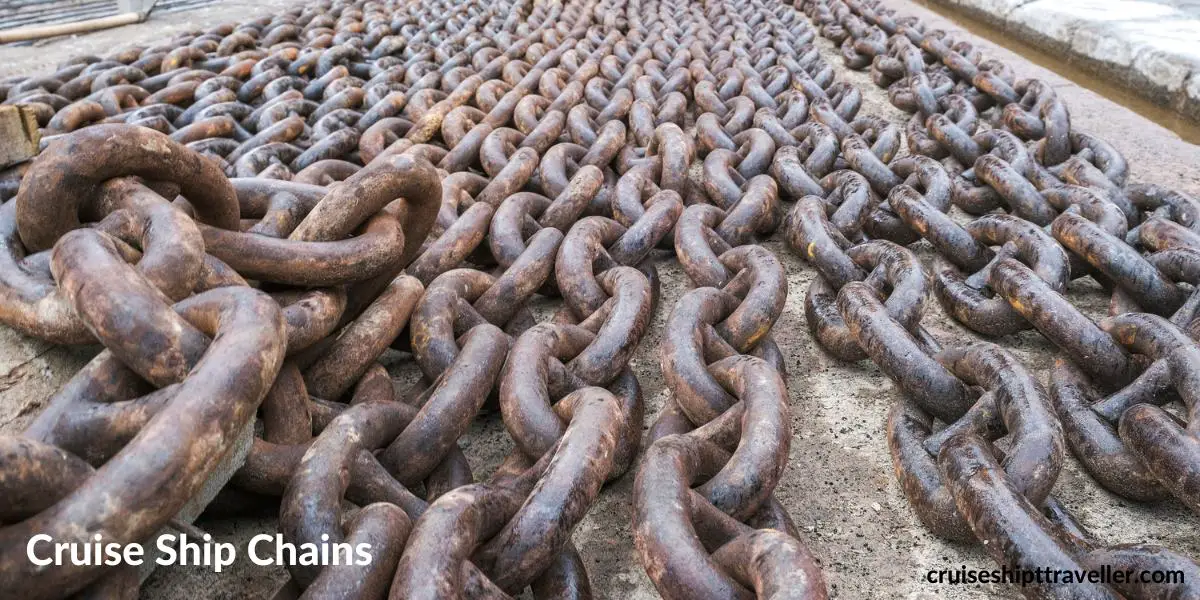
Markings on Anchor Chain
To indicate the length of the anchor chain released are markings on the actual chain, individual chain links of a different color, usually a red shackle, and white links on either side.
These markings indicate every 90ft (27.4m) of chain released.
The way it works is for every 90ft extra links, and either side of the red shackle will be painted white.
For example, a 360ft chain would be indicated with four links painted which either side of the red shackle (4 x 90ft = 360ft).
When do Cruise Ships Use Anchors?
If the draft of a cruise ship is too deep for a shallow port and waters, this prevents the cruise ship from docking. The cruise ship will have to anchor offshore in deeper waters, and passengers will have to be tendered to port.
Reasons a cruise ship might need to anchor include:
- Port waters too shallow
- Waiting to berth (park)
- Holding position during a storm
- Waiting for port channels to clear
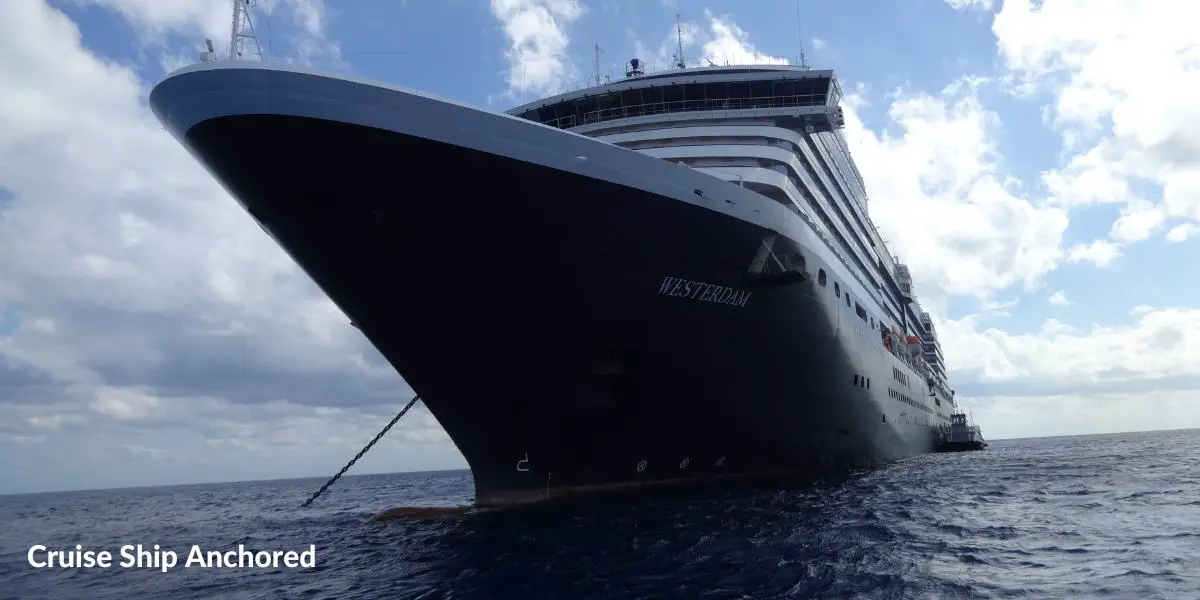
How Does A Ship Anchor Work
An anchor can be dropped in one of two ways.
- Engage in gear and walk back at desired pace or drop released for faster
- Release manual break for emergency release
The manual brake can be released in an emergency to release the anchor as quickly as possible.
When the anchor hits the seabed, the bridge crew will use the bow thrusters to maneuver the ship, causing the flukes of the anchor to dig in to the seabed.
With large cruise ships, it’s not so much the size and weight of the anchor that holds it in place, it’s more the total weight of the chain .
The anchor holds the end of the chain in position while much of the chain lays along the seabed before rising up to the cruise ship when forces such as wind are applied.
If there is no pull on the chain, and it’s slack, then there is no weight on the chain.
As the cruise ship moves, the chain’s slack changes when it’s slowly stretched and becomes taunter.
Depending on the stage of slack it will be referred to as:
- Lightweight
- Medium weight
- Heavyweight
At medium weight, the ship will have moved away from the anchor, and some of the chain will have been lifted from the seabed.
When the chain is deemed heavyweight, there is no slack in the chain. At this point, the anchor is acting to keep one end of the chain in position.
As a ship moves away from the anchor, the anchor chain gently extends as some chain is lifted from the seabed, absorbing some of the force that’s moving the ship. The force is not directly transferred to the anchor.
Whenever the forces subside, the chain slackens, and some of it falls back on the seabed as the ship eases back toward the anchor.
This is why anchor chains are so long. The longer the chain, the more force it can take before breaking the anchor free of the seabed.
If ships had short anchor chains that were just long enough for the anchor to bed down with a much shorter and tight chain, as soon as any excessive force is applied to moving the ship, it would be applied directly to the anchor, possibly causing it to break free.
Cruise Ship Dropping Anchor
To understand how a cruise ship works, we found this video which shows the Princess Cruise vessel, the Coral-class Island Princess cruise ship dropping an anchor .
To give you an idea of scale Island Princess is a mid-sized cruise ship, 91,627 gross tonnes with a capacity for 2200+ passengers and 900 crew.
Some of the biggest cruise ships are 2 to 2.5 times bigger, and the anchor and chains would be proportionally larger too.
Island Princess Dropping Anchor
The video shows:
- 0.40 – Anchor lowered to water level
- 1.05 – Port side windlass
- 2.05 – Anchor starts dropping
- 4.03 – Brought up to a port anchor of 5 and a quarter in the water.
Do Modern Cruise Ships Need Anchors?
While cruise ships, in theory, can use the dynamic position system that utilizes a combination of computer technology and GPS and to automatically control the propellors and bow thrusters, keeping the ship in the desired position by acting against the forces of the sea and winds.
Although this would involve keeping the ship’s engine running, using lots of fuel and keeping the crew busy overseeing it all.
An anchor is a much more efficient process, including much less fuel.
More importantly, a cruise ship can always use an anchor in the event of a loss of power, which, in some situations, could be vital.
Basic Anchor Terms:
- Anchor aweigh – means to take up the anchor from the waters bed
- Bed down – anchor on the seabed
- Bosun – operates the windlass and anchor
- Brought up -when the ship’s way has stopped and is riding to her anchor. There’s an equilibrium between the weight and forces on the ship and the weight of the anchor cable.
- Forecastle raised deck front part of the ship
- Flukes – projection of anchor that digs into the seabed
- Hawse pipe -where the anchor is stored
- Heave – a strong pull
- Rode – anchor chain
- Windlass – a type of winch used especially on ships to hoist anchors
Frequently Asked Questions
What’s the largest anchor in the world.
The biggest anchor in the world belongs to the largest ship in service, Pioneering Spirit . The ship has a gross tonnage of 403,342 far greater than the next largest ships by gross tonnage .
One of the largest anchors in the world now on land is that of the Seawise Giant It is 36 tonnes and is on display at the Hong Kong Maritime Museum.
Why is Water Coming From A Ship Anchor?
When an anchor chain is lying on the seabed, it picks up all sorts of debris and mud, which must be cleaned to prevent the chains from seizing up.
The anchor chain is heaved up through the hawsepipe at the bow of the ship , while at the same clean, powerful jet sprays within the hawsepipe clean the anchor chain.
What Happens if an Anchor Gets Stuck?
If an anchor became stuck in the seabed, such as being caught on a rock, the cruise captain would try to maneuver the ship in various ways to try and break it free.
As a last resort, the anchor chains would have to be cut, leaving the anchor on the seabed. Rather than lose the anchor, a buoy could be attached to the last piece of the chain so it could be recovered later.
What Would Happen if a Cruise Ship Lost its Anchor?
There are usually two anchors on a cruise ship, one on the port side and one on the starboard side. If one was lost, the other could be used.
We have this post if you need ways to remember port and starboard side .
If all anchors were lost, the ship would have to use propulsion and bow thrusters to maintain position.
If power was also lost, the ship would be at the mercy of the forces of wind and waves, which would cause it to drift. In this instance, the captain would have to call for assistance.
Do Cruise Ship Anchors Touch The Ocean Floor?
Cruise ship anchors need to reach the floor of the seabed. More than that, they need to dig into the seabed to maintain a grip and have enough chain links to be laying on the seabed to absorb any weight-pulling forces.
Can a Cruise Ship Anchor in the Middle of the Ocean?
Cruise ships can only anchor in seas where the anchor can comfortably reach the bottom of the sea bed and still have enough chains left to lay on the seabed.
If the cruise chain is too taunt, any pressure moving the ship would put too much pressure on the anchor and possibly break it free from the seabed.
There are ocean depths that cruise ship anchors cannot reach. This is because they are primarily designed for anchoring in shallower coastal waters. Excess anchor rode is not on board because it takes up too much space and is rarely required.
If the anchor cannot reach the seabed, it is serving no purpose and is simply a weight dangling from the ship into the sea.
How Much Does A Cruise Ship Anchor Cost?
The cost of an anchor mostly depends on its size and weight.
There are also the logistics of transporting such a heavy item and the additional costs of installing the anchor.
As ship anchors are not commercially available for sale, it isn’t easy to estimate a price, but for a large cruise ship anchor on its own without a chain, it could be expected to cost a six-figure sum.
Related Posts

What is the Draft of a Cruise Ship? (and Why Does it Matter?)

How Many Doors on a Cruise Ship? (Yes, I Counted)
Leave a comment cancel reply.
Your email address will not be published. Required fields are marked *
Save my name, email, and website in this browser for the next time I comment.
Cruise Ship Anchors: Everything You Need to Know
Disclosure: This post may contain affiliate links. We may receive compensation when you purchase via my links at no cost to you. See my disclosure for more information.
Today’s massive cruise ships are some of the most technologically advanced vehicles on the planet. Yet, they still use the ancient invention, anchors.
You’d think that an invention dating back to 592 BC is out of the window, but anchors still play an essential role for cruise ships.
This article will show you everything you need to know about cruise ship anchors. We’ll compare them to the modern ship stabilizing thrusters, and we’ll also compare the size and weight of one of the most famous ships in the world.
Table of Contents
Cruise Ship Anchors
Cruise ships use anchors to hold the ship in place. Cruise ship anchors are commonly used in tender ports, where the ship cannot moor to a land-based dock.
The first known use of ship anchors dates back to Ancient Greece, around 592 BC.
Despite advances in technology, cruise ship anchors remain essential in ship construction.
Modern ships have advanced positioning systems that keep them in place using engines and thrusters. This allows ships to remain in place without drifting.
The technology uses GPS and the cruise ship’s engines to keep the vessel stationary and counter the ocean currents and waves.
Dynamic positioning systems are commonly used when ships must remain in deep water , where an anchor may not be long enough. While the chain length limits the use of anchors, the dynamic positioning systems don’t have any limitations. They can be used in water of any depth and are often used to keep ships positioned in the deep ocean.
They also pose less risk to coral reefs, where an anchor might disturb the reef.
Despite the advantages of dynamic positioning systems, the new technology doesn’t eliminate the need for anchors.
Ship stabilizing thrusters consume fuel and are liable to malfunction and damage. While they don’t impact coral reefs like the anchor, burning fuel has its own environmental impact.
On the other hand, anchors are much more economical when keeping the ship in place since they consume no fuel.
How Do Cruise Ship Anchors Work?

Cruise ship anchors work by extending down to the seabed of shallow water and using their weight to hold the ship in position.
Anchors rest against the sea bed and utilize their heavy weight to keep the ship stationary. They counter the effect of currents and waves, holding the ship in its position.
Utilizing the sea bed is why cruise ships can’t rely on anchors in deep or open water. These anchors’ chains have a limited length; if the anchor can’t reach the sea bed, it can’t perform its function.
How Big Are Cruise Ship Anchors?

Cruise ship anchors range between 10–20 feet long and average 8–15 feet wide. An anchor’s size is directly proportional to the size of the vessel.
Larger and heavier ships require larger and heavier anchors.
The Titanic had an 18 foot 6 inches long main anchor, and it was the largest anchor made at the time.
Let’s not forget about the chains that hold these anchors. These chains have various lengths and thicknesses. The chains’ length depends on the anchor they’re supposed to carry, and the thickness depends on the ship they’re supposed to hold.
How Heavy Are Cruise Ship Anchors?

The average weight of cruise ship anchors ranges between 10–20 US tons . The weight can go considerably higher to accommodate the largest ships. However, it’s unlikely to go lower because it would be difficult for it to stabilize a ship with a lower weight.
The Titanic had an anchor that weighed around 16 US tons. Even back then, that was mighty impressive.
Despite the anchor’s weight, it merely acts as a point of contact with the seabed. The anchor’s chain is far heavier and vital in keeping the ship stationary.
Anchor Chains
Nautical engineers use various methods to calculate the chain length. Generally, heavier anchors require heavier chains.
The weight of the chain helps hold the cruise ship in place.
Longer chains can withstand more movement, unlike short chains, which can cause the anchor to lose contact with the seabed during rough seas.
When an anchor is lowered into the ocean, sufficient slack must be in the chain, which rests on the seabed. The slack provides a greater surface area of contact with the seabed, which absorbs more movement.
Here’s a sample table to show you the correlation between the lengths of chains based on their anchors’ weight.
Remember that we’ll use US tons, which are slightly lighter than metric tons. 1 US ton is around 907 kg.
Regarding thickness, there are three primary sizes of chains.
Smaller vessels use 1/4 inch thick chains, medium ships use 5/18 inch chains, and the biggest cruise ships use 3/8 inch chains.
How Many Anchors Do Cruise Ships Have?

Most modern cruise ships have two anchors, with one on the port side and the other on the ship’s starboard side.
Cruise ships occasionally use both anchors if the waters are rough or there’s a strong current. Most of the time, however, the cruise ship uses only one anchor and keeps the other one for backup.
Some larger cruise ships are equipped with a third backup anchor . The third anchor is often smaller and weighs less than the primary two anchors. It’s primarily used as a backup if one of the primary anchors breaks or malfunctions.
Can a Cruise Ship Stay Idle Without Anchors?

It’s unlikely for a modern cruise ship to lose its anchors. Many cruise ships also have two anchors. So, if one becomes unusable for some reason, the second will act as backup .
If, for some reason, the ship loses all functioning anchors; it can still rely on its thrusters to keep it stable.
In the improbable scenario that both the anchors and dynamic positioning systems also get damaged, the cruise ship will be at the mercy of the moving water as long as it’s not sailing.
In other words, the cruise ship could still get from point A to point B, but it won’t manage to stay idle without anchors or dynamic positioning systems.
The only solution would be to dock and have the issues repaired.
Do Cruise Ships Still Use Anchors?

Cruise ships generally avoid using the anchor due to the environmental impact on coral reefs and the seabed.
But dropping anchor also impacts guests.
Staterooms located near the ship’s bow are some of the worst on a cruise ship. One reason is the sound of the chain when the ship drops anchor.
Cruise ships often arrive at ports of call in the early morning. And no guest wants to be woken by what sounds like a freight train at 5 am while the ship drops anchor.
So what do cruise ships do instead?
Some cruise ports, such as Labedee, Haiti, offer fixed mooring points . The mooring points allow ships to remain stationary at sea within a reasonable distance of the port. This allows the vessel to remain idle without using the anchor.
If no fixed mooring points are available, some cruise lines will opt to use dynamic positioning systems to keep the ship idle using the ship’s engines . The bridge simply inputs the coordinates, and the system takes care of the rest.
But, dynamic positioning systems come at a cost .
They require significant amounts of fuel to power the engines. Not only are fuel costs a primary consideration for cruise lines, but they also impact the environment.
Some cruise ports have local laws prohibiting the use of anchors to protect coral reefs. But if there are no laws regarding anchors, it’s up to the captain to decide whether to use the dynamic positioning system or drop anchor.
Below is a visible of the cruise ship Island Princess dropping anchor.

Final Thoughts

Cruise ships are built with impressive engineering and enriched with fantastic technology, but they’re still humble enough to remain loyal to their anchors.
Anchors excel in stabilizing large cruise ships in shallow waters as long as they’re heavy enough to do the job. They’re also a great backup solution if modern positioning systems cease to function for any reason.
However, anchors can only work if their chains are long enough for them to reach the seabed, rendering them useless in open water.
Marcello De Lio
Leave a Reply Cancel Reply
Your email address will not be published. Required fields are marked *
Name *
Email *
Add Comment *
Save my name, email, and website in this browser for the next time I comment.
Post Comment
This site uses Akismet to reduce spam. Learn how your comment data is processed .
Trending now


Cruise Ship Anchors: What You Need to Know
Cruise Ship Anchors: Some of the world’s most technologically advanced automobiles are the enormous cruise ships of today. However, they continue to use the antiquated anchor invention.
You would think that an idea that dates back to 592 BC would be obsolete, but cruise ships still depend heavily on anchors.
You will learn all there is to know about cruise ship anchors from this article. In addition to contrasting them with contemporary ship stabilizing thrusters, we’ll also weigh and dimension one of the most well-known ships in history.
Cruise Ship Anchors
As passengers tender into the port of call, Princess Cruises’ cruise ship is anchored in the Caribbean. Anchors are used by cruise ships to keep them stationary. In tender ports, where the ship is unable to moor to a land-based dock, cruise ship anchors are frequently utilized.
Ship anchors were originally used, as far as is known, in Ancient Greece in 592 BC.
Cruise ship anchors are still a crucial component of ship construction, even with technological advancements.
With the use of thrusters and engines, modern ships maintain their position thanks to sophisticated positioning systems. As a result, ships can stay still and not wander.
Utilizing GPS and the cruise ship’s engines, the system maintains the ship’s motion while fending off waves and currents in the water.
In situations where ships must stay in deep water and an anchor might not be long enough, dynamic positioning devices are frequently utilized. The chain’s length limits the use of anchors; however, dynamic positioning systems are unrestricted. They are frequently employed to maintain a ship’s position in the deep ocean and can be utilized in any depth of water.
Additionally, they lessen the possibility of an anchor disturbing coral reefs.
Even with dynamic positioning systems’ benefits, anchors are still necessary in this modern world.
Ship-stabilizing thrusters use fuel, which can also malfunction or sustain damage. Burning fuel influences the ecosystem even though it doesn’t affect coral reefs like the anchor does.
However, because they don’t use any fuel, anchors are far more cost-effective for keeping the ship stationary.
Cruise Ship Pilot: What is their Role and Responsibility?
How Do Anchors on Cruise Ships Operate?
In order to keep the ship in place, cruise ship anchors extend down to the shallow seafloor and use their weight.
Anchors use their substantial weight to keep the ship motionless while they rest against the ocean floor. They maintain the ship’s position by opposing the effects of waves and currents.
Cruise ships cannot rely on anchors in deep or open water because they must use the sea bed. The chains on these anchors have a finite length; the anchor cannot work if it is not able to reach the sea bed.
How Big Are Anchors on Cruise Ships?

Chris Allen’s replica of the Titanic’s anchor, available on Wikimedia Commons under CC BY-SA 2.0 The normal size of a cruise ship anchor is 8 to 15 feet wide, with a length of 10 to 20 feet. The size of an anchor is closely correlated with the size of the vessel.
Larger and heavier ships need anchors that are also larger and heavier.
The main anchor aboard the Titanic was the longest anchor ever manufactured at the time, measuring eighteen feet and six inches.
Remembering the chains that secure these anchors is important. The thicknesses and lengths of these chains vary. The thickness of the chains and the anchor they are intended to hold determine their length and thickness, respectively.
How Heavy Are the Anchors on Cruise Ships?
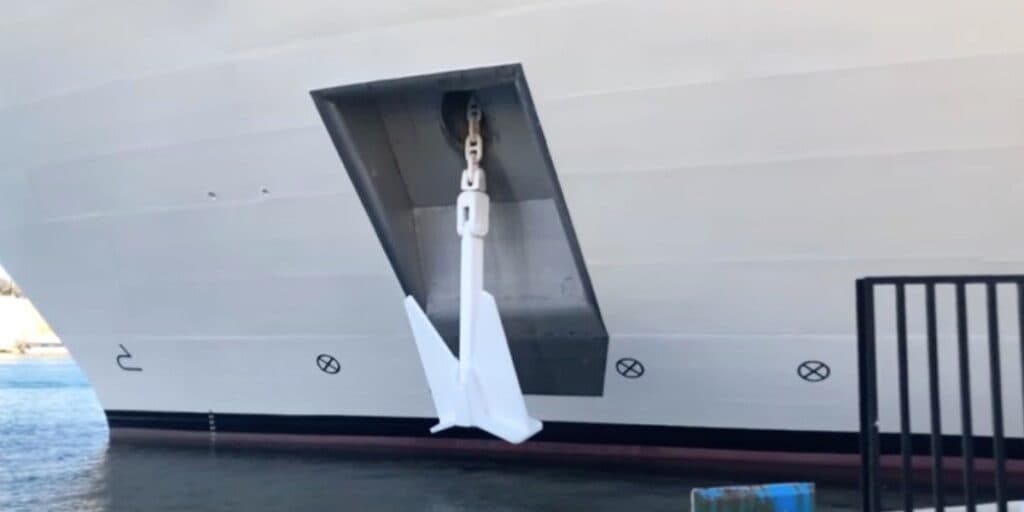
Cruise ship anchors typically weigh between ten and twenty US tons. The largest ships can be accommodated by significantly increasing the weight. It would be impossible for it to stabilize a ship with a lower weight, thus it is unlikely to go lower.
An anchor on the Titanic weighed about sixteen tons in US currency. That was really impressive even then.
The anchor serves only as a point of contact with the seafloor despite its weight. The chain of the anchor is much heavier and is essential to keeping the ship motionless.
What is the cost of fueling a cruise ship?
Anchor Chains
To determine the chain length, nautical engineers use a variety of techniques. In general, larger chains are needed for heavier anchors.
The weight of the chain helps to keep the cruise ship in place.
In contrast to short chains, which may allow the anchor to lose contact with the seafloor in choppy conditions, longer chains can tolerate greater movement.
The chain, which rests on the seafloor, needs to have enough slack when an anchor is lowered into the water. More surface area of contact with the seafloor is made possible by the slack, which absorbs more movement.
This sample table illustrates the relationship between chain lengths and the weight of their anchors.
Keep in mind that US tons, which are somewhat lighter than metric tons, will be used. 907 kg is around one US ton.
There are three main sizes of chains in terms of thickness.
Large cruise ships utilize 3/8-inch thick chains, whereas smaller ships use 1/4-inch thick chains and medium-sized ships use 5/18-inch thick chains.
What is the number of anchors on a cruise ship?
Upon docking in Rhodes Island, Greece, the Costa Fascinosa displays two cruise ship anchors. The Costa Fascinosa displays two anchors. The majority of contemporary cruise ships feature two anchors: one on the starboard side and one on the port side.
On rare occasions, when there is a strong current or heavy seas, cruise ships will employ both anchors. However, the cruise ship often only utilizes one anchor, saving the other for emergency usage.
Larger cruise ships may have a third backup anchor installed. Usually lighter than the other two anchors, the third anchor is smaller. Its main purpose is to serve as a backup in case the main anchor fails or malfunctions.
Can an Anchored Cruise Ship Remain Idle?
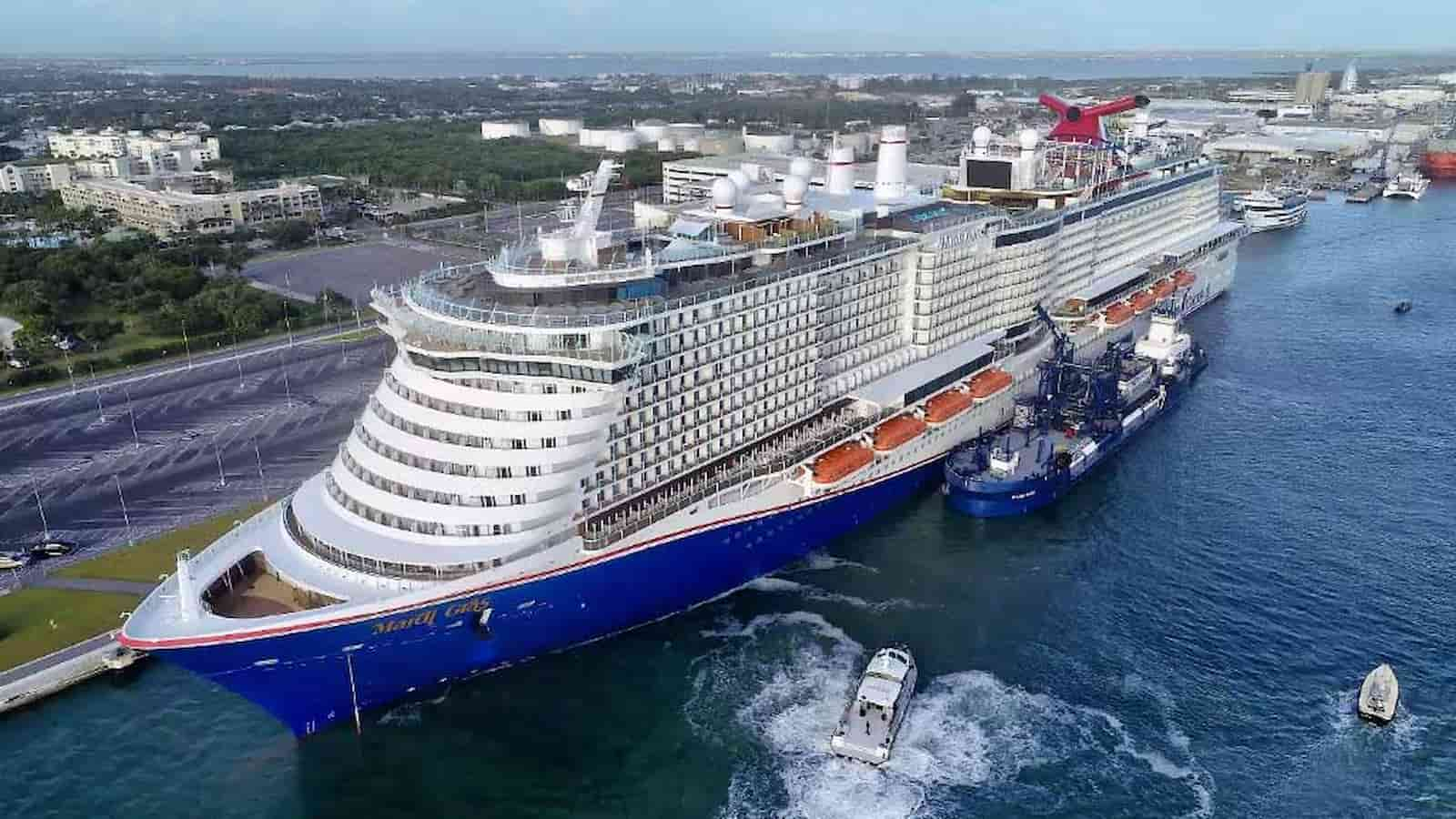
A contemporary cruise ship is not likely to lose its moorings. In addition, many cruise ships have two anchors. As a result, the second will serve as a backup in case the first breaks down for any reason.
The ship’s thrusters can keep it stable even if it loses all of its moorings for whatever reason.
The cruise ship will be at the mercy of the moving sea as long as it is not sailing, in the unlikely event that both the anchors and the dynamic positioning systems sustain damage.
Stated otherwise, the cruise ship could still get from point A to point B, but in the absence of anchors or dynamic positioning systems, it would not be able to remain still.
Docking would be the only way to get the problems fixed.
Are Anchors Still Used on Cruise Ships?
The anchor chain is visible, while Carnival Freedom is anchored off the coast of a Caribbean cruise port. Because anchoring has a negative environmental impact on the seabed and coral reefs, cruise ships usually avoid utilizing it.
The falling anchor, however, also has an impact on the visitors.
On a cruise ship, the staterooms closest to the bow are among the worst. The sound of the chain dropping anchor is one of the causes.
Early morning is when cruise ships typically dock at places of call. Furthermore, nobody wants to wake up at five in the morning to the sound of a freight train as the ship drops anchor.
What then, do cruise ships do differently? Fixed mooring places are available at certain cruise ports, such as Labedee, Haiti. Ships can stay still at sea as long as they are moored within a reasonable distance of the port. As a result, the ship can continue to move without deploying the anchor.
Some cruise lines choose to use dynamic positioning systems, which use the ship’s engines to keep the ship idle, if there are no fixed mooring locations available. All the bridge has to do is enter the coordinates; the system handles the rest.
However, there is a price for dynamic positioning systems.
To keep the engines running, they need a lot of gasoline. Cruise companies not only prioritize fuel expenses, but they also have an environmental impact.
Local rules in several cruise ports forbid using anchors to save coral reefs. The captain must choose whether to drop anchor or employ the dynamic positioning system if there are no regulations on anchors.
Related Posts
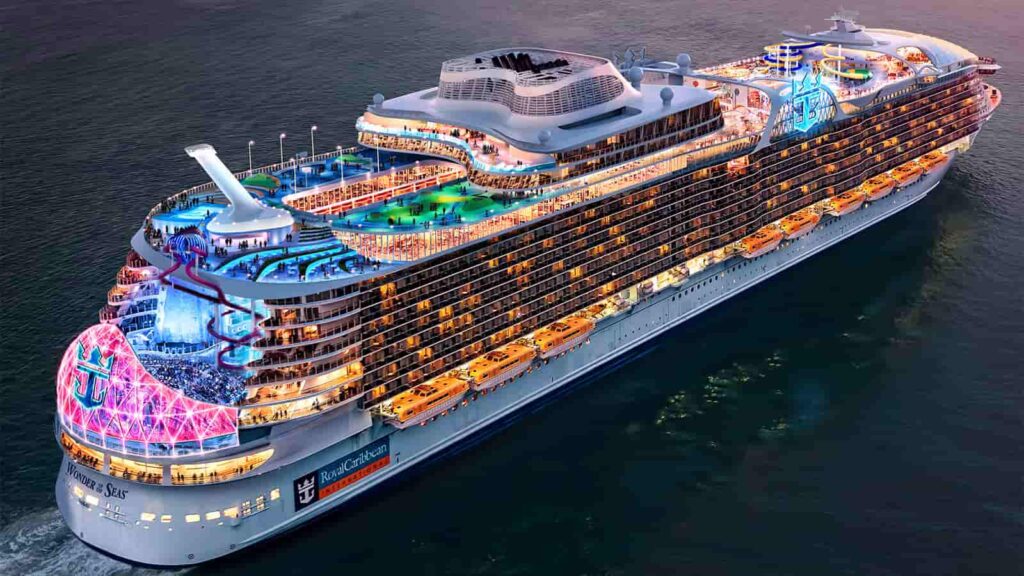
Royal Caribbean Cruises, History, Destinations and Itineraries

Ambassador Cruise Line: Ownership and History
Leave a comment cancel reply.
Your email address will not be published. Required fields are marked *
Save my name, email, and website in this browser for the next time I comment.
- New Sailboats
- Sailboats 21-30ft
- Sailboats 31-35ft
- Sailboats 36-40ft
- Sailboats Over 40ft
- Sailboats Under 21feet
- used_sailboats
- Apps and Computer Programs
- Communications
- Fishfinders
- Handheld Electronics
- Plotters MFDS Rradar
- Wind, Speed & Depth Instruments
- Anchoring Mooring
- Running Rigging
- Sails Canvas
- Standing Rigging
- Diesel Engines
- Off Grid Energy
- Cleaning Waxing
- DIY Projects
- Repair, Tools & Materials
- Spare Parts
- Tools & Gadgets
- Cabin Comfort
- Ventilation
- Footwear Apparel
- Foul Weather Gear
- Mailport & PS Advisor
- Inside Practical Sailor Blog
- Activate My Web Access
- Reset Password
- Customer Service

- Free Newsletter

How to Perform Your Own Pre-Buy Inspection
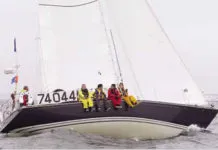
C&C 40 Used Boat Review
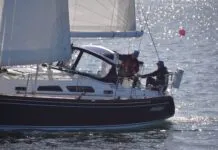
Sabre 386 Used Boat Review
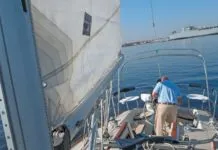
What You Can Learn on a Quick Test Sail

Preparing Yourself for Solo Sailing

Your New Feature-Packed VHF Radio

Preparing A Boat to Sail Solo

Solar Panels: Go Rigid If You have the Space…

Ground Tackle Inspection Tips

Shoe Goo II Excels for Quick Sail Repairs

When Should We Retire Dyneema Stays and Running Rigging?

Rethinking MOB Prevention

An Unusual Sailboat Shines a Light On A Sustainable Future

Is It Time to Get an Electric Dinghy Motor?

Worship Your Universal M-Series Diesel With the Marinized Kubota Block

Taking Care of Your 12-Volt Lead-Acid Battery Bank

Battle of the Teak Cleaners — Snappy Teak-Nu vs. Star Brite

New Seacocks for the Offshore Sailor

Bottom Paint Care

Quick and Safe Sail Cleaning

Are E-bikes Worth the Extra Weight and Cost?

How to Handle the Head

The Day Sailor’s First-Aid Kit

How to Select Crew for a Passage or Delivery

Re-sealing the Seams on Waterproof Fabrics

Waxing and Polishing Your Boat

Reducing Engine Room Noise

Tricks and Tips to Forming Do-it-yourself Rigging Terminals

Marine Toilet Maintenance Tips

Learning to Live with Plastic Boat Bits
- Sails, Rigging & Deck Gear
Selecting the Right Anchor Size
Holding power increases with weight, but how much is hard to calculate..
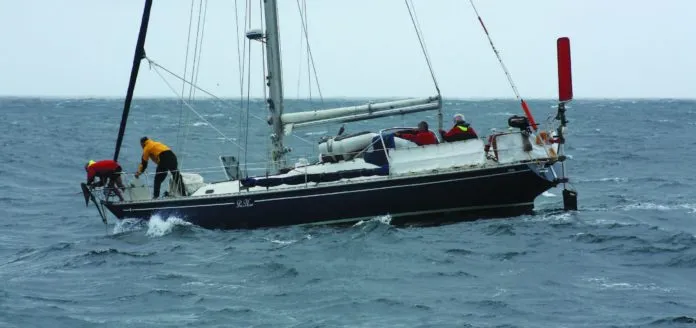
Over the years Practical Sailor has conducted dozens of anchor tests, and like many publications, we’ve repeated the common guidance that cruising sailors should buy an anchor that is at least one size larger than what the maker recommends for your size vessel.
During the last two decades, however, the tremendous holding power of some newer generation anchors have caused us to re-think this guidance. Are we paying more for an anchor, rode, and the requisite anchor handling equipment than we need? How accurate are the makers size recommendations? How much insurance are we really getting for the price of a bigger anchor?
For this report we took a range of modern, sometimes called new generation anchors, and their predecessors and averaged their weight vs. vessel size recommendations (see accompanying table). Much to our surprise, the weight recommendations for the new designs, Rocna, Excel, Supreme, etc. are very similar to the weight recommendation for the older, traditional models, CQR, Delta, Bruce etc. In both cases, the recommendation for a 35-foot yacht is approximately a 30-pound anchor. The exceptions are aluminum anchors from Fortress and Spade.
Most of the new generation anchors have been tested to international standards established by the RINA (Registro Italian Naval) or some other internationally recognized society. Rocna, Fortress, Supreme, Excel, Spade have been found to meet standards of Super High Holding Power, SHHP. The older anchors, CQR, Bruce, Delta are rated as High Holding Power. The difference between the two categories is that the SHHP have been tested and found to have a hold, comparing anchors of the same weight, that is two times that of the HHP anchors.
So if we’re getting double the holding power, does that mean we can use an anchor that is half the weight? Not necessarily. Nor can you expect another doubling of holding power by doubling the weight of an SHHP anchor.
Despite the sales pitch that the new anchors have greater holding capacity pound-for-pound, the anchor makers are suggesting that you replace your old CQR with the same weight new anchor. It appears that manufacturers are, in effect, doubling the historic safety factor. And for a cautious sailor, there is nothing wrong with this.
However, consider the advice that is often repeated on internet forums, or the local scuttlebutt, that cruising sailors should increase one size over the makers recommendation. So instead of a 33-pound Rocna for your Tartan 37, you buy a 44-pound Rocna-now with potentially three times the safety factor of an old school anchor. Apart from the added significant expense, this obsession with upsizing – more anchor, more chain, bigger windlass-can also add potentially unnecessary weight and concentrate it in the bow.
So what do we really get with that bigger anchor? There is an idea that if you double weight of an anchor you will double holding power. Except with extra-large commercial anchors and some specific tests, we’ve found no data to support this.
No independent test, as far as we know, has taken a series of different sized anchors of the same design and tested them in the same seabed for ultimate holding capacity. Tests have been conducted on commercial oil rig anchors like the Bruce, and the best scaling is about 90 percent-double weight and you increase hold by 1.8 times.
The only recreational anchor that we are aware of that has undergone some testing to determine the relationship between weight and holding is Fortress (in mud only, see Anchoring in Squishy Bottoms, PS February 2015 ). An analysis of all their tests on a complete range of their anchor sizes suggest that if you triple weight you increase hold by slightly more than two times, approximately an 80 percent efficiency as size is scaled up.
Ultimately, this means that when someone tells you they can calculate the increase in holding power as you move up in size, be careful not to read too much into this conclusion. For one, the ratio used deserves close scrutiny. Surely, the bigger anchor will provide better holding-but how much? This hard to quantify, even with computer modeling. And no matter how accurate your calculation-a ratio based on performance in one type of bottom might not apply in another.
One reason you can’t claim that doubling the weight doubles the holding is that as anchors increase in size, the stress on the construction increases. To compensate for the increase in stress, the steel thicknesses must be increased – and more steel weighs more. So in an anchor whose holding power relies greatly on surface area and how it is distributed, adding more weight doesn’t necessarily result in a commensurate increase in surface area that provides holding power.
And as we’ve shown in our past tests-anchor dimensions (especially the fluke area) and shape can play a significant role in performance. It might be possible to double weight and double the holding power without beefing up the steel, but the resulting anchor would be less strong relative to its designed holding power.
Weaker construction might not matter on an over-engineered anchor. However, we have seen how the use of inferior materials has resulted in anchors that bend more easily at designed loads (see Anchor Tests: Bending More Shanks, PS May 2013 ).
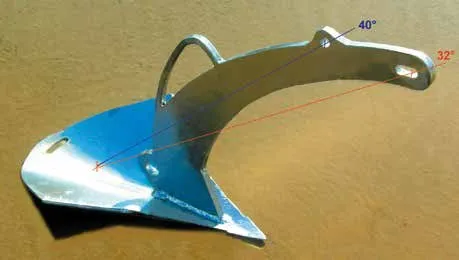
Anchor Angles
In past reports, we’ve discussed in detail how anchor design can impact holding, especially with the new generation anchors ( see An Inquiry into Anchor Angles, PS February 2017 ). As you consider which design best suits your needs, here are some things to consider.
Fluke/shank angle. The fluke/shank angle is the angle between fluke and shank. It is one of the determining factors in how quickly and deeply an anchor sets. For a simple design with flat plate fluke and a straight shank (like a Guardian) the angle is a line down the center of the shank to the hinge and then along the fluke. In shanks with curves or angles, the first line is usually drawn from the shackle pin to the point there the shank meets the fluke.
For three-dimensional flukes (as found in most new generation anchors), you have to estimate where the top of the fluke plate lies. The ballast chamber or shank support that might protrude from the sole, such as with Spade, or Vulcan anchor should not be used to determine shank/fluke angle.
It is the fluke top surface that is important. In previous tests we reported that in thin mud an anchor with a fluke angle of around 45 degrees will outperform an identical anchor with its fluke angle set at 30 degrees. But a firmer sand seabed is entirely different, and research demonstrates the ideal fluke angle for a typical sand bottom is around 30 degrees (see Small Anchor Reset Tests, PS February 2013 ).
Fluke-seabed angle. This is the angle of the fluke to the seabed during the phases of anchoring-most importantly, during the initial penetration into the bottom, and when the anchor is set.
Penetration angle. When an anchor is aligned ready to set, or engage with the seabed (it might need tension on the rode to achieve this) then the fluke will usually be at an angle of 60-70 degrees to the seabed. Commonly the anchor is on its side.
Setting angle. Once the anchor starts to penetrate it will self align and the fluke plate tend quickly toward its setting angle, usually of about 30 degrees. It is coincidence that the fluke/shank angle and setting angle are similar though most anchors tend to show the similarity of the two angles. Center of gravity can have a great effect on penetration angle. This is why many new generation anchors, like the Ultra, have weighted flukes. Having a 30-degree fluke/shank angle is irrelevant if the center of gravity is in the wrong place.
Shank length
If you imagine a Fortress with a shank/fluke angle of 30 degrees but a shank three times longer than its original design, then you can visualize how the anchor will probably simply slide along the seabed when tensioned. The throat opening will be too small. Similarly if you chop the shank in half, the toe of the anchor will simply scrape along the seabed. In both case the anchor will find difficulty in engaging because the penetration angle will be wrong.
Are the makers of new generation anchors over-stating the need for bigger anchors, thus requiring boat owners to pay much more than they might need in order to be secure at anchor? Possibly. Would going with a larger-than-required anchor actually hurt your anchors performance? Unlikely. As is often the case with our anchor reports, it is hard to come with some firm answers regarding both of these questions. Anchor studies are fraught with variables.
In our view, it is no crime to go up one size over the manufacturers recommended size, if your boat and crew can handle it. The anchor may require more reverse throttle to set, but ultimately, it should provide the holding you require. Likewise, it is reasonable to assume that the anchor makers guidance for sizing is reasonable. However, if an online advocate starts telling you that youll get x times more holding power by going up one size, ask him for the data.
Extra weight in an anchor is your insurance policy. Yes, you can almost always get more security with the heavier anchor, but whether or not you will every need that extra holding power is not conclusive. In our view, conservative sizing is added insurance-but until the data is in, we remain skeptical of any absolute claims that attempt to quantify the advantages of more weight when choosing an anchor.
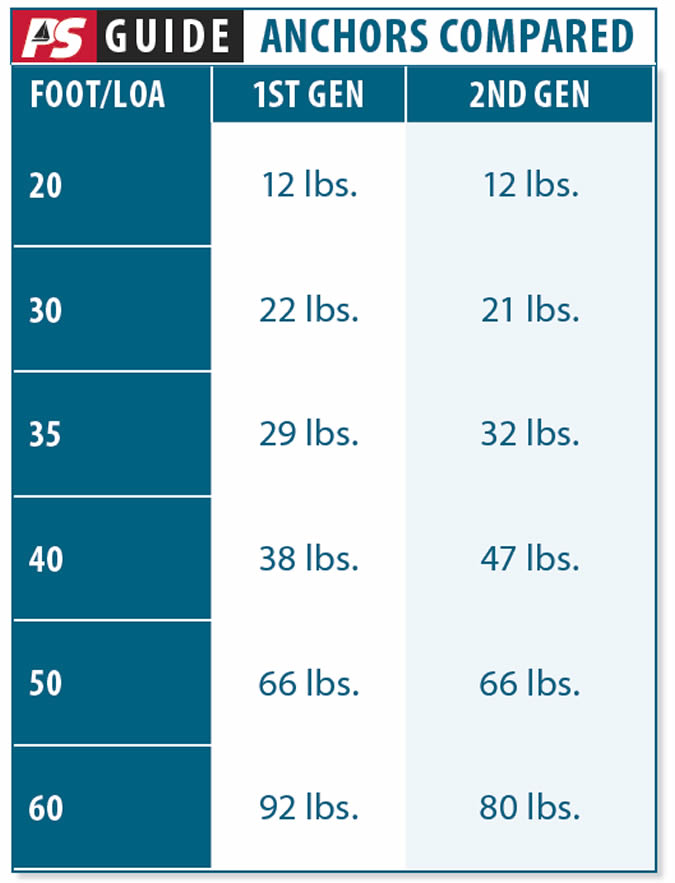
Based on average recommendations from leading anchor makers, the weight savings of upgrading to a second generation anchor doesn’t really pay off until you get into the larger size vessels.
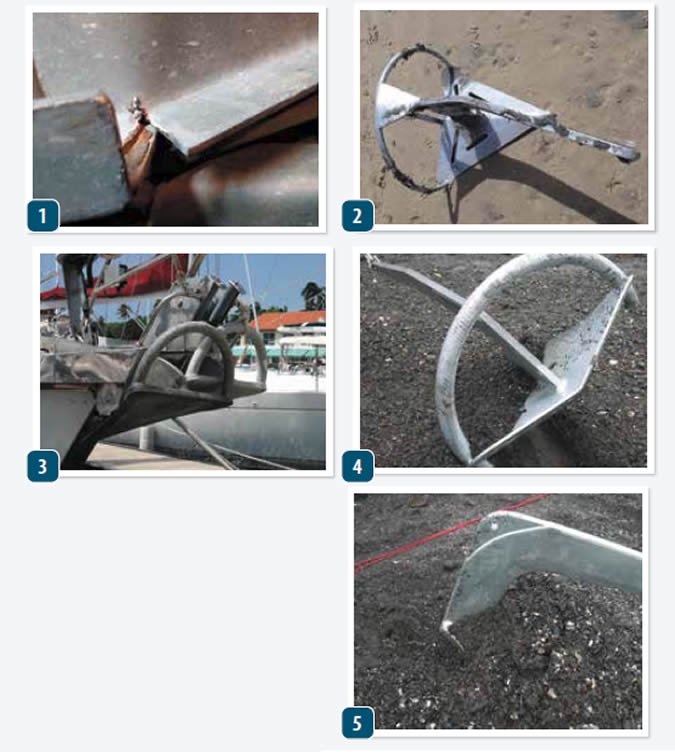
In an anchor whose holding power relies greatly on surface area and how it is distributed, adding more weight doesn’t necessarily result in a commensurate increase in surface area that provides holding power. To compensate for the higher loads, the steel must be thicker, resulting in different surface area/weight ratios.
- As fluke size increases, so do the loads. But if the construction isn’t beefed up to handle the loads, the result is failure. Flat plate steel in this Danforth fluke sheered.
- The shaft of an Excel anchor bent during veer testing.
- The flat flukes of the Bugel anchor makes it easy to calculate the shank-fluke angle.
- Here a Rocna anchor is in the initial setting angle, still capsized on one side, with not enough of its toe is dug into the soil to dig in. Bottom shape and center of gravity (some designs are weighted to control CG), helps to determine this angle.
- This Manson Ray anchor has rolled upright and assumed the angle of penetration that will help the anchor to bury into the bottom.
RELATED ARTICLES MORE FROM AUTHOR
Leave a reply cancel reply.
Log in to leave a comment
Latest Videos
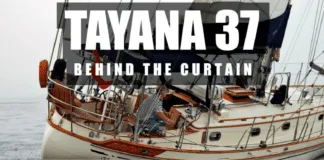
Tayana 37: What You Should Know | Boat Review

Monitor Your Whole Boat From Home On A Mobile App

Beneteau 423: What You Should Know | Boat Review

Buying A Sailboat Is Scary! Yacht Broker Interview
- Privacy Policy
- Do Not Sell My Personal Information
- Online Account Activation
- Privacy Manager

cruise ship anchors anchored in fjord

Enter your email address below:
- BOAT OF THE YEAR
- Newsletters
- Sailboat Reviews
- Boating Safety
- Sailing Totem
- Charter Resources
- Destinations
- Galley Recipes
- Living Aboard
- Sails and Rigging
- Maintenance

Understanding Anchor Chain
- By Steve D'Antonio
- Updated: October 2, 2019
All chain’s the same, right? Well, no. There’s actually a variety of types and grades of anchor chain that cruising sailors should know about. What follows is a primer on understanding anchor chain and how to use it properly.
Types of Anchor Chain
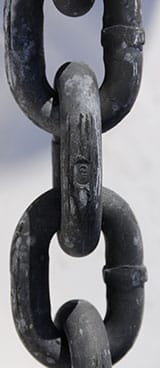
Your Chain Explained
The most popular varieties of galvanized-steel windlass chain include high-test or grade 40 (usually marked HT, G4, or HT4); triple B or grade 30 (marked as BBB or 3B); and proof coil, also grade 30 (often marked PC, PC3, or G3). Each has attributes and shortcomings. BBB and proof coil are made from low-carbon steel; heat-treated high-test is made from a high carbon-manganese alloy.
HT chain is widely used because of its “strength-to-link” factor: Its working load limit is nearly twice that of BBB chain, and it has the highest weight-to-working load ratio. In other words, it allows the use of a thinner link, which means more chain can be stored in a given chain locker. Its links are also windlass calibrated, which means that they should fit any wildcat with an “HT” designation. Such links also tend to resist tangling in the locker.
Most PC chain is designated as “non-calibrated for windlass use.” This means it’s not designed to be used with a windlass wildcat. Period. Unfortunately, this caveat is unlikely to be stamped directly on the chain, so you can never be certain if the chain falls into this category. (If chain is verifiably approved for your windlass, it may be used for anchor rodes.) PC chain has roughly the same working load as BBB chain and the same number of links per foot as HT; for 3/8-inch chain, the ratio is 9.8 links per foot of chain. It’s worth noting that some windlass manufacturers, for obvious reasons, don’t offer a PC wildcat. If someone offers you a pile of cheap PC chain, beware.

Most high-quality chain from reputable manufacturers is embossed with a designation indicating the grade. Without one, you’ll be guessing about the chain’s strength. Failing to use chain designed for a specific windlass wildcat can lead to potentially dangerous overrides (above). This chain is in no-man’s land: It can’t be lowered or raised.
At one time, though not the strongest option for a given link size, BBB was the most popular anchor chain because it’s specifically calibrated for windlasses. But its primary attribute is its weight. A 100-foot length of 3/8-inch BBB weighs approximately 165 pounds, while identical lengths of HT and PC weigh 153 and 140 pounds, respectively. With anchor rodes, weight is critical. Every additional pound increases a chain’s catenary, the sag induced by the deployed chain. Still, many builders and sailors choose HT over BBB because, for the same tensile strength, they can fit more of it into cramped chain lockers. And, again, it’s less prone to tangle.
Maintaining Your Marine Chain
Inspect your marine chain carefully and regularly. Make certain that the links fit evenly into each recess of the wildcat and that the wildcat is equipped with a stripper, a steel bar that separates tensioned chain from the wildcat as it’s being retrieved. If the stripper is absent or bent, jams are more likely to occur. Finally, be sure that the bitter end of the chain is attached to the vessel via a spliced-on section of line that’s long enough to reach the deck. The splice should fit easily through the chain hawser. If you’re dragging onto a lee shore or you’re about to be run down, this line acts as a safety valve allowing you to quickly cut the boat free from the ground tackle.
To read more monthly maintenance tips, click here.
- More: boat maintenance , How To , maintenance
- More How To

Cruising with a Pet

Fatty Goodlander: Have Little, Want Less

How to Ride a Wave

How To Prioritize Your Sailboat’s Spring Checklist
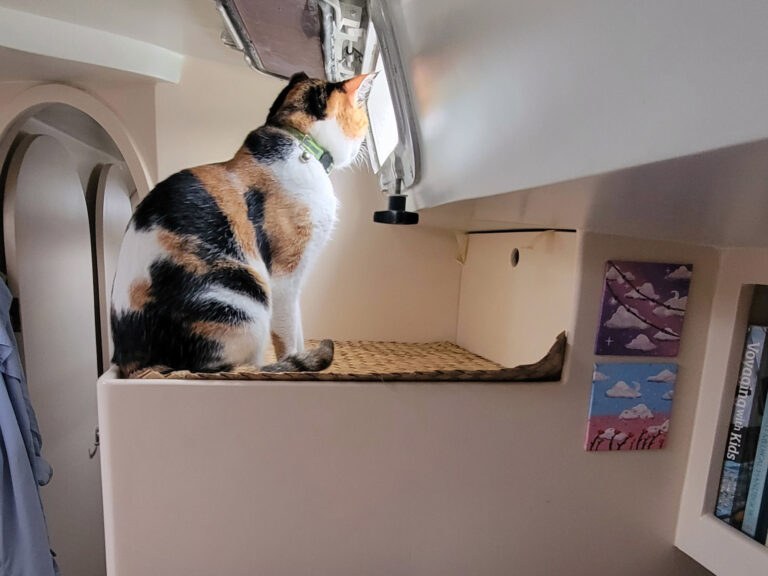
Modern Multihulls: The Future’s Electric

A Big, New World
- Digital Edition
- Customer Service
- Privacy Policy
- Email Newsletters
- Cruising World
- Sailing World
- Salt Water Sportsman
- Sport Fishing
- Wakeboarding
What are you looking for?
Suggested search.
Container vessel “Maersk Kowloon” at anchor on the Great Bitter Lake in the Suez Canal. Photo: Tim, CC BY-NC 4.0 via Flickr.
16. Vessel Anchoring
Author: Dr. James A. Fawcett, USC Sea Grant Maritime Policy Specialist/Extension Director (retired) Media Contact: Leah Shore / [email protected] / (213)-740-1960
An anchor has two common definitions. Its first meaning is defined as “a heavy device that is attached to a boat or ship by a rope or chain which is dropped into a body of water to secure a boat or ship in place.” Yet, it is also defined as, “a person or thing that provides strength and support”[1] While each of these definitions is useful, they tell only a part of the story about the function of an anchor. For a ship’s anchor, it is only part of the system that secures a ship. Let’s start from the beginning below and explore the details about the importance, purpose, components, and use of a ship’s anchor.
Purpose of a Ship’s Anchor
If we think of a ship as a sort of “bridge” that connects either cargo or people from one location to another, it’s clear that the vessel is a temporary floating intermediate link between those two shorelines. After all, only in the case of Wagner’s opera Der fliegende Holländer (the “Flying Dutchman”) is the ship cursed to sail the seas indefinitely. But, at times, reaching a destination does not mean that the vessel is immediately able to enter the port to be moored to a berth. For many reasons, the vessel may be required to use an offshore anchorage, securing itself in one location for a period of time. In busy harbors, “alongside space”–the common nautical term for a spot along the wharf or where a ship can unload–is often at a premium; ships must wait for their turn to embark or discharge cargo and passengers.
While recreational vessels commonly use small anchors deployable by hand over the side of the boat, merchant ships, because of their size, use a different type of anchor and that will be the focus of this discussion. A ship’s anchor system is relatively simple but consists of a number of elements, each of which is a necessary component of the system. At one end is the anchor itself, which is connected by a stout chain. It is both let go and hauled in by an anchor windlass[2]. so that the chain can be stowed on board in a capacious chain locker below decks. It is a simple system yet with critical importance for the safety of the vessel. Let’s consider the parts of this system.
Types of Anchors
By itself, the anchor is actually the simplest part of a ship’s ground tackle :[3] “the anchors, chains, cables, and other equipment used to secure a ship at anchor.” Today, the most commonly used maritime anchor is the “stockless,” “U.S. Navy,” or “Admiralty” anchor, all of which look essentially similar. They are very different from the stocked anchor, so often depicted in literature, pirate movies, and even symbolically on the U.S. Navy and U.S. Coast Guard uniforms.
The stocked anchor consists of a central shank at the end with two upward curved arms in opposing directions, each of which is furnished with a broad forged fluke acting like a shovel to dig into the bottom. Toward the top of the stock is a long bar attached to the shank but at 90o to the direction of the arms and flukes. Thus, when the anchor reaches the ocean floor, the stock forces the anchor to lie in such a manner with one of the two flukes poised to dig into the ocean floor. (See Figure 1)
Instead of this older design, a stockless anchor, as its name implies, needs no stock to be effective. In fact, it is designed to lie flat on the ocean floor. A much simpler design, it has only one moving part, a bearing or bushing, that attaches the shank to the two flukes. When deployed on the bottom, taking a strain on the anchor chain will cause the two flukes to rotate downward and dig into the underlying bottom. Thus, the bearing between the shank and the flukes acts like an axle, permitting the flukes to engage the bottom. The beauty of the system is its simplicity as well as effectiveness because of its low center of gravity: it wants to dig into the ocean bottom. Stockless anchors can be relatively small (160 kg or ~400 lbs.) to more than 50 tons[4] (the size of the common Caterpillar D9 bulldozer) and this is merely a general idea of their mass. (See Figure 2).
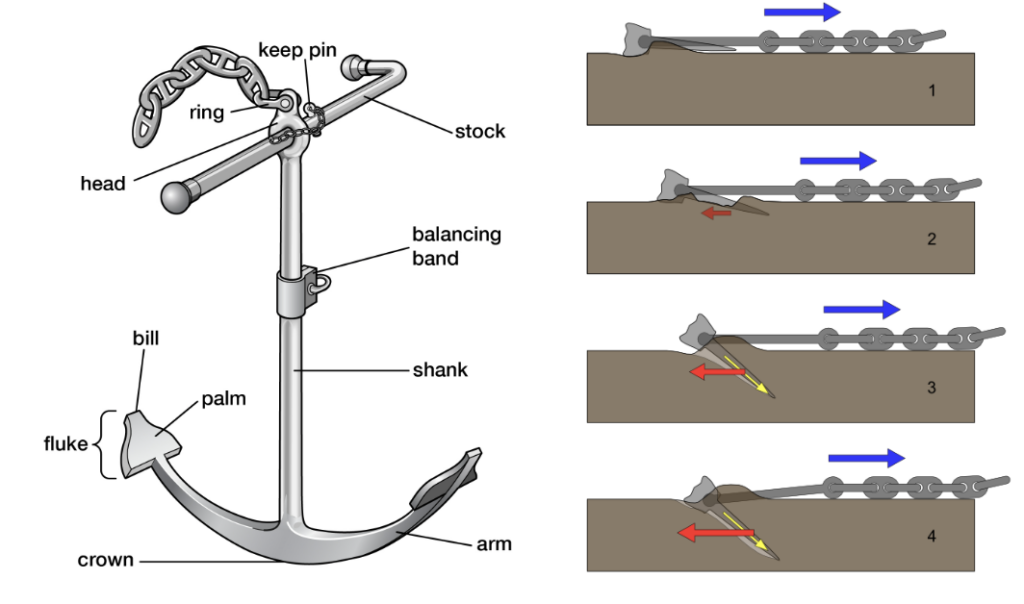
Anchor Chain
Attached to the anchor at one end and to the other end a robust fitting in the ship’s chain locker below decks, the chain is as critical, if not more so, than the anchor itself. If anchors are heavy, the chains that connect them to the ship are equally robust, with single links often weighing hundreds of pounds. An anchor chain used to be measured in “shots” of 15 fathoms (90 feet) joined by a detachable link (painted red) to the next 15-fathom shot. However, merchant ships now often have meters attached to their anchor windlasses, automatically measuring the length of an anchor chain that has been deployed. Generally, the U.S. Navy or merchant ship will carry as much as 1,000 feet of anchor chain or more (per anchor) in its chain locker, depending upon the size of the vessel.[5]
When deployed, it is common to pay out an anchor chain that is 5-7 times the water depth where the vessel is moored. Thus, in 60 feet of water, a ship would deploy 300-420 feet of anchor chain. This length serves two purposes: first, it gives the ship ample room to swing on the chain without placing excess strain on it; second, the weight of the chain and its friction on the ocean floor is the force that actually secures the ship in place , so a large volume of the deployed chain is important.
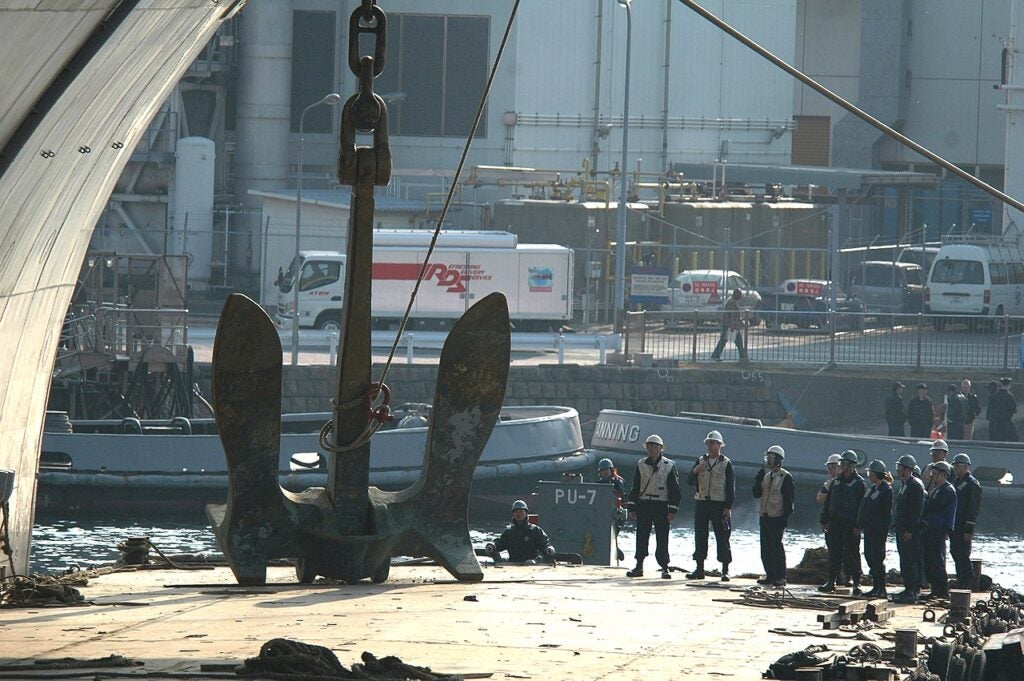
Anchor Windlass
The mass and weight of an anchor and its chain far exceed the capacity of the ship’s crew to manually raise and lower it, so on the foc’sle is a steam, hydraulic, or electric winch that is specifically designed to engage the links of the anchor chain. Equipped with clutches and brakes, the windlass can lower or raise the anchor at any specified rate, including free-running when letting go of the anchor. Upon anchoring, when the appropriate length of chain is discharged, a stopper is installed on the chain preventing further deployment.
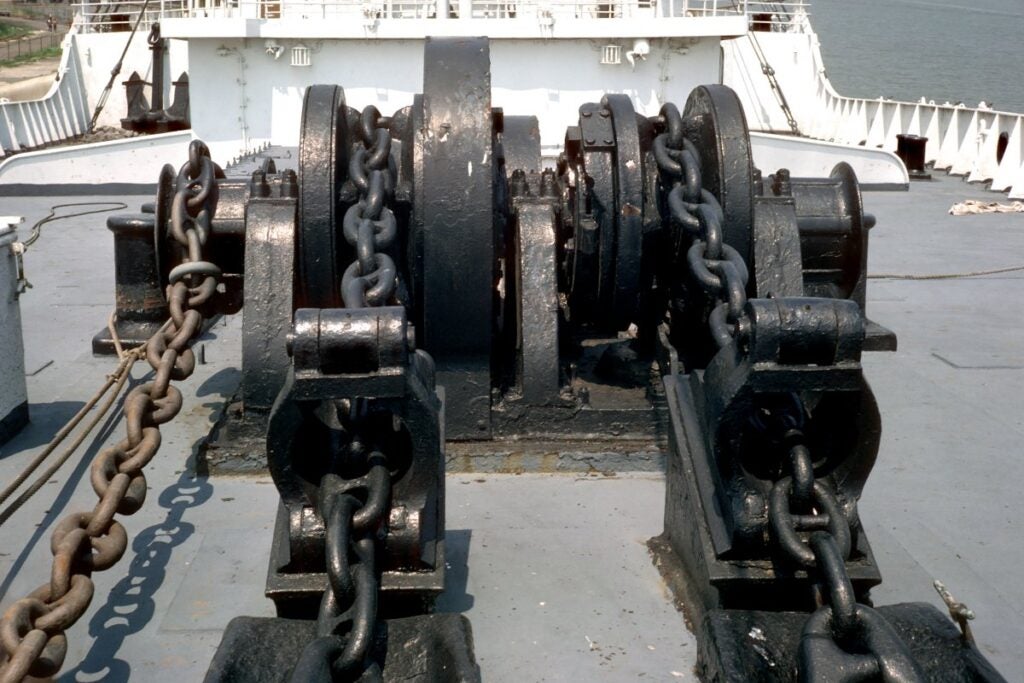
The Storage and Use of Anchors
The hawse pipe, a reinforced steel pipe from the foc’sle passing through the ship’s exterior skin allows the anchor chain to attach to the large anchor, which is stowed on the exterior of the ship when not in use. Upon its exterior is further steel reinforcement, creating a cradle in which the anchor is housed, a storage space that is both convenient and out of the way of the ship’s crew working on deck at the foc’sle. Meanwhile, the anchor chain is stowed below decks in the chain locker. Nevertheless, the chain remains connected to the anchor, permitting rapid deployment in an emergency.
Ships carry anchors on both port and starboard sides of the bow, either of which is capable of holding the ship in the anchorage in most cases. Often these two anchors have different lengths of chain depending upon the conditions encountered on the anchorage. Also, it is not uncommon for vessels to deploy both anchors in inclement weather or in an area with a fast current or high winds. In this case, expert seamanship is required to prevent them from becoming “fouled” or tangled.
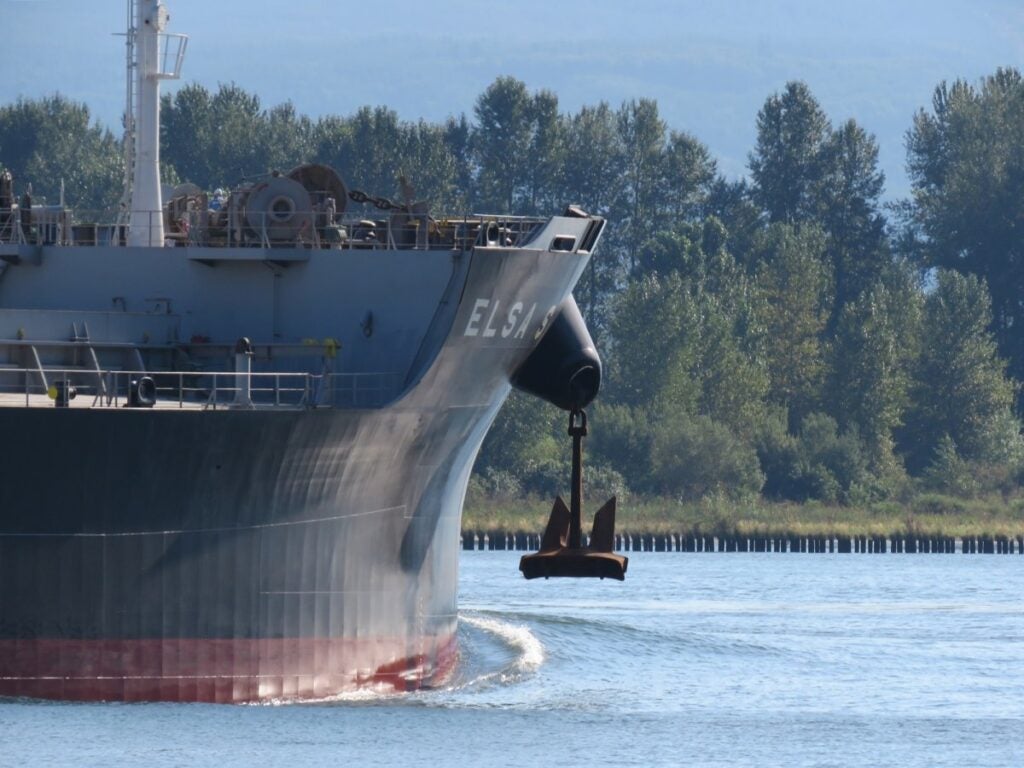
The Process of Anchoring
Safe anchorages are defined on nautical charts and are usually designated by numbers and/or letters. Coming into port, the harbormaster, port pilots, and the marine exchange/vessel traffic service (MX/VTS)[6] will instruct vessels on which designated anchorage is to be used. Each anchorage is identified on the relevant nautical chart with a center point surrounded by a circle known as the “anchor swinging circle”. This circle’s diameter is determined by the length of the vessel and displays the area within which the ship, at anchor, is required to reside. There is no “standard” size anchorage because ships are assigned based on the space that they need in order to avoid colliding with adjacent anchored vessels. At the Ports of Los Angeles and Long Beach, the nautical charts define 20 deepwater anchorages inside the long breakwater and 40 outside the breakwater. Additional anchorages are shown on the chart[7] but as CAPT Kipling Louttit, U.S. Coast Guard (ret.) and a leader of the MX/VTS, cautions, some are of limited depth or are reserved for barges with shallow draft.
In normal situations, we will commonly find a few tankers at anchor waiting for their turns at the liquid bulk terminals to offload crude oil for our local refineries, including an offloading buoy in Santa Monica Bay for the Chevron Refinery. However, in our unusual current situation , anchorages are filled with container ships waiting for vacant berths at one of the 13 container terminals in the two ports, terminals that under normal conditions schedule regular arrivals of these vessels with minimal, if any, wait times.
When all available anchorages are occupied—a common occurrence currently—the MX/VTS must find “parking” for them. One alternative is to assign ships to “drift boxes” outside the breakwater, clear of shipping arrival/departure lanes and restricted areas, and in areas defined by navigation coordinates assigned by the MX/VTS. When even those areas become filled the MX/VTS then assigns the waiting vessels to a standby area north of Catalina Island where they may not anchor but must drift under power to stand clear of other drifting vessels.
At anchor, vessels discontinue power to their propulsion engines and continue to operate their auxiliary power plant, which provides electricity to operate normal ship functions including the ground tackle previously described. Under normal conditions, the ship will swing on its anchor and will respond to currents, moving only within the circumscribed anchorage boundaries defined on the nautical chart. At anchor, services to these vessels must be provided by small service vessels bringing provisions, fuel, and other necessities out to them.
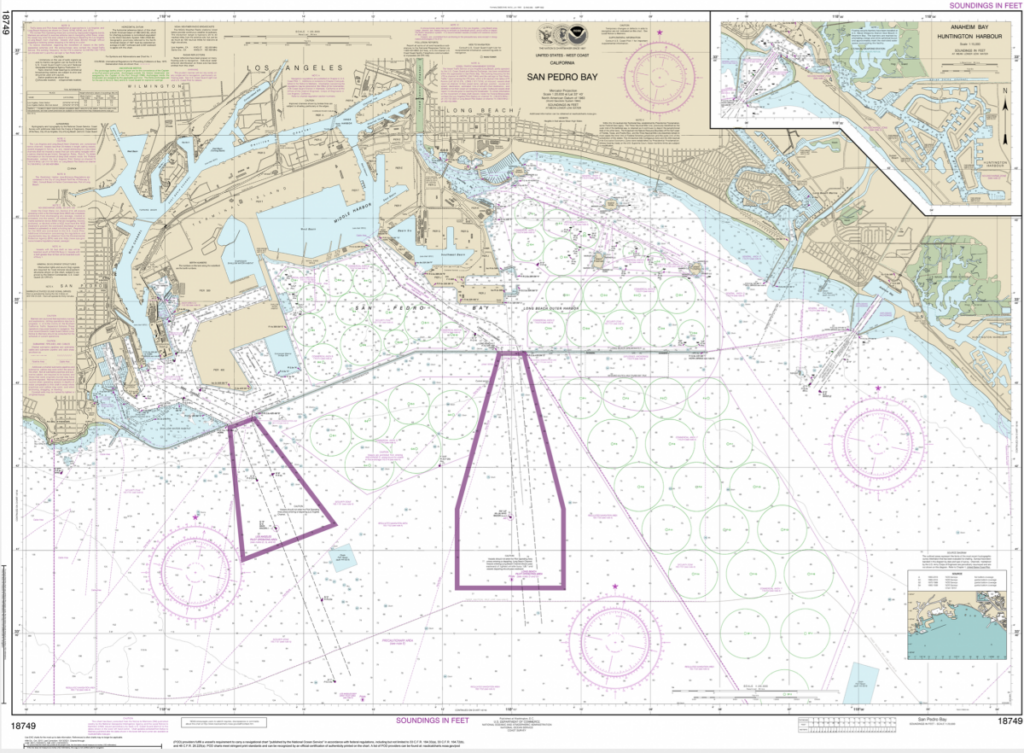
The Dangers of a “Dragging Anchor”
Even a stout anchor deployed with an ample amount of anchor chain may not be able to hold a ship in its assigned anchorage under certain weather conditions, most often when the vessel is buffeted by strong winds. The Intergovernmental Maritime Consultative Organization (now the International Maritime Organization) defines “dragging (of an anchor)” as, “ an anchor moving over the sea bottom involuntarily because it is no longer preventing the movement of the vessel. ”[8] When winds are sufficiently strong, even thousands of pounds of anchor and chain may not prevent the vessel from being pulled away from its anchorage, a condition known as “dragging anchor.” The danger of one of these incidents is that the vessel may collide with an adjacent ship causing damage to one or both. In heavy winds, the ship’s officers are responsible for either visually sighting its position every hour or maintaining a watch on electronic navigation equipment to assess its location within its assigned area.
The ships most vulnerable to “dragging anchor” are those with what mariners refer to as having a large “sail area.” These are vessels with an ample vertical component; in other words, “slab-sided” vessels such as heavily loaded container ships, roll-on, roll-off vehicle carriers, or large passenger vessels where the vessel presents what amounts to a flat “sail” to the wind. Low-lying vessels such as bulk carriers or tankships are less vulnerable because they sit much closer to the water and have low freeboard.
Any vessel that is anchored, irrespective of its configuration, is responsible to its owners, crew, cargo owners, and the public to maintain a vigilant watch when at anchor and in conditions of significant wind. Ultimately, the IMO imposes standards for ship masters to ensure that a vigilant watch is kept when a vessel is at anchor.[9] (See: IMO Circular no. STCW.7/Circ.14 – “Guidance for Masters on Keeping a Safe Anchor Watch.”)
As we now see, the anchor is one in a system of a myriad of components that safely and properly secure vessels; it is not just a simple hook as it appears from afar. The role of the anchor is a critical component to the working of ports such as the POLA and POLB and provides safety for the vessels even among the most uncommon or dangerous sets of conditions.
[1] Merriam-Webster. (2003). Merriam-Webster Collegiate Dictionary 11 th Ed.
[2] A windlass is a mechanical apparatus for lifting heavyweights. On ships, is it a deck-mounted horizontal drum powered by an attached winch, which is, in turn, powered by steam or, more commonly, by a hydraulic motor. The windlass contains a large wheel, a “chain gypsy,” with indentations that match the size and shape of the anchor chain providing a secure purchase for the chain as it is deployed or recovered. It is located on the foc’sle, the forwardmost upper deck of a ship.
[4] Jinbo Marine. JIS Stockless Anchor Specifications. http://www.chainanchor.com/products/jis-stockless-anchor/ . 17 Oct 2021.
[5] The Boatswain’s Mates of USS Nimitz (CVN 68) are making history, as they become the first team of Sailors to remove the anchor and chain of an aircraft carrier rather than contracting the work out to civilians. Fifty-seven links, each weighing 350-pounds, make up just one 90-foot shot of chain that weighs a total of 20,500 pounds. Twelve shots of chain collectively hold a 60,000-pound anchor. Considering the average person weighs less than 200 pounds, it’s safe to say the task of removing Nimitz’ anchors and chain is no small feat. https://allhands.navy.mil/Stories/Display-Story/Article/1839931/pulling-their-weight-anchor-and-chain/ .
[6] Personal communication, CAPT J. Kipling Louttit, Executive Director, Marine Exchange and Vessel Traffic Service of Southern California, 19 Oct 2021.
[7] NOAA. Navigation Chart 18749.
[8] IMCO. Resolution A.3so(x): adopted on 14 November 1977. STANDARD MARINE NAVIGATIONAL VOCABULARY. https://wwwcdn.imo.org/localresources/en/KnowledgeCentre/IndexofIMOResolutions/AssemblyDocuments/A.380(10).pdf
[9] IMO. Seafarers’ Training, Certification and Watch Keeping (STCW) Code Chapter VIII Section A-VIII/2. https://www.ukpandi.com/news-and-resources/bulletins/2007/517—0307—keeping-a-safe-anchor-watch—worldwide/

How Long Is the Anchor Chain on a Cruise Ship?
By Michael Ferguson
The anchor chain on a cruise ship can be quite long, depending on the size of the ship. On smaller ships, the anchor chain may be as short as around 60 feet, while larger ships may have an anchor chain that is over 200 feet long.
The length of the anchor chain is determined by several factors, such as the size of the vessel, and how deeply it needs to be anchored in order for it to remain secure. The larger and heavier a vessel is, the longer its anchor chain must be in order to keep it from drifting or pulling out of place.
In addition to the length of the anchor chain, other components must be taken into consideration when anchoring a cruise ship. This includes the type and size of the anchors used, as well as their anchorage capacity. Furthermore, if a vessel is larger than usual or if it carries heavier cargo than normal, additional anchors might need to be deployed in order to provide extra stability.
The weight of an anchor chain also varies according to its length.
A longer chain will generally weigh more than a shorter one. This means that vessels with longer anchor chains need stronger winches and mooring lines in order to handle their extra weight.
For safety reasons, cruise ships must ensure that their anchors are properly secured at all times. This means that they must use enough length of chain to ensure that they remain firmly anchored even during strong winds or rough seas. Most ships also have extra lengths of spare chain onboard which can be deployed if needed.
Conclusion:
The length of an anchor chain on a cruise ship can vary significantly depending on the size and weight of the vessel, as well as its intended mooring conditions. Smaller vessels may only require around 60 feet of chain, while large vessels may need more than 200 feet. The type and number of anchors used will also affect how much length is required for proper anchoring.
9 Related Question Answers Found
How long is a cruise ship anchor chain, how long are cruise ship anchor chains, how much anchor chain does a cruise ship have, how big is a cruise ship anchor chain, how heavy is an anchor on a cruise ship, how big is an anchor on a cruise ship, how heavy is a cruise ship anchor, how many anchors are on a cruise ship, how big is a cruise ship anchor, backpacking - budget travel - business travel - cruise ship - vacation - tourism - resort - cruise - road trip - destination wedding - tourist destination - best places, london - madrid - paris - prague - dubai - barcelona - rome.
© 2024 LuxuryTraveldiva
Winter is here! Check out the winter wonderlands at these 5 amazing winter destinations in Montana
- Travel Tips
How Heavy Is A Cruise Ship Anchor
Published: December 20, 2023
Modified: December 28, 2023
by Ricca Thomsen
- Sustainability
- Travel Essentials & Accessories
Introduction
Welcome aboard the fascinating world of cruise ships! As you embark on a memorable voyage, you may find yourself wondering about the intricate workings of these massive vessels. One of the most intriguing aspects is the anchor, a crucial component that ensures the ship’s stability and safety when docked or at anchor.
In this article, we will delve into the topic of cruise ship anchors and explore their weight. Have you ever wondered just how heavy these anchors can be? Join us as we uncover the mysteries of cruise ship anchors and provide some fascinating insights into their weight.
Understanding the weight of a cruise ship anchor requires a brief overview of their anatomy and function. Cruise ship anchors are massive devices designed to secure the ship in place by gripping the seabed effectively. They are typically constructed from high-strength material such as steel, capable of withstanding the forces exerted by an enormous vessel.
Before we dive into the specifics of anchor weight, let’s first take a closer look at the anatomy of a cruise ship anchor. By familiarizing ourselves with its components, we can better understand the factors that contribute to its overall weight.
Anatomy of a cruise ship anchor
A cruise ship anchor consists of several key components that work in unison to secure the vessel to the seabed. Understanding these components is essential to comprehend the weight and functionality of a cruise ship anchor.
1. Flukes: The flukes are the primary parts of the anchor that dig into the seabed to provide grip and hold the ship in place. These curved and pointed edges are designed to penetrate different types of seabeds, from sand to mud or even coral reefs. The flukes are usually made of high-strength steel and vary in size and shape depending on the anchor’s design.
2. Shank: The shank is the long, straight part of the anchor that connects the flukes to the rest of the anchor. It provides stability and strength to the anchor, helping it withstand the forces exerted by the ship and the water currents. The shank is typically made of a heavy-duty steel alloy, ensuring its durability in harsh marine conditions.
3. Stock: The stock is a pivotal component located at the crown of the anchor. It acts as a pivot point, allowing the anchor to orient itself in the correct position upon contact with the seabed. By aligning the flukes in the direction of the pull, the stock enhances the anchor’s ability to grip the seabed securely.
4. Arms: Some anchor designs feature arms that extend from the shank, providing additional stability and holding power. These arms, also known as tripping palms or palmates, help to prevent the anchor from dislodging due to shifting currents or changes in wind direction.
5. Anchor chain: The anchor chain serves as the vital link between the ship and the anchor. It connects to the anchor’s shank and provides the necessary weight and tension to keep the anchor firmly planted on the seabed. The chain is typically made of galvanized steel, ensuring its strength and corrosion resistance.
When all these components come together, they form a robust and reliable anchor capable of securing a massive cruise ship in various port conditions. However, the weight of a cruise ship anchor goes beyond the individual parts and encompasses several influencing factors that we will explore in the next section.
Understanding the weight of a cruise ship anchor
The weight of a cruise ship anchor is a critical factor in its effectiveness. A heavier anchor has more holding power, providing greater peace of mind for the ship’s crew and passengers. But how is the weight of a cruise ship anchor determined?
The weight of a cruise ship anchor is typically measured in tons and can range from several tons to over ten tons, depending on the size and type of the vessel. The weight is primarily influenced by the size and design of the ship, as well as the expected water depth and seabed conditions encountered during the voyage.
When considering the weight of a cruise ship anchor, it’s important to note that there isn’t a one-size-fits-all approach. Each ship requires a carefully calculated anchor weight to ensure stability and safety. A professional naval architect or marine engineer determines the optimal anchor weight based on various factors, including the ship’s size, displacement, windage area, and anticipated weather conditions.
The weight of the anchor plays a crucial role in ensuring that the ship remains securely anchored, especially in adverse weather conditions or strong currents. A heavier anchor means more holding power, keeping the ship in place and preventing it from drifting or dragging along the seabed.
Moreover, an anchor’s weight directly affects the amount of chain required to secure it. The chain acts as a counterbalance, providing tension to keep the anchor firmly planted. The length and thickness of the chain are also carefully determined based on the anchor weight and the expected maximum water depth at each port of call.
It’s essential to strike a balance when determining the anchor weight for a cruise ship. While a heavier anchor may provide more holding power, it also increases the overall weight of the ship, potentially impacting fuel consumption and stability. Conversely, an anchor that is too light may compromise the ship’s ability to stay anchored in rough conditions.
In the next section, we will explore the various factors that can influence the weight of a cruise ship anchor and delve into the methods used to determine its weight accurately.
Factors affecting the weight of a cruise ship anchor
The weight of a cruise ship anchor is influenced by several factors that are carefully considered during the design and construction process. Understanding these factors is crucial in determining the optimal anchor weight for a specific vessel and ensuring its effective performance. Let’s explore some of the key factors that affect the weight of a cruise ship anchor:
- Ship size and displacement: The size and displacement of the cruise ship play a significant role in determining the appropriate anchor weight. Larger and heavier ships require anchors with more holding power to keep them securely in place. The size and displacement also affect the amount of chain needed, which further contributes to the overall weight of the anchor system.
- Expected water depth: The water depth at different ports of call is another vital factor to consider. Deeper waters necessitate longer chains to secure the anchor properly. Consequently, the weight of the anchor may need to be adjusted to accommodate the additional length and weight of the chain, ensuring adequate holding power.
- Seabed conditions: The nature of the seabed at different ports can vary significantly, including sandy, muddy, rocky, or coral environments. Softer seabeds may require larger flukes or additional anchor designs to enhance grip and holding power. The weight of the anchor may need to be adjusted accordingly to accommodate these different seabed conditions and ensure the ship remains safely anchored.
- Expected weather conditions: The anticipated weather conditions are crucial in determining the anchor’s weight. Harsh weather, strong currents, and high winds may require a heavier anchor to provide the necessary stability and prevent the ship from drifting or dragging. The anchor weight must be carefully calculated to ensure the ship remains secure and minimizes the risk of anchor failure.
It’s important to note that these factors are not mutually exclusive and often interrelated. A thorough analysis of these factors, along with other considerations such as ship design and intended usage, is required to determine the optimal weight for a cruise ship anchor.
In the next section, we will explore the various methods used to accurately determine the weight of a cruise ship anchor.
Methods used to determine the weight of a cruise ship anchor
Determining the weight of a cruise ship anchor requires careful consideration and accurate calculations. Several methods are employed to ensure the anchor weight is appropriate for the specific ship and operating conditions. Let’s explore some of the commonly used methods to determine the weight of a cruise ship anchor:
- Naval Architect Calculations: Naval architects, with their expertise in ship design and stability, play a crucial role in determining the anchor weight. They consider factors such as ship size, displacement, windage area, intended usage, and expected environmental conditions. These professionals utilize complex mathematical calculations and computer simulations to determine the optimal weight that will provide adequate holding power and stability for the ship.
- Computer Simulations: Advanced computer simulations are utilized to model various scenarios, including different environmental conditions and seabed types. By inputting factors such as ship parameters, water depths, and expected weather conditions, these simulations can provide valuable insights into the anchor weight required for optimal performance and safety.
- Field Testing: Field testing is often conducted to validate the calculated anchor weight. This involves deploying the anchor and chain system in real-world conditions and assessing its performance. By monitoring the holding power and stability of the anchor in different seabed conditions and weather situations, engineers can gather valuable data to refine and adjust the anchor weight as necessary.
- Industry Experience and Standards: The accumulated knowledge and experience within the cruise ship industry also contribute to determining anchor weight. Industry standards and guidelines provide valuable recommendations based on historical data and best practices. Factors such as ship type, size, and expected operating conditions are taken into account when referencing these standards to determine anchor weight.
It’s important to note that multiple methods are often employed in combination to ensure the anchor weight is accurately determined. The collaboration between naval architects, engineers, and industry experts helps to achieve an optimal anchor weight that ensures the safety and stability of the cruise ship.
In the next section, we will examine case studies that exemplify the weight of cruise ship anchors in different scenarios.
Case studies on the weight of cruise ship anchors
Let’s explore a few case studies that highlight the weight of cruise ship anchors in different scenarios. These examples showcase the importance of anchor weight and how it can vary based on the unique characteristics of the ship and the operating conditions:
Case Study 1: Large Cruise Ship in Deep Waters
In this case, a massive cruise ship with a displacement of over 100,000 tons and a length of 300 meters is scheduled to visit ports with deep water depths. The naval architect conducts calculations considering the ship’s size, expected weather conditions, and the need for additional chain length due to the depth. The anchor weight is determined to be approximately 15 tons to provide the necessary holding power and stability in challenging conditions.
Case Study 2: Small Cruise Ship in Shallow Waters
In contrast to the previous case, a smaller cruise ship with a displacement of 10,000 tons and a length of 150 meters is expected to visit ports with shallow water depths. The calculations take into account the ship’s size, lighter weight, and the reduced chain length required in shallow waters. The determined anchor weight for this ship is around 5 tons, ensuring adequate holding power while minimizing unnecessary weight on the vessel.
Case Study 3: Cruise Ship in Unstable Seabed
This case involves a cruise ship that frequently visits ports with unstable seabed conditions, such as areas with muddy or sandy bottoms. The anchor design takes into account the need for larger flukes and more surface area to obtain a firm grip. Consequently, the anchor weight is increased to 8 tons to provide the necessary stability and prevent anchor dragging in these challenging seabed conditions.
These case studies illustrate the careful considerations involved in determining the weight of cruise ship anchors. Each ship’s unique characteristics, including size, displacement, intended operating conditions, and environmental factors, all contribute to the determination of the optimal anchor weight.
In the next section, we will conclude our exploration of the weight of cruise ship anchors with some final thoughts.
The weight of a cruise ship anchor is a critical factor in ensuring the safety and stability of these magnificent vessels. Understanding the anatomy, factors, and methods used to determine anchor weight provides valuable insights into the intricate world of cruise ship operations.
We have explored the various components that make up a cruise ship anchor, including the flukes, shank, stock, arms, and anchor chain. These components work together to provide the necessary holding power to keep the ship securely anchored.
The weight of a cruise ship anchor is influenced by factors such as the size and displacement of the ship, water depth, seabed conditions, and expected weather conditions. Each ship requires a carefully calculated anchor weight to ensure stability and effectiveness in different operating environments.
Naval architects, engineers, and industry experts utilize methods such as calculations, computer simulations, and field testing to determine the optimal anchor weight. These methodologies ensure that the anchor can withstand strong currents, adverse weather conditions, and provide the necessary grip on various seabeds.
Through case studies, we have seen how anchor weight can differ based on the size of the ship, water depth, and seabed conditions. The weight is carefully determined to provide the required holding power without compromising the vessel’s stability and performance.
In conclusion, the weight of a cruise ship anchor is a crucial consideration in maintaining the safety and stability of these remarkable vessels. By understanding the various factors and methods involved, we gain a deeper appreciation for the meticulous planning and engineering that goes into every aspect of cruise ship operations.
So, the next time you embark on a cruise adventure, take a moment to marvel at the weighty anchor that keeps your ship secure and allows you to peacefully enjoy your journey on the open seas.

- Privacy Overview
- Strictly Necessary Cookies
This website uses cookies so that we can provide you with the best user experience possible. Cookie information is stored in your browser and performs functions such as recognising you when you return to our website and helping our team to understand which sections of the website you find most interesting and useful.
Strictly Necessary Cookie should be enabled at all times so that we can save your preferences for cookie settings.
If you disable this cookie, we will not be able to save your preferences. This means that every time you visit this website you will need to enable or disable cookies again.
- CruiseMapper
- Ships and Lines
Cruise Ship Size Comparison, Dimensions
Compare cruise ship sizes by length, weight (tonnage), height, width/beam. Review cruise ship dimensions in both meters and feet, and FAQ information, definitions.
Cruise ship size comparison
In our huge table below there's a list of all most famous, ever best passenger cruise ships sorted by name. This survey also offers smaller cruise ships size comparison of top luxury all-inclusive vessels with gross tonnage even lesser than 5,000 GT. Now the list of all ship sizes related and integrated articles:
- passenger capacity of cruise ships
- cruise ships cost
- newest cruise ships (on order/under construction)
- list of the biggest cruise ships of the world
- world's largest cruiseship building companies
- cruise line companies list

Length of a cruise ship (Length Overall / LOA)
The cruise ship length is professionally referred to as LOA (length overall), meaning the maximum length between the two most distant points on its hull. LOA may also include the tip of the bowsprit - the pole extending from the ship's prow (usually on tall sailing ships, yachts, and smaller boats). The bowsprit is the "winning" part of the ship when competing in a race or during trials/speed tests.
Another passenger cruise ship length measuring (though not included in this survey) is called LWL. LWL signifies "loaded waterline length" (or just "waterline length"). It excludes the total length, denoting only the length at the point where the vessel sits in the water. The LWL measure plays an important role when assessing some ship properties, like "hull speed" (aka "displacement speed"), water displacement, the amount of paint needed for the ship's bottom, etc.
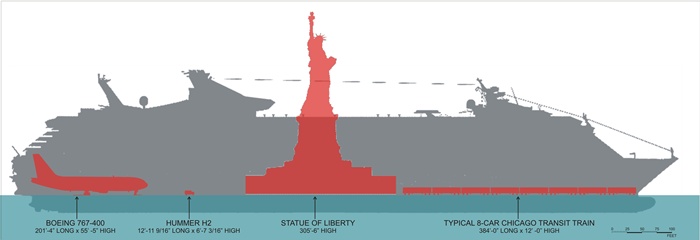
Longest cruise ship in the world
The longest cruise ships by size also occupy the first two positions in the list of the largest cruise ships of the world by passenger capacity and gross tonnage. The humongous Royal Caribbean's floating cities Allure and Oasis boast the whole 360 meters in length (1,181 ft), and breadth of 47 meters (154 ft), the unbelievable for a passenger cruise ship tonnage of 225,300 tons, and max crew-passenger capacity of almost 8,500 (2,170+6,300) - each!

Weight of a cruise ship (tonnage) and draft
The size (tonnage weight) of a cruise ship is measured in "gross tonnage" (GT). It relates to the vessel's internal volume (keel to funnel* and to the outside of the hull) and applying a mathematical formula. The cruise ship tonnage is generally used for determining registration fees, port fees, safety rules, regulations. Another ship data (though not included in this survey) is the vessel's "deadweight tonnage" (DWT), which is the weight a vessel can safely carry (cargo, passengers, etc).
The cruise ship draft (or draught) measures the number of meters/feet from the waterline to the lowest point of the keel - or the ship's "invisible" portion below the surface (and especially when loaded). The cruise ship's draft is very important when considering docking in a particular port, sailing through channels or the inland waterways of the continents (rivers and canals).
*Note: Actually, the ship's funnel is the only part of the enclosed interior space that is NOT included in its Gross Tonnage measurement.
Cruise ship weight
As one of our fans Mr John Spooner (cruiser / Retired Master Mariner) have pointed out, the "Gross Tonnage" weight is a measurement of VOLUME, and not of MASS. GT is an index related to marine vessels' overall internal volume. According to Wikipedia's definition:
- "Gross Tonnage" (GT) calculations are based on the volume of all the ship's enclosed spaces.
- "Gross Register Tonnage" (GRT) is the vessel's total internal volume measured in "register tons" (each ton equals 100 ft3 / 2,83 m3).
- Neither GT nor GTR measures the vessel's displacement (mass), but really show how big cruise ships are.
- "Deadweight Tonnage" (DWT) measures how much weight a cruise ship (or any of the marine vessel types) can carry safely. This a weighted sum of the vessel's cargo (incl provisions, passengers, crew), fuel, water (fresh and ballast), etc.
- "Displacement Tonnage" is how much weight the water that a cruise ship (any vessel) displaces when floating (the total weight of the ship / including its contents). Displacement is usually applied to the navy rather than commercial marine vessels. It is measured when the ship is loaded at full capacity.
Compare cruise ship sizes

Amazing World Cruises
A World of Endless Travel Possibilities.
- Glamorous Gustavia 2024 Seven Seas Navigator December 13-23, 2024
- Colorful Caribbean Shores Seven Seas Grandeur March 5-19, 2025
- Play My Cruise
- Cruise Preferences Tell us about your cruise preferences and we’ll recommend the perfect voyage for you.
- Africa Cruises
- Alaska Cruises
- Antarctica Cruises
- Arabian Gulf Cruises
- Asia Pacific Cruises
- Australia Cruises
- Bahamas Cruises
- Canada Cruises
- Caribbean Cruises
- Central America Cruises
- Eastern Europe Cruises
- Galapagos Cruises
- Hawaii Cruises
- Japan Cruises
- Mediterranean Cruises
- Mexican Riviera Cruises
- Northern Europe Cruises
- Panama Canal Cruises
- Repositioning Cruises
- South Pacific Cruises
- Transatlantic Cruises
- World Cruises
- Meet Our Agents
- 2024 World Cruises
- 2025 World Cruises
- 2025 Cunard Queen Anne World Cruise
- 2026 World Cruises
- Travel Blog
The Anatomy of a Cruise Ship Anchor Chain

Book Your Next Amazing Cruise with Travel Leader, Jeffrey Cleary
While it may seem like a relatively simple piece of equipment, a cruise ship’s anchor is a marvel of modern engineering. When you consider the incredible size and weight of a modern-day cruise ship, you begin to realize what an incredibly difficult task is to ensure they are secured in place while they are in the harbor.
Today, we will take an in-depth look at cruise ship anchor chains. Not only will we break down how they work, but we also explore what they are made from, the various components of the chain, and the incredible engineering that goes into ensuring that they can hold a cruise ship in place.
So, if you are ready to learn everything you need to know about a cruise ship anchor chain, let’s get started!
What Is a Cruise Ship Anchor Chain?
While it may seem pretty self-explanatory, a cruise ship anchor chain plays a complex and incredibly important role in ensuring the overall safety of a cruise ship voyage. These massive chains need to withstand the incredible forces exerted on the cruise ship’s anchor when the cruise ship is in the harbor.
To withstand the immense pressure generated by holding a heavy cruise ship in place against tides, waves, and ocean currents, the anchor chain and cables need to be immensely strong, and incredibly flexible. The individual chain links look just like any other type of chain, but they are on a massive scale.

Each link in the chain is made from high-grade steel with incredible tensile strength. While the chain size will vary depending on the size and weight of the cruise ship, they are all incredibly large and heavy.
Read Also: What is the Draft of a Ship?
In some cases, the waters the cruise ship traverses can also be a factor when determining how large the anchor chain needs to be. For example, large ships that traverse deep waters with strong currents need a much larger anchor and anchor chain than small boats on shallow water that stay close to the coastline.
What Is the Anatomy of a Cruise Ship Anchor?
The traditional anchor chains of a cruise ship may seem like they have a relatively simple design, but they are made up of many different parts, which all have to be made to an extremely high standard.
Here are the main components of a cruise ship anchor chain:
The Chain Links
The most prominent component of a cruise ship anchor chain is the series of interconnected links that make up the bulk of the chain. These links are massive in scale, and they need to be constructed of high-tensile, high-strength steel.
The chain design allows for the perfect combination of strength and flexibility, which is necessary when holding a heavy anchor in place against the tremendous forces of a large body of water and heavy vessels.

Each link in the chain will look like an elongated oval, or it can be designed to have more of a “D” shape. These two shapes allow the chains to be connected in a way that maintains their strength but can still move smoothly.
All links within the chain are also designed to be the exact same size. They also need to be precisely spaced so that each link has the same freedom to move as the next. If this was not the case, dropping and retrieving the anchor would be much rougher. The chain could also become damaged over time.
The Joining Mechanism
The individual links within the chain are joined together using a detachable mechanism. Basically, this mechanism consists of a connector and an anchor shackle.
Not only does this make it possible to put the chain together, it also makes it possible to remove damaged or corroded links within the chain without completely replacing the entire anchor chain.
Depth Markings
Most cruise ship anchor chains also feature depth markings at evenly spaced-out intervals. These allow crew members to easily determine how much of the chain has been released by the anchor windlass. Typically, these markings are made with bright, scratch-resistant paint; however, they can be made by stamping impressions into the metal.

To learn more about the anchor of a cruise ship, rather than just the chain that connects it to the ship, we recommend reading about how big a cruise ship anchor is . This straightforward guide explains how big these enormous anchors need to be and provides other helpful information on how modern anchors work.
How Much Do Cruise Ship Anchor Chains Weigh?
As mentioned, the anchor weight, chain length, and size of a cruise ship’s chain can vary depending on the weight and dimensions of the cruise ship itself.
That said, the general range for a single link of the anchor’s chain tends to be between 11 lbs (5 kg) to about 290 lbs (130 kg). The longer the chain length, the more it weighs.
Worth Reading: How Much Does a Cruise Ship Weigh?
With individual links weighing so much, the anchor chain’s overall weight can easily be measured in tons. When you think about the weight of a cruise ship and the immense forces sea and ocean water can exert, it only makes sense that the chains need to be incredibly heavy.
What Is a Cruise Ship Anchor Chain Made Of?
Cruise ship anchor chains need to be made from high-strength steel. Steel is the only suitable choice, as it offers the durability and strength required to withstand such immense forces. The high-strength steel alloys used to make these enormous anchor chains are also resistant to corrosion caused by lengthy exposure to saltwater.

To enhance the corrosion resistance of the anchor chain, most are given additional coatings and surface treatments to enhance the anchor chain’s corrosion resistance. Galvanization and various types of specialized coatings are used for the individual links of the anchor chain.
These surface treatments can not only delay corrosion, they can also help prevent scratching as the chain links rub against each other and even the hull.
Why Do Cruise Ship Anchor Chains Need to Be Flexible?
Not only do cruise ship anchor chains need to be heavy, strong, and incredibly durable, they need to be flexible. Flexibility is essential for the following reasons:
The Ability to Move with Currents, Tidal Changes, and Swell
Even when a cruise ship is anchored in a harbor, the anchor chain must be capable of adjusting to fluctuations in water conditions. The tide can change the depth of the water rapidly, so if the chain is not flexible, it would be under much more tension.

This could damage the anchor and the ship itself. By remaining flexible, the anchor chain can also absorb sudden forces caused by large waves and storms.
Noise and Vibration Reduction
A flexible anchor chain creates far less noise when the ship moves. For passengers to have a more comfortable experience while they are on board the ship, flexible anchor chains reduce creaks and other noises that could be disturbing.
Flexibility Makes it Easier to Drop and Retrieve the Anchor
The chain’s flexibility is essential when it comes to dropping and retrieving the anchor. When the anchor is dropped or lifted, the chain flows through a chute on the side of the ship’s bow.

Flexibility Allows the Anchor to Adjust to Differing Seabed Depths and Compositions
As you may know, a seabed in one area can differ in composition from one area to the next. While some are sandy and easy for an anchor to dig into, others are uneven and rocky. By having a strong but flexible anchor chain, the anchor can have a much more stable hold.
Frequently Asked Questions (FAQs)
What is the biggest cruise ship anchor chain in the world.
Currently, the world’s largest anchor chain belongs to the Oasis Class cruise ships owned and operated by Royal Caribbean International. These anchor chains weigh between 130 and 160 tons!
Do cruise ship anchor chains ever break?
Although extremely rare, cruise ship anchor chains have been known to break. Typically, this is due to corrosion and long-standing exposure to salty seawater. Overloading the anchor chain by dropping anchor in rough seas can also cause wear and tear. Eventually, this damage could result in the chain breaking.
Read about an anchor lost after getting stuck near San Juan for an example of how and why large vessels could be forced to cut its anchor loose.
How often are cruise ship anchor chains inspected?
While the exact frequency of inspections will depend on the particular policies of each cruise line, most anchor chains are inspected as part of the cruise ship’s regular inspection and maintenance procedures. This means a visual inspection usually occurs before each voyage.
More in-depth inspections are typically conducted at least once a year. During these inspections, each chain link is checked for signs of damage and corrosion. As you would expect, the frequency and closeness of inspections can increase if the crew suspects that the anchor chain could be damaged.
Final Words
While casual cruise-goers often overlook them, there is an incredible amount of engineering that goes into making and maintaining a cruise ship anchor chain. Not only is the scale of the individual links impressive, but the ability of the chain to withstand immense forces is also truly a marvel of maritime engineering.

Caribbean Cruises | Carnival Caribbean Cruises | Celebrity Caribbean Cruises | Cunard Caribbean Cruises | Disney Caribbean Cruises | Holland America Caribbean Cruises | MSC Caribbean Cruises | Norwegian Caribbean Cruises | Oceania Caribbean Cruises | Princess Caribbean Cruises | Regent Seven Seas Caribbean Cruises | Seabourn Caribbean Cruises
World Cruise | 2024 Queen Mary 2 World Cruise | 2024 MSC Poesia World Cruise | 2025 Around the World Cruise | Amazing World Cruises | Luxury Cruising | Home
Recommended Posts

All Princess Cruises to Alaska Will Show the Northern Lights

Disney Releases New Construction Photos of Private Cruise Destination

Cruise Ship Begins Dry Dock Transformation Ahead Of 1,301-Day Voyage

Carnival Cruise Line Introduces New Loyalty Gift

Royal Caribbean Ship Fixed, Next Cruise Confirmed to Go Ahead

New-Build Holds ‘Lucky Coin’ Ceremony as Launch Nears
Jeffrey Cleary is an experienced travel advisor and cruise specialist with a wealth of knowledge and expertise in Caribbean and World cruises. With over a decade of experience in the travel industry, Jeffrey has developed a reputation as a trusted advisor for those seeking unforgettable Caribbean and/or World cruise experiences. "I bring a wealth of experience and knowledge in the cruise industry, along with real-world experience on many of the finest ships at sea. I love cruising myself, so I am often sailing (and reachable by clients) and experiencing the cruise lines first hand. I'll get to know you, your style, your ideal vacation and recommend an Amazing Cruise experience."
Boat Reviews
- Boats Specs
- Marine Pros
- Boat Insurance
- Boat Warranties
- Boat Transport
- Boat Towing
- Marine Forecasts

Your Ultimate Boating Resource

What is the size and weight of a ship anchor?
Anchors are an essential part of any boating experience, providing a critical role in stabilizing a vessel and keeping it secure in one location. However, the size and weight of a ship’s anchor can vary significantly depending on the size of the vessel and the conditions under which the anchor will be used.
For smaller boats and recreational vessels, anchors may only weigh a few pounds and be relatively compact in size. This is because these boats aren’t typically exposed to harsh weather conditions or strong currents, and the anchor’s primary role is to keep them from drifting away in calm waters.
Larger ships, on the other hand, require much larger and heavier anchors to keep them secure in even the most challenging conditions. For example, an average-size container ship may require anchors weighing around 20,000 pounds or more, depending on the ship’s size, cargo, and the waters it will be navigating.
The size and shape of a ship’s anchor can also vary depending on the vessel’s intended use. For example, a ship that is designed for fishing or research purposes may use a grapnel anchor, which features multiple hooks that can better hold the vessel in place in shallow waters. Alternatively, a larger cargo vessel may require a more traditional fluke-style anchor to provide the necessary weight and holding power.
Overall, the size and weight of an anchor are critical factors to consider when selecting the right one for any boat or ship. While smaller vessels may require only a lightweight and compact anchor, larger ships must have a significantly more massive and more robust anchor to keep them secure in even the harshest weather and water conditions. As such, it’s essential to choose the right anchor for your vessel’s needs to ensure a safe and secure boating experience.
Related Questions
What type of wood is used for pier pilings, what is the difference between a dock and a floating pier, what is the proper technique for pulling a beginner wakeboarder, what does ‘no wake’ mean on a lake, what is the difference between wash and wake, is wakesurfing possible in the sea, why don’t wooden piers rot, what size wakeboard is needed, how to achieve more pop on a wakeboard, does wake surfing translate to ocean surfing, latest posts, 2024 pursuit os 445: an overview, dock your boat smoothly this summer with these tips, the billionaire’s playground: where to spot superyachts around the world, summertime snack ideas for your boating adventure, don't miss, our newsletter.
Get the latest boating tips, fishing resources and featured products in your email from BoatingWorld.com!
De-Winterize Your Boat the Right Way with These Professional Tips
10 essential tips for fishing near private property, the benefits of using a drift sock: guidance for anglers, lure fishing: secrets for imitating live bait and attracting fish, explore the untapped depths of america’s best bass fishing spots, tackle your catch-and-release adventures with these 6 tips, outboard motor maintenance: tips for keeping your engine in top shape, the essential boat tool kit: tools every boater needs, diy boat building: 8 tips and tricks for building your own vessel, the art of miniature maritime craftsmanship: ship in a bottle, antifouling paints: a guide to keeping your boat shipshape, beginner’s guide to standup paddle boarding: tips and techniques, boating for fitness: how to stay active on the water, kayak safety: how to stay safe on the water, anchoring in a kayak or canoe: how to secure your small boat, 2024 aquila 47 molokai review, 2024 sea-doo switch 13 sport review, 2024 aspen c120 review, 2024 yamaha 222xd review, 2024 sailfish 316 dc review, 2023 seavee 340z review, 2023 centurion fi23 review, gear reviews, megabass oneten max lbo jerkbait review, fortress anchors fx-7 anchoring system review, fortress anchors fx-11 anchoring system review, fortress anchors commando anchor kit review, fortress anchors aluminum anchors review, stay in touch.
To be updated with all the latest news, offers and special announcements.
- Privacy Policy

Marine Supply & Equipment
- Ship Anchors
ANCHORS MARINE – OIL – FISHING – OFFSHORE CONSTRUCTION – BARGES – DISPLAY

Great for use on: Barges, Oil Rigs, Offshore Construction, Moorings, etc.

THE SHARP FLUKES OF THE KEDGE CLUTCH READILY IN MANY TYPES OF BOTTOMS. ALSO MAKES A GREAT DISPLAY OR DECORATIVE PIECE!
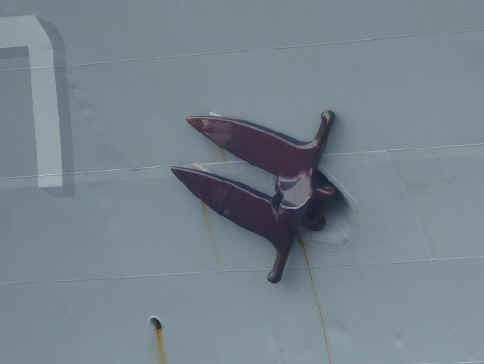
WORKBOAT (8-30,000 LBS)

NAVY ANCHORS (300-60,000 LBS)

STOCKLESS TYPE (50-50,000 LBS)

HALLS TYPE (1,455-60,625 LBS)

MOORFAST TYPE (1,000-100,000 LBS)

USN LWT (100-100,000 LBS)

BBI-DELTA H.H.P. (SHOWN AT TOP OF PAGE)

View Our Products
- Absorbents & Oil Spill Kits
- Anchor Links & Shackles
- Anchors & Chains
- Anchor & Mooring Chain
- Backing Out Punch Tools
- Baier Marine Hatches
- Buoy Release Hooks
- Carpenter Stoppers
- Chain Chaser
- Dredge Floats
- DuraBrite Marine Lights
- Jim Buoy Mooring Buoys
- Ladders & Gangways
- Launching Airbags
- Marine Fenders & Buoys
- Marine Hardware
- Mooring Release Hooks
- Oil Spill Containment
- Pelican Hooks
- Pneumatic Ship Fenders
- Release Hooks
- Rubber Fenders
- Sea Catch Release Hooks
- Ship Salvage Airbags
- Solid Foam Fenders
- Steel Buoys
- Surplus Equipment
- Vessel Salvage Bags
- Yokohama Fenders
Join Our Mailing List
Please enter the answer to submit the form:.
Your info is safe with us. Read our Privacy Policy .
Stay Connected

- Airbags & Launching Airbags
- Terms & Conditions
- Claims & Returns
- International Orders
- Other Websites of Interest
*Mailing Address Only:
6625 Miami Lakes Dr. Ste 324
Miami Lakes, FL 33014
(754)225-2883

- Broadcast Sales
- Footage Sales
Watch: This is what cruise ship anchors can do to a coral reef
The Caribbean's Grand Cayman might be twice the size of Manhattan, but the island makes up for its small size with vast biodiversity. The reefs surrounding Grand Cayman play home to over 30 species of coral, and some 350 species of fish, making it one of the top destinations for ocean-loving tourists.
Divers recently captured this troubling clip of a luxury cruise ship anchoring on one of the island's reefs. The MV Zenith (Royal Caribbean fleet member) didn't break any laws – the reef overlaps a permitted drop zone – but the footage illustrates just how detrimental human activity can be on fragile marine ecosystems.
" The Department of Environment was contacted but nothing could be done," says Scott Prodahl , who uploaded the video to his YouTube channel. "As part of the marine park, we are not allowed to fish here, not allowed to hunt lobsters, you can't even pick up an empty shell ....but for some reason you can drop an anchor and wipe out a reef that took thousands of years to grow. This video was shot roughly an hour after the anchor was dropped, I can't imagine what it looks like now."
Anchor damage like this can be long-lasting because it not only breaks coral, but also dislodges it from the seabed. In fact, anchor damage on a reef in the Virgin Islands resulted in a loss of coral cover that was still visible ten years later.
Though they look like underwater plants, corals are actually compact colonies of tiny animals in the phylum Cnidaria . Each polyp builds its home upon the skeleton of the one that came before it, eventually forming the large formations we see in the video. With growth rates of just 0.3 to 10 centimetres per year, it can take up to 10,000 years for a coral reef to form from a group of larvae!
But anchor dragging doesn't just effect the coral itself. The reef and its surrounding sea-grass beds provide a nursery for juvenile fish and other animals. As little as a two percent dip in coral can cause a significant change in the total number of fish and number of species seen in subsequent years.
"The chain was draped across that whole entire span of the reef, so the area that it covered was absolutely massive," Prodahl told Cayman News 27 . "It was constantly moving back and forth across the reef and causing a lot of damage as it did that."
The question on everyone's mind is why a cruise ship would be allowed to anchor here in the first place. This event illustrates just how difficult it is to implement a well-managed marine protected area. With tourism accounting for 50 percent of the nation's GDP, policies often aim to minimise damage rather than to eliminate it.

"We have reviewed the video footage and while it is not good to look at, the truth is that this site has been previously impacted," DOE deputy director Tim Austin said in a statement . "It hasn’t been subjected to the same amount of damage as the other anchorage sites, which is why you see surviving coral colonies there.”
Since the early '80s, coral cover across the entire Caribbean has plummeted to just 20 percent of its original surface area – and Austin has personally watched it unfold.
In a recent interview for Mother Jones , the born-and-raised Cayman Islander recalls his childhood, a time when the dense forest of coral around the island made if difficult to navigate boats.
"Anybody who's been diving in Grand Cayman for a long time would agree that it's very different today," he says. "But it's a very slow death. These things are dropping apart and no one is really aware of it."
The situation in the Cayman Islands has garnered concern from scientists for decades, and some positive changes have been made in recent years, like the development of scattered permanent mooring lines and docks.
Local authorities are now investigating to determine just how much coral was actually affected in this latest incident, but as damage like this continues to chip away at the remaining reef systems, we can expect to see cascading effects in the coming years. Stricter regulations are necessary if we hope to protect these fragile ecosystems.
Top header image: Joshua Kinberg, Flickr

Sarah Keartes
Sarah Keartes is a science and wildlife journalist based in the Pacific Northwest. When she’s not serving up stories, she can be found climbing mountains with a board on her back. Follow her on Twitter @sarahkeartes
YOU MADE IT TO THE END
Our planet is a busy, crazy place. And amidst all the noise, voices get lost and some stories are never heard. That’s especially true of our planet’s countless wild species: big and small, threatened and persecuted, complex and fascinating.
SUPPORT US FOR $1 A MONTH
For our growing team of writers and contributors, those are the stories that matter most: we dedicate our time to them all day and every day. In a world bursting with news, nature is our niche – and we love it that way.
BECOME A SUPPORTER
You, our viewers, are passionate about these stories we tell. Take your passion further by supporting and driving more of the nature news you know and love.
RELATED ARTICLES

Spawning an Intervention: The art and science of raising coral babies
An international team of scientists is mastering the art and science of raising coral babies.

Coral reefs 101: Why do we need them and what's being done to protect them
This World Oceans Day, we're zooming in on coral reefs.

Vandals carve names into coral at famed Thailand dive site
An act of vandalism at a dive site in Thailand's Similan Islands has caused lasting damage to beautiful brain coral.

MOST POPULAR

Gorillas in Their Midst
Other stories by sarah keartes.

For the first time ever, a narwhal has stranded on Belgium’s shores

World's most elusive whale filmed on the Great Barrier Reef

Should the US ban shark feeding?

earth touch OUR PLanet. close up
- Subscriber Center
- Print Editions
- Email Newsletters
- Submit a Story Idea
- Submit a Photo
- Submit a Press Release
- Submit Sports Results
- Entertainment
- Homer News Editorial
- Letters to the Editor
- Point of View
- Submit a Letter to the Editor
- Announcements
- Pet of the Week
- Cops and Courts
- Submit an Announcement
- Submit a Wedding Announcement
- Submit an Engagement Announcement
- Submit a Birth Announcement
- Local Weather
- Place an Obituary
- Classifieds
- Place a Classified Ad
- Legal Notices
- Terms of Use
Council resolves to consider cruise ship impacts, possible policies
Resolution 24-048 directs Homer commissions to conduct conversations with city staff and stakeholders
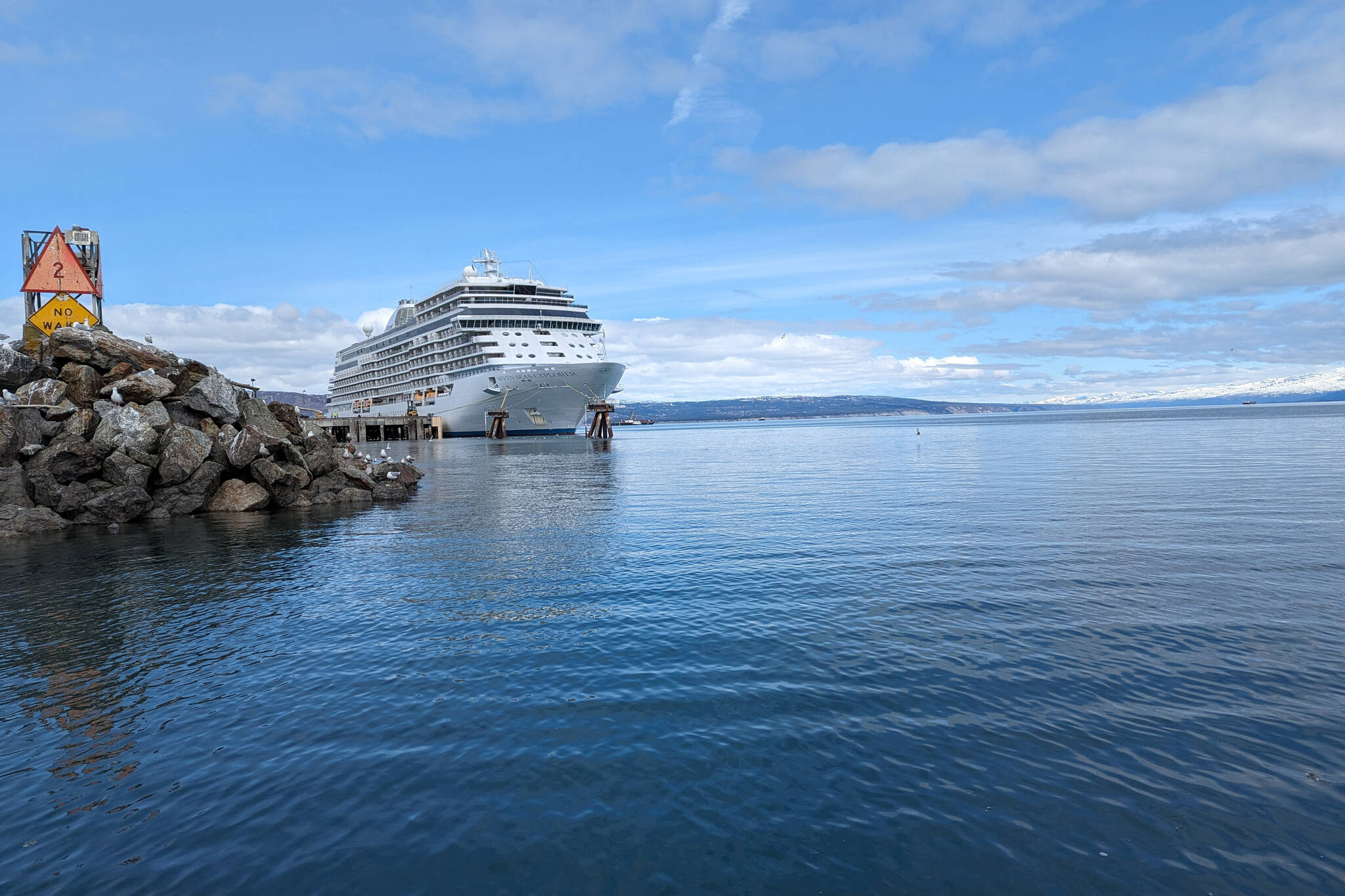
More Stories From This Author

Schwartz wins 29th Anchor Point...

Comp plan project leaders launch...
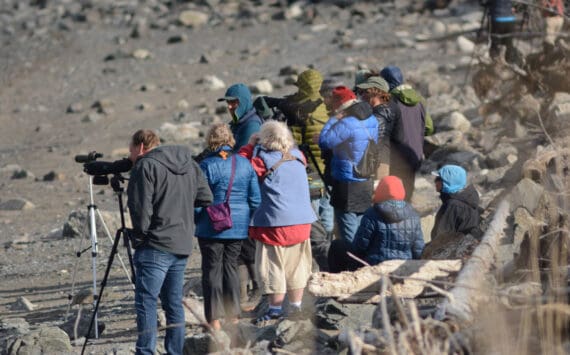
32nd Shorebird Festival arrives May...

26th annual Kenai Peninsula Writers’...
32nd shorebird festival arrives may 8-12.
The shorebirds are coming, the shorebirds are coming!

Homer High School students attend spring state student council meeting in Utqiagvik
The Alaska Association of Student Governments held their spring conference at Barrow High School in Utqiagvik from April 18-21. The…

Homer sophomore attends state Future Farmers of America meet in Palmer
The event took place April 16-19
Featured Local Savings
- Newsletters
- Media Solutions
- Your Privacy
- Accessibility

- A subsidiary of Black Press Media
- Work With Us
Carnival Jubilee ship review: A guide to Carnival's third Excel Class cruise ship

Editor's Note
When Carnival Cruise Line's Carnival Jubilee debuted in December 2023, it became the third ship in the line's Excel Class , closely mimicking sister ships Mardi Gras and Carnival Celebration. Although there are more similarities than differences among the three, Carnival has still found a way to make Carnival Jubilee innovative and fun by tweaking a few of the offerings.
The ship shares Carnival's "zone" concept with its two older sisters, meaning it has dedicated areas for dining, drinking, entertainment and outdoor fun, including Bolt, a top-deck roller coaster. The biggest differences on the newest iteration are in two reinvented zones, Currents and The Shores; respectively, they take the place of The French Quarter and La Piazza on Mardi Gras , and The Gateway and 820 Biscayne on Carnival Celebration .
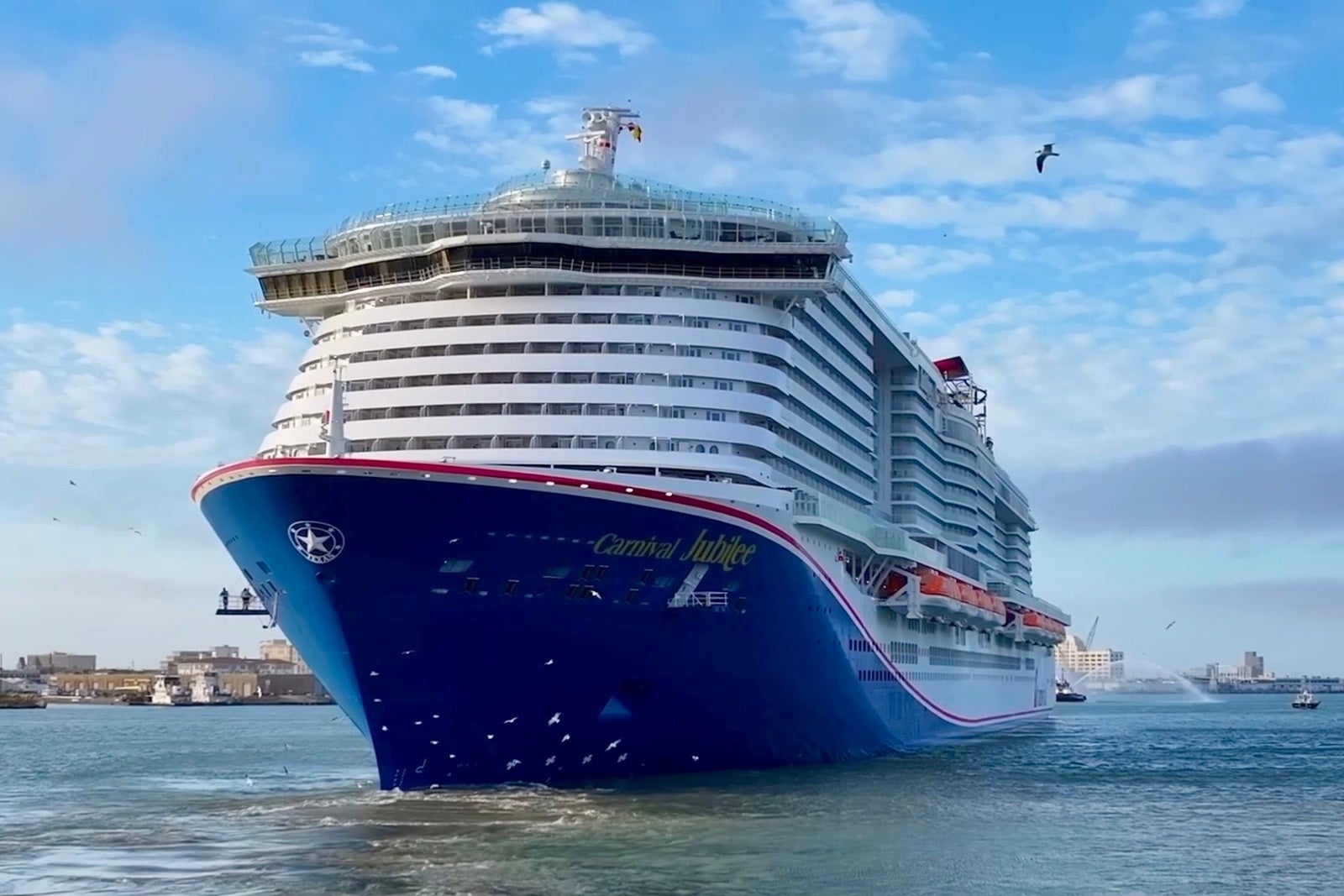
On my voyage, the ship carried 5,676 passengers, plus crew. This meant it wasn't at capacity, but it still felt loud and crowded, and often was fraught with lines. However, the service was generally excellent, with an exceedingly friendly crew.
The vessel is also a ton of fun, featuring two new shows (one with a football tailgate theme and the other with an onboard wedding plot), plenty of daily activities and so many fantastic dining options — many of them free — that it'll make your head spin.
Here's the rundown on what you can expect on board so you can determine if Carnival Jubilee is right for your next sailing.
For more cruise guides, news, reviews and tips, sign up for TPG's cruise newsletter .
Carnival Jubilee overview
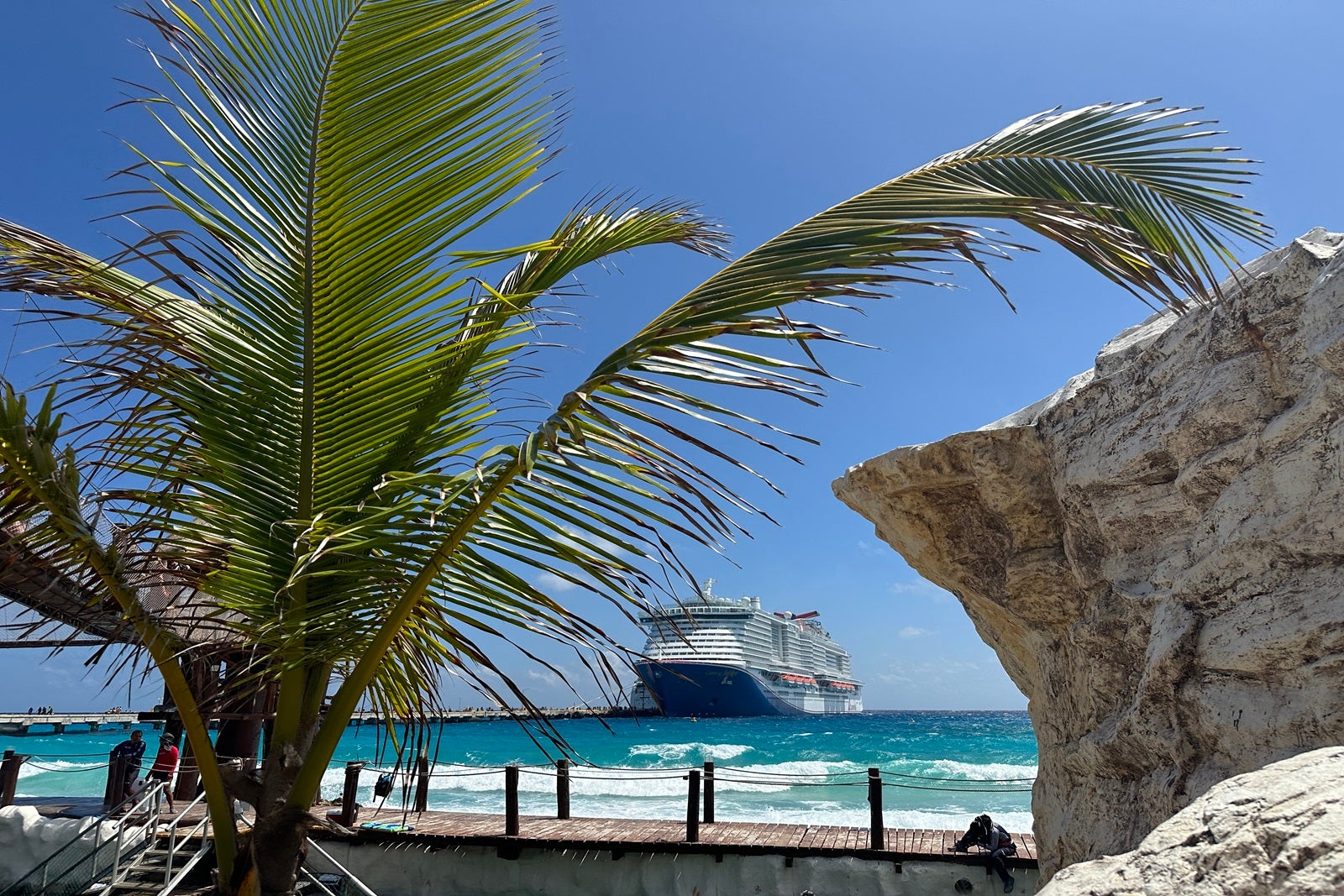
Carnival Jubilee is a megaship, coming in at 183,521 tons and carrying up to 6,631 passengers at full capacity. It's tied with Carnival Celebration for the title of the largest ship in Carnival's fleet.
The vessel offers weeklong Caribbean voyages on a regular rotation from its home port in Galveston, Texas, meaning you'll find a healthy dose of Texas-style fun on board (more on that later). In fact, Carnival is so dedicated to keeping the ship in the Lone Star State that it had a Texas star painted on the ship's hull.
Carnival Jubilee's demographics run the gamut from families with young kids or extended family groups to groups of friends, couples and even solo cruisers (even though it doesn't have any cabins for singles). True to the rumors about Southern hospitality, the people on my cruise were some of the warmest and most polite I've ever encountered; fellow passengers were saying "excuse me," allowing others to go first in line and generally being more courteous than I've found on sailings from other places.
The ship is divided into six zones, where passengers can find a mix of bars, restaurants, live performances, water-filled fun and exhilarating activities like a ropes course, minigolf and, of course, the Bolt roller coaster . Here's a bit about each zone.
Carnival Jubilee zones
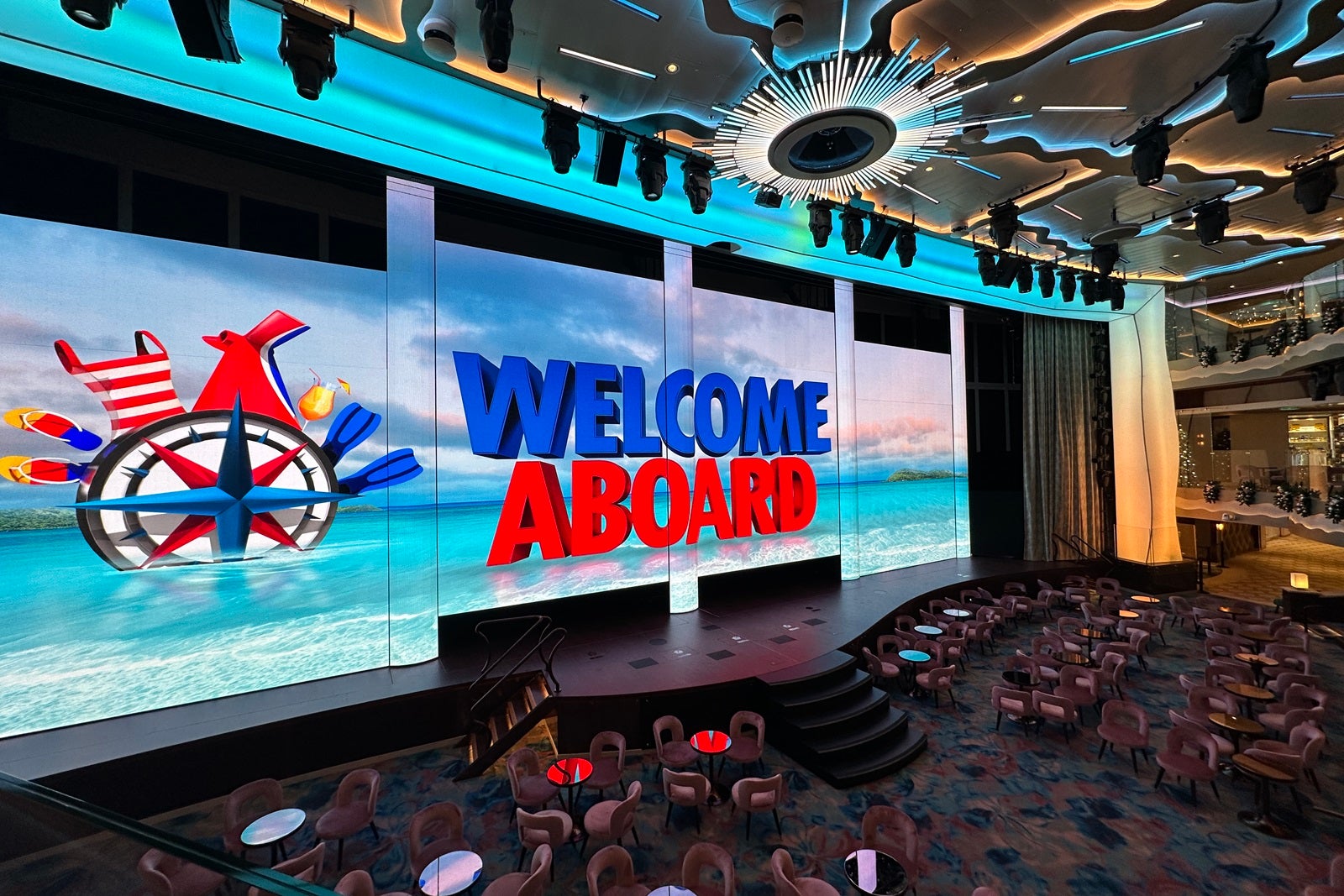
Grand Central: This bustling area rises up three decks — decks 6, 7 and 8 — and replaces the traditional atrium found on older Carnival vessels. The focal point is Center Stage, a starboard-side (on your right when facing the front of the ship) secondary theater that's home to events like bingo during the day and song-and-dance performances at night.
Surrounding the stage are tons of seating options, as well as JavaBlue Cafe, which serves coffee and snacks; Cherry on Top candy shop; the Center Stage and Grand View Bars; and Bonsai Sushi and Teppanyaki. It also serves as an access point for the onboard shops, Piano Bar 88, The Punchliner Comedy Club and the Jubilee Casino.
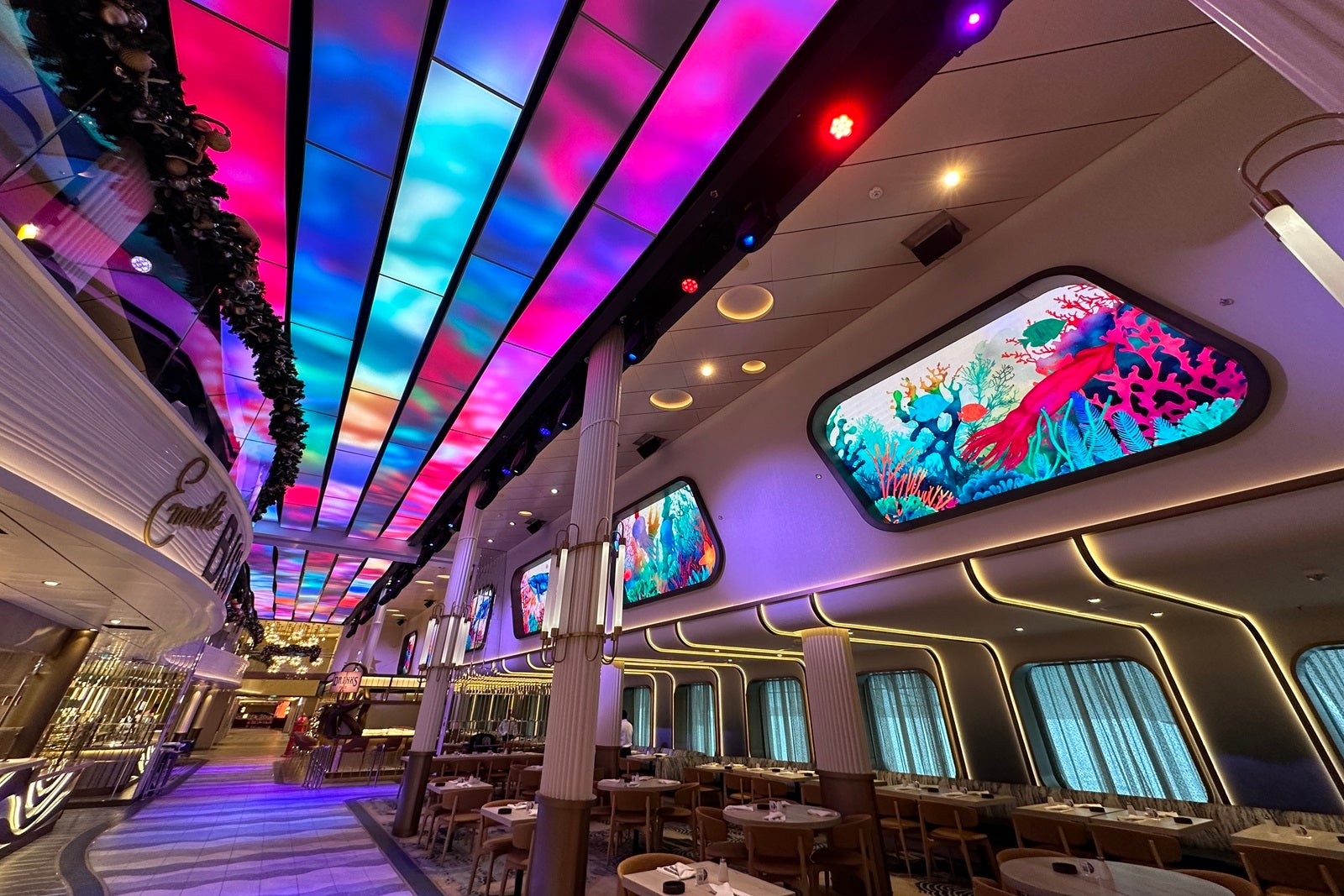
Currents: Currents is one of the other main social hubs on Carnival Jubilee. It starts on Deck 6, just aft of Grand Central and features two new bars. The Golden Mermaid has gilded decor and a custom-designed mural depicting mermaids and lots of hidden Easter eggs (look for SpongeBob SquarePants references). Meanwhile, Dr. Inks, Ph.D., is a bar based on the fictional character Dr. Inks — an octopus with academic credentials. Both bars have excellent drink menus.
Also in the space is Emeril's Bistro 717, a New Orleans-style, for-fee eatery developed by celebrity chef Emeril Lagasse.
On the wall above Dr. Inks, window-shaped screens provide a show for anyone passing through the length of the Currents promenade area. Programming rotates between underwater adventures, nature scenes and even artwork produced by passengers and kids from St. Jude's Children's Hospital. For a better view, head up one deck to the Alchemy Bar.
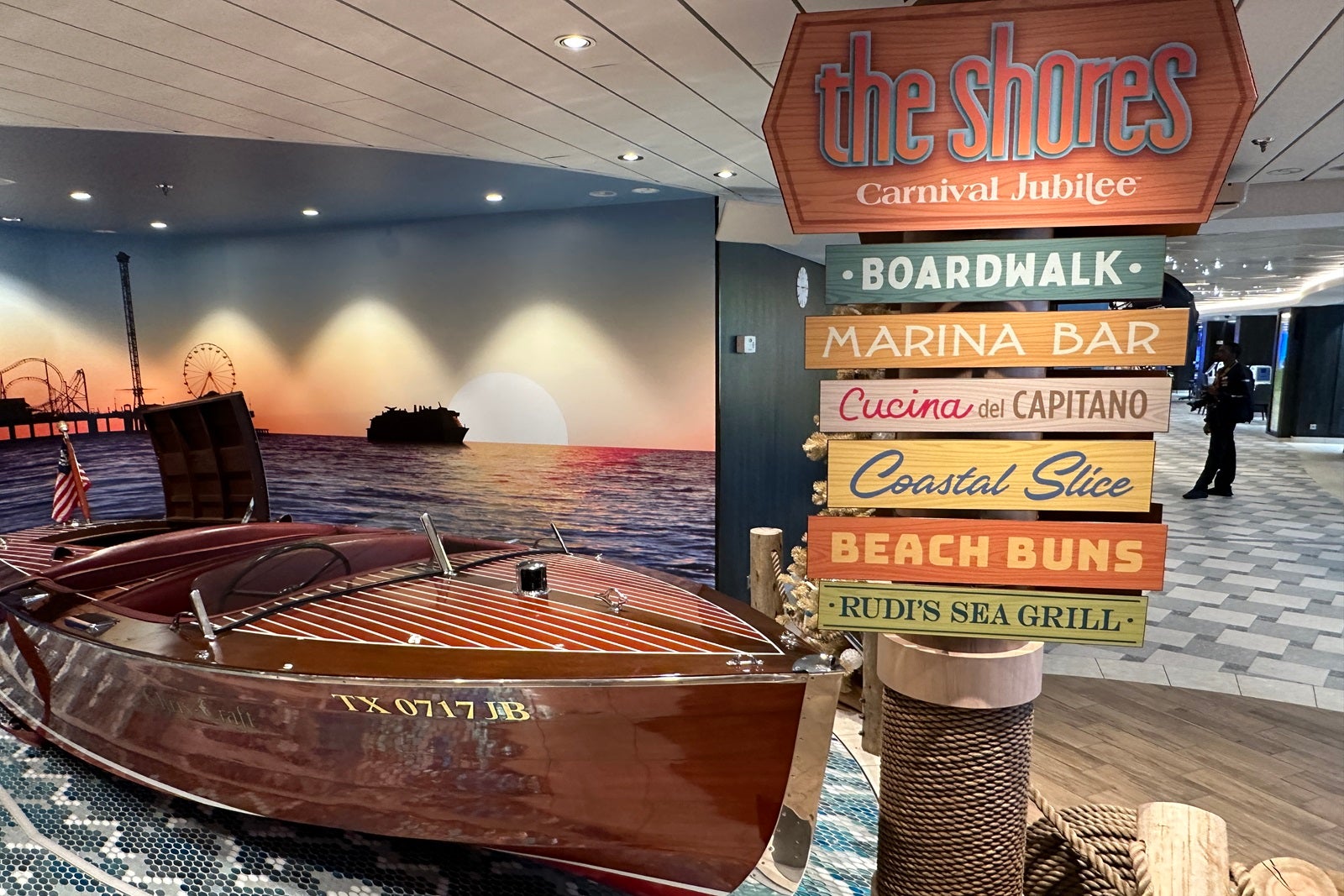
The Shores: If the Currents zone is the underwater-themed area of the ship, The Shores on Deck 8 is what you get when you pop your head above the metaphorical surface. Inspired by boardwalks and beaches, The Shores offers two walk-up food counters: Beach Buns (Carnival Deli on other ships) and Coastal Slice (the equivalent of Pizza Pirate or Pizzeria del Capitano). Offset by colorful, blinking carnival-style lighting, the venues all but scream, "Step right up!"
Other venues in the area include the Marina Bar for cocktails and coffee, complimentary Italian restaurant Cucina del Capitano and for-fee seafood eatery Rudi's Seagrill, created by food pop artist chef Rudi Sodamin.
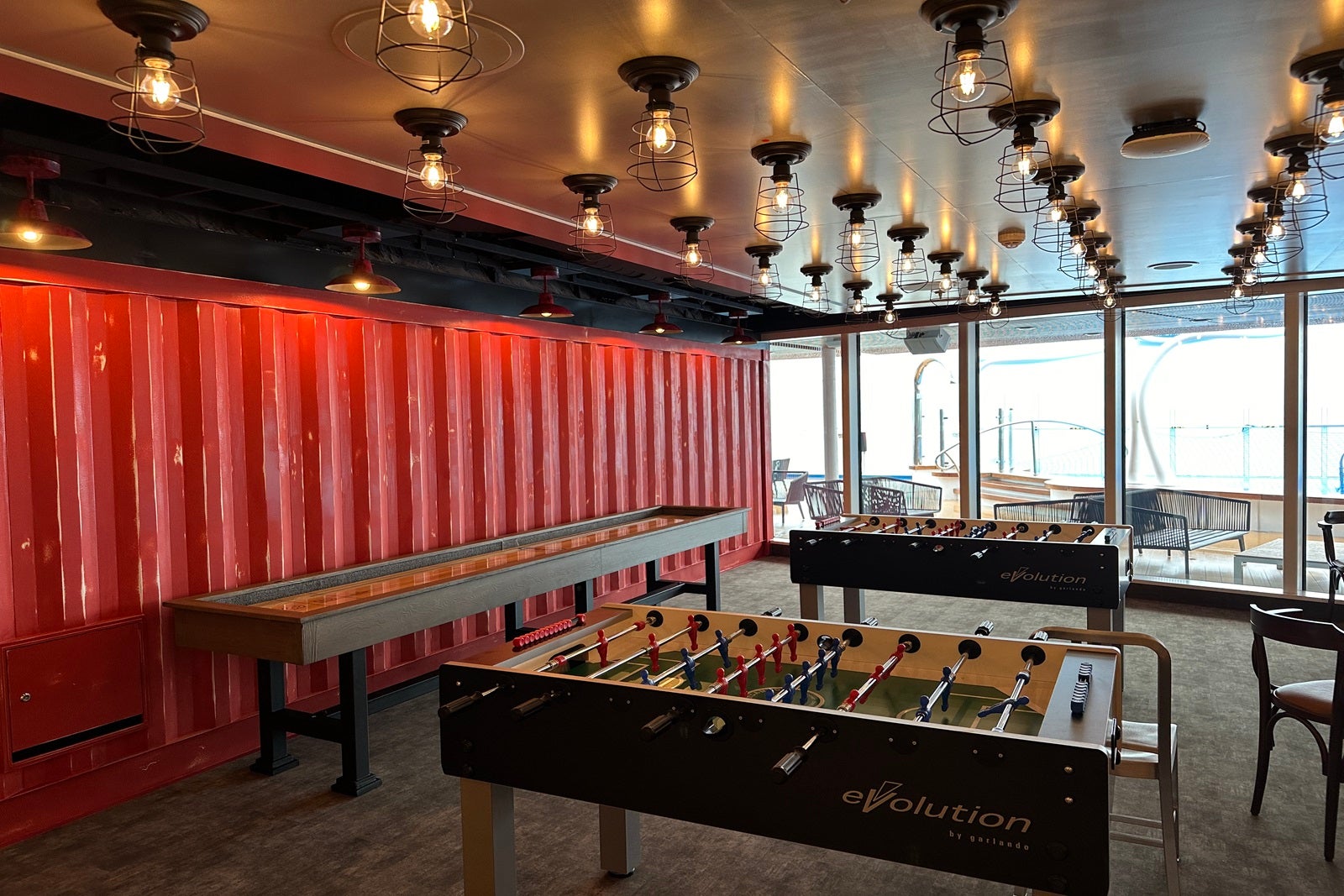
Summer Landing: From The Shores, continue aft on Deck 8 to reach Summer Landing. It's an indoor space that encompasses Guy's Pig & Anchor Smokehouse Brewhouse, a Guy Fieri barbecue joint with its own microbrewery and live music; the Heroes Tribute Lounge, which honors members of the military; and soft-serve ice cream.
Outside, the area continues with The Patio, which features a pool and hot tubs, and neighboring The Watering Hole, a bar that serves the space.
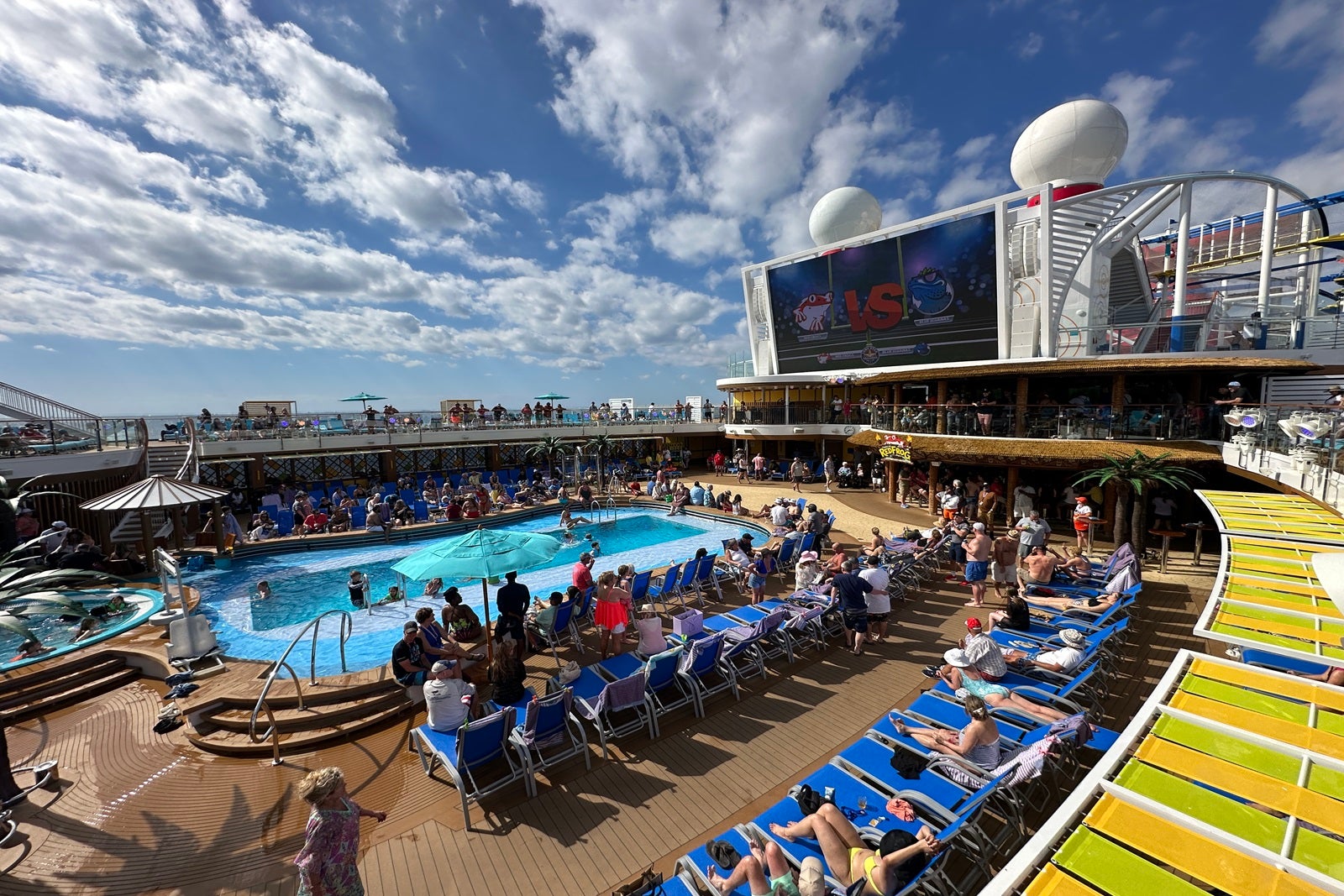
Lido: A mix of food and fun, the Lido zone fans out on decks 16 and 17 around the ship's main Beach Pool, which serves as the center of the action. Around and above it, you'll find outdoor movies, dedicated teen hangouts, a video arcade, a two-story version of the RedFrog Tiki Bar, cruiser favorite BlueIguana Cantina, extra-fee Seafood Shack and Street Eats street food.
On the upper deck is the popular Guy's Burger Joint, which is oddly set a bit farther away from the action on Excel Class ships. Farther afield on Deck 16, passengers can check out Shaquille O'Neal's Big Chicken restaurant or venture to Lido Marketplace, the ship's complimentary buffet.
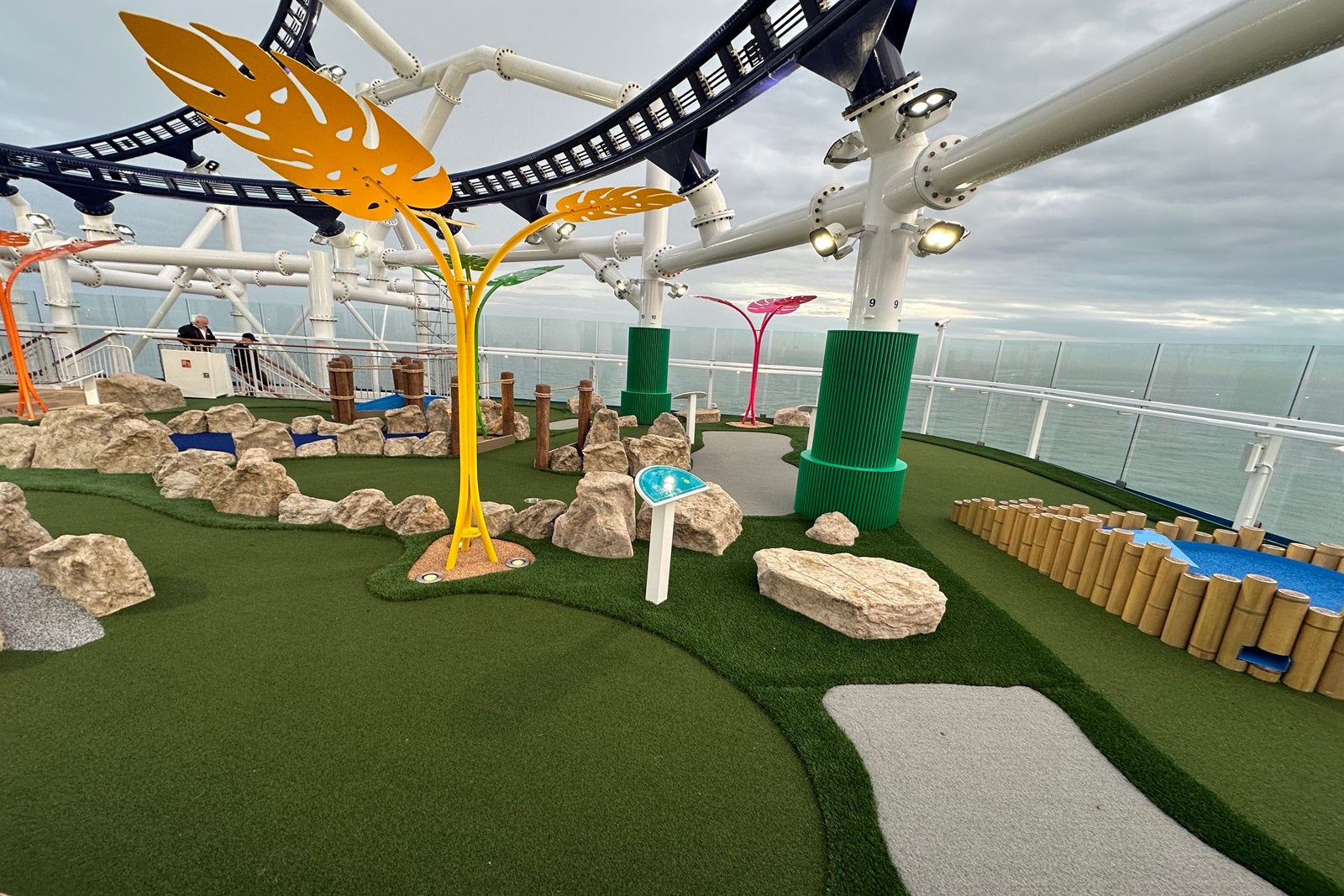
The Ultimate Playground: If you're looking for alfresco thrills to keep you busy, The Ultimate Playground is the place to be. It comprises a miniature golf course, a basketball court, a ropes course and the line's signature WaterWorks water park, all of which are free.
Of course, the highlight of this zone is the Bolt roller coaster. It's an added-fee experience during which passengers (one to two people per ride) zoom twice around the track on a motorcycle-style vehicle that allows you to throttle up or down to a speed that suits you.
What I love about Carnival Jubilee
Grand central.
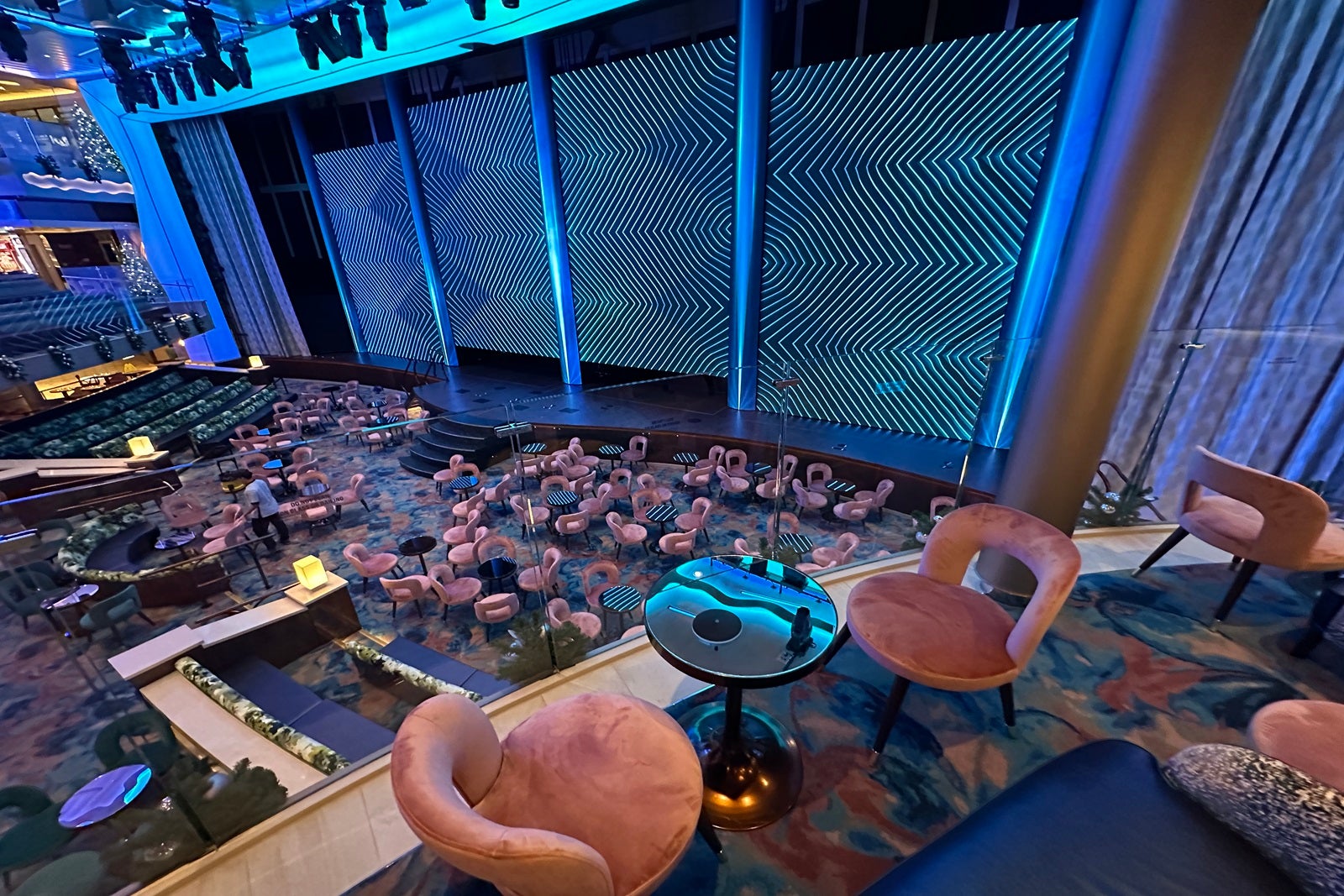
Grand Central is one of my favorite spots on board. Although it's often loud, busy and difficult to navigate, especially on sea days, it's a prime place to sit and people-watch. I found myself gravitating there repeatedly to enjoy coffee or a snack from the nearby JavaBlue Cafe while watching the cast from that night's show rehearse at Center Stage — something you can't usually do on other ships.
Plus, the space is a bit of a throwback to the days when interior designer and architect Joe Farcus was responsible for Carnival's ship decor. The decor is midcentury modern style meets '80s quirk, featuring a pink and teal color scheme, fun light fixtures and a bar with colored mirror accents.
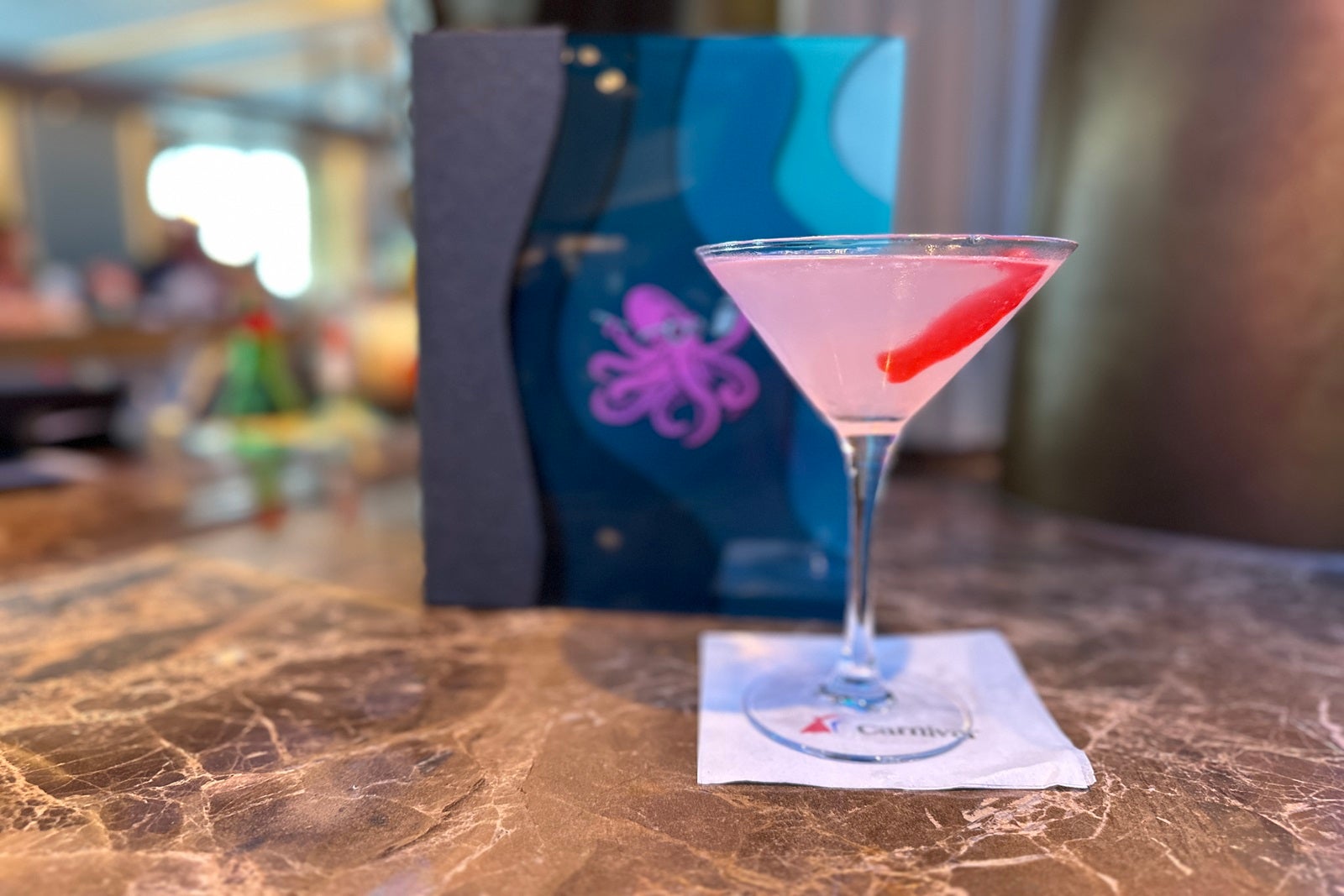
I'm not generally someone who cares about alcohol. Give me one or two pina coladas on a weeklong cruise, and I'm good to go. However, the massively creative options on the menus at both the Golden Mermaid and Dr. Inks, Ph.D., bars are absolutely worth a shoutout.
For the wow factor, the best drink I had was A Pearly Bubble. Found on the menu at the Golden Mermaid, it's a mix of gin, St-Germain liqueur, white cranberry juice, dragon fruit and lime juice. It was a bit too dry for me, so I didn't care for the taste; however, you won't want to miss the presentation, which involves a giant bubble atop the drink. It pops when you poke it, leaving behind a tiny poof of smoke.
For taste, which I know is subjective, my favorite is the Crimson Catch (Swedish Fish candy-infused vodka, lime juice, pomegranate liqueur, white cranberry juice and Swedish Fish candy). I prefer sweet drinks, and this hit the spot.
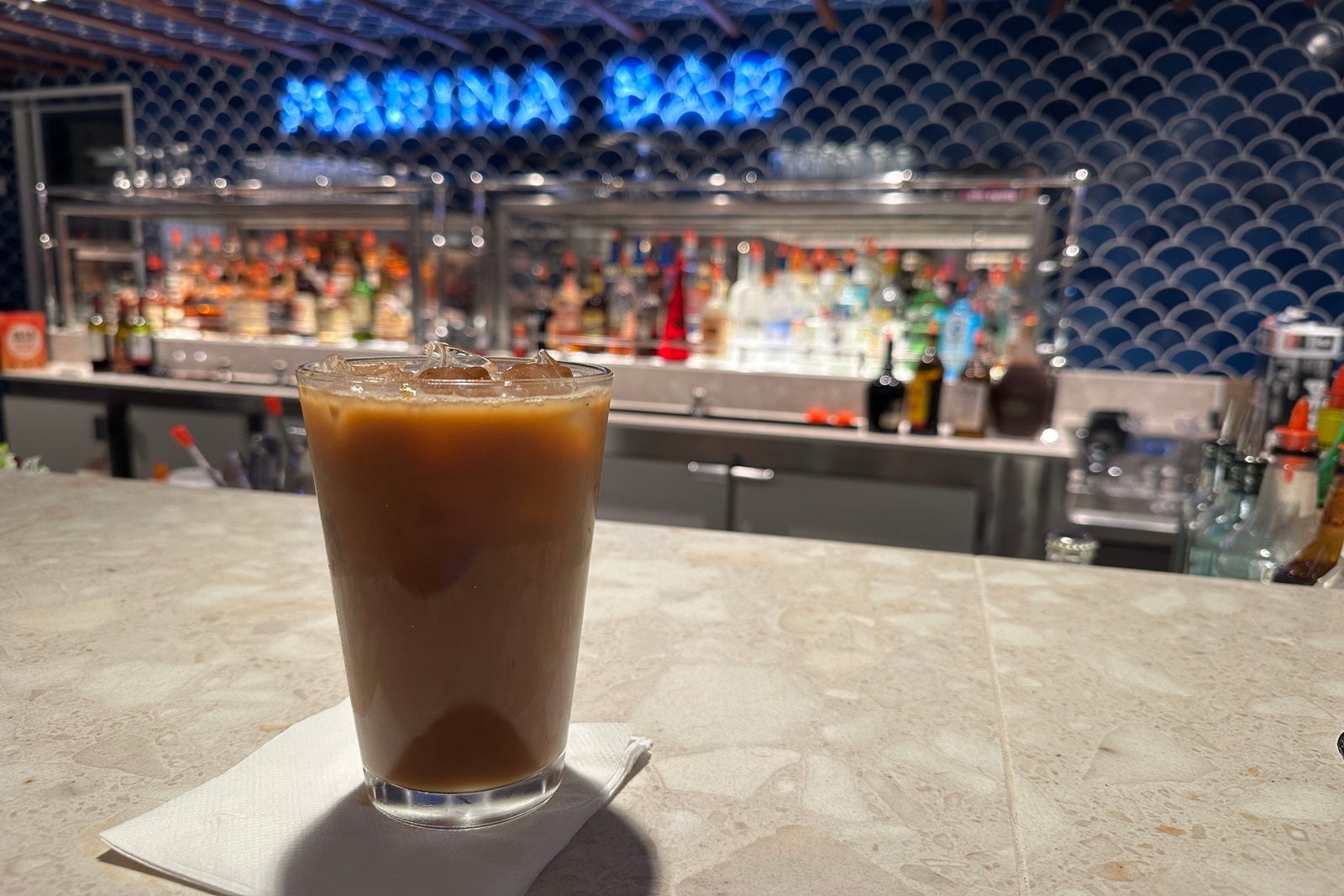
It's not unusual for the line at JavaBlue to snake around the corner and down the hall at peak times. The staff members try their best to keep things moving, but if you don't feel like waiting 10-15 minutes for a cuppa, head upstairs to Deck 8's Marina Bar instead.
There, you can order any of the same coffee beverages you'll find at JavaBlue but in far less time. If you're feeling more like a cocktail, you can grab one of those, too. On my sailing, the bartenders were phenomenal and even remembered that I prefer non-dairy milk with my lattes.
Bolt roller coaster
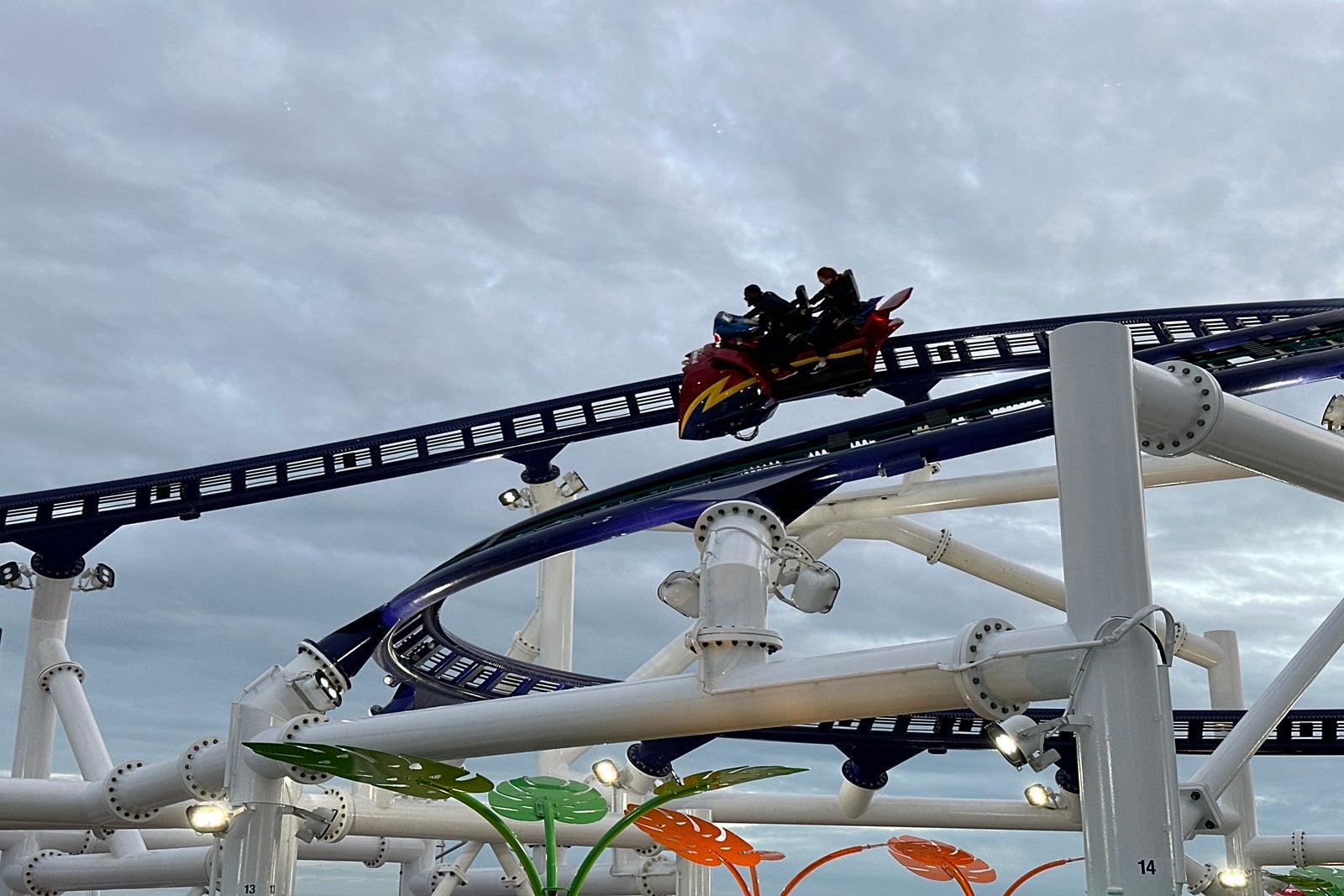
Cruise fans know that Carnival brought Bolt, the first-ever roller coaster at sea, to Mardi Gras in 2021. Carnival Jubilee offers the same ride — the third of its kind on a cruise ship — in the deck 18, 19 and 20 Ultimate Playground area.
Pay a fee to ride, and you (or you and a friend) can navigate two laps of twists and turns around the ship's funnel as you use the throttle and hyper-boost buttons to try to break the day's speed record. (Yes, you'll be timed, and don't forget to smile for a photo.) The ocean views from above are totally worth the cost.
What I don't love about Carnival Jubilee
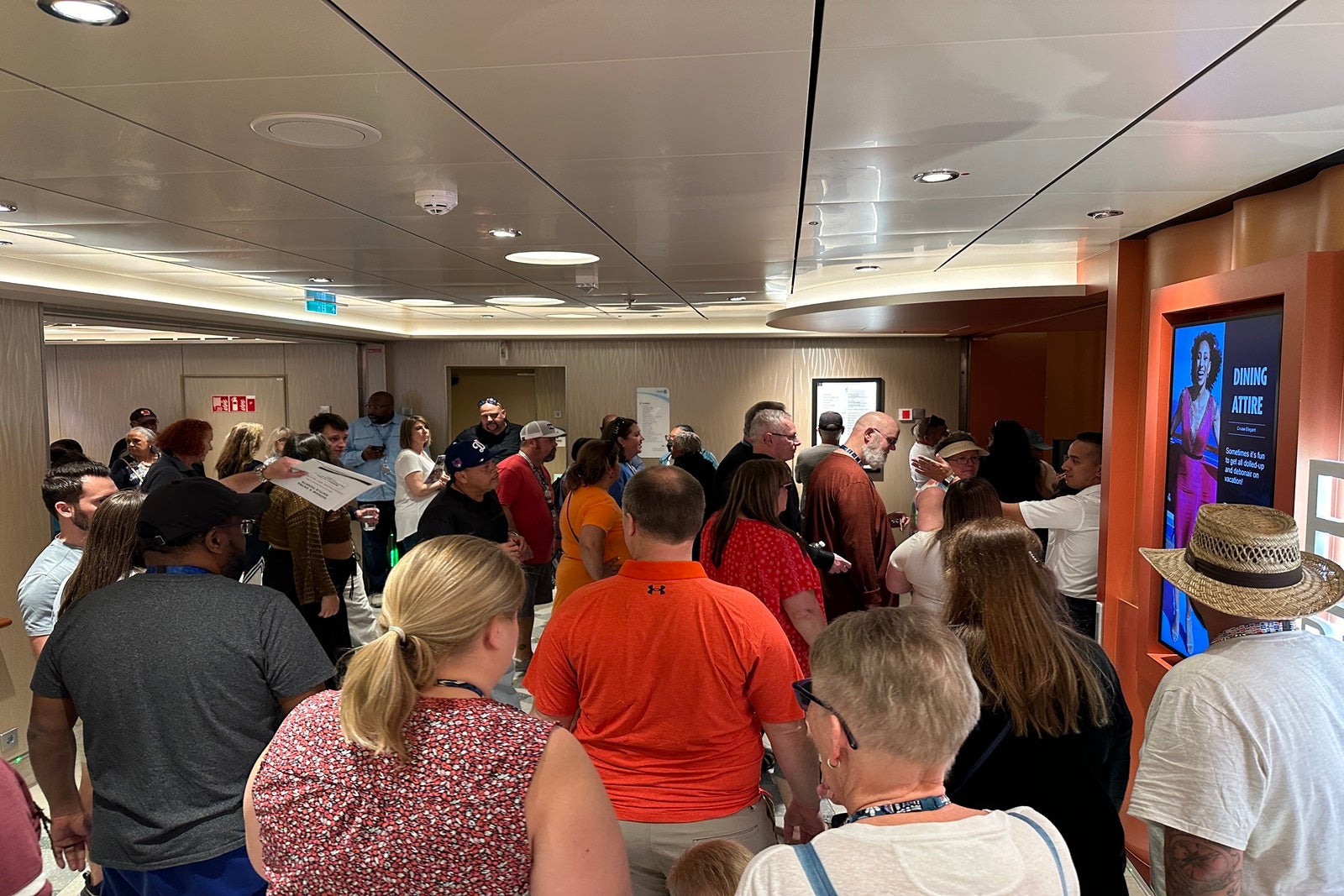
There's no easy way to say this: The ship almost always feels crowded. If you want to enjoy it when it's not, you'll have to stay on board during port calls just to find some space to yourself. Many restaurants and walk-up counters have near-constant lines, particularly at the complimentary venues during peak dinner times every evening.
It's so common for JavaBlue to be backed up throughout the day that an easy-to-miss sign directs passengers to other locations where they can grab a cup of coffee. Meanwhile, lines at the onboard deli and pizzeria counters frequently snake so far down Deck 8 that they block the entrance to seafood restaurant Rudi's Seagrill. One night, as I was dining at Rudi's with some of my travel companions, we joked that the lines were dangerously close to melding with the line for the nearby guest services desk.
And it isn't just a problem with dining. I arrived 15 minutes early for a magic show at the Punchliner Comedy Club, and I couldn't find a single available seat in the entire place. On another night, I showed up on time for Family Feud Live in the ship's theater, and it was a standing-room-only situation. The sizes of the performance venues are generally way too small for the number of passengers wishing to watch the shows.
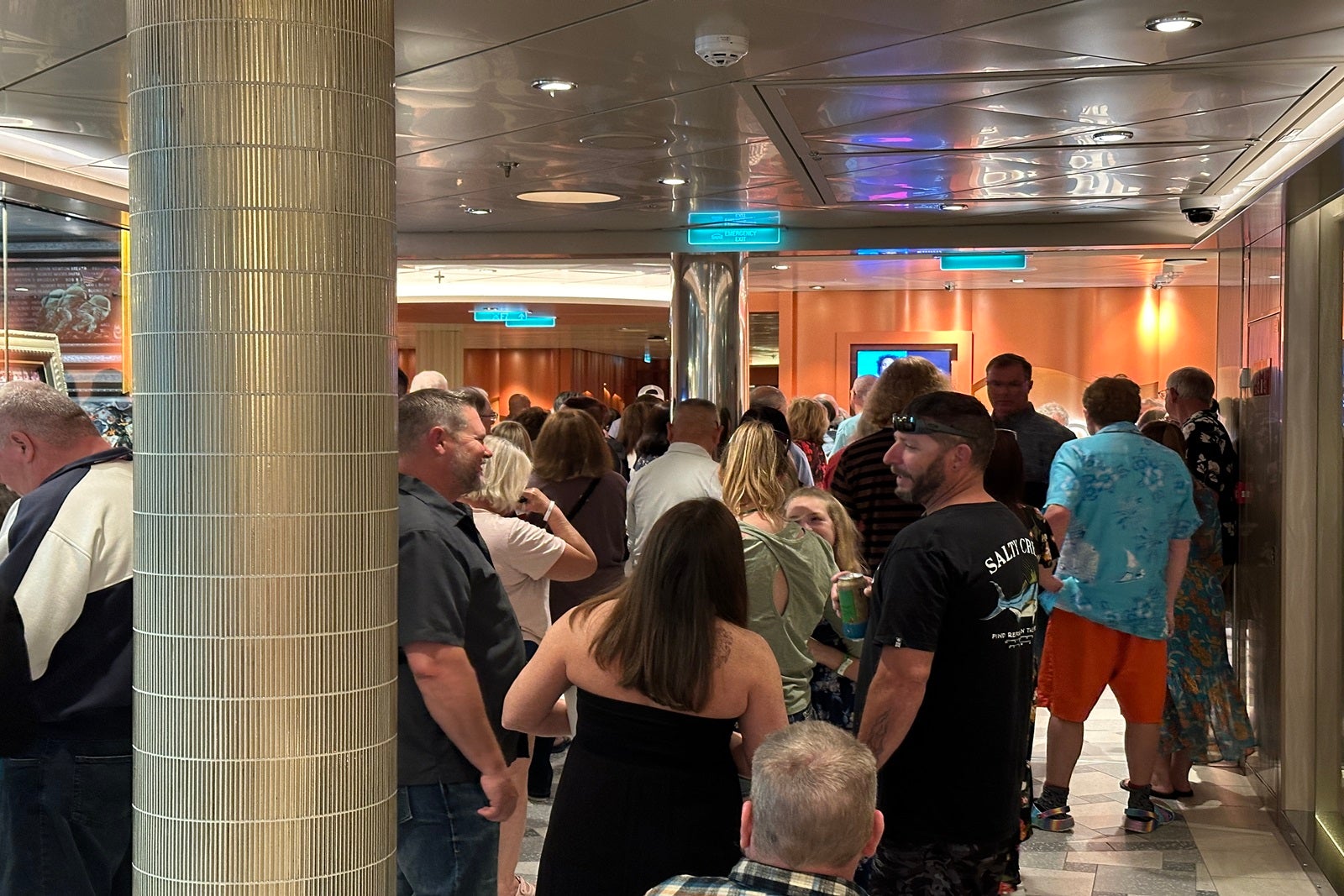
My cabin had some of the best soundproofing I've experienced on a new ship in a long time — I had balcony accommodations near an elevator bank and heard nothing when I was in my room. However, a couple of passengers told me they could hear noise from Bolt in their balcony cabin on Deck 15.
Most other places on board seem to be excessively loud. Even on port days, when most passengers are ashore, the public areas are filled with loud music that makes it hard to find a quiet escape. Some of it is understandable. After all, Carnival vessels are known as the Fun Ships, but some of it seems unnecessary.
One example is the Dr. Seuss-themed Seuss-a-palooza Parade that makes its way through the Currents zone once per sailing. I happened to be sitting at a table in the area when the festivities kicked off. I decided to stay to see what it was all about, and I'm sorry I did. As costumed Dr. Seuss characters arrived, Carnival staff asked the children to scream solely for the sake of screaming. Ear-piercing shrieks reverberated throughout the space, which was also blocked off to passengers trying to pass through.
The excessive upselling

Combining noise with the annoyance of hawking alcohol, the roving waiters visited every table at Chibang! — the ship's hybrid Mexican-Asian restaurant — one night while I was having dinner there. Their goal was to push Rumchata shots on everyone. Whenever somebody bought one, the waiter would demand that they yell "Shot, shot, shot!" before downing it. This was extremely disruptive and added to the already loud atmosphere.
One afternoon later in the sailing, two different crew members approached me a total of six times in less than half an hour while I was having lunch on the Lido deck. The first five times, I simply said, "No, thanks." After the sixth time, I had enough and told them nicely but firmly to stop asking me. I found the high-pressure sales tactics excessive and irritating when all I wanted to do was eat my meal in peace.
The inconsistencies

Oddly, there were some discrepancies on board that I was surprised to see on a ship that's been sailing for several months.
The first couple had to do with differences between the Carnival HUB app and the daily Fun Times printed schedule. On one occasion, the app said Seafood Shack opened half an hour earlier than it did, while the paper version of the daily schedule had the correct information. Another time, the printed daily had the wrong theater show listed for that night; the correct one was posted in the HUB. On another day, the printed schedule was missing part four of a four-part show, which did show up on the agenda in the app.
In terms of food and drinks, I had a strange experience at Chibang! when I ordered spring rolls. Usually, they don't have meat in them, nor was meat listed as an ingredient on the menu. When the waiter took my order, he said, "Spring rolls with chicken." When I asked him about it, he said he could request for them to be made without it, but that doesn't explain why something with meat in it wouldn't have meat in its list of ingredients. If I were a vegetarian or vegan, it would have concerned me.
As for drinks, I ordered a Snapping Pop at Dr. Inks., Ph.D. It was completely different — different color, different taste and different presentation — from what I received when I ordered the same drink on a sailing two months prior. I was told the drink had to be changed for several reasons. However, the old ingredients were listed on the menu, meaning passengers weren't getting what they thought they ordered.
Carnival Jubilee cabins and suites
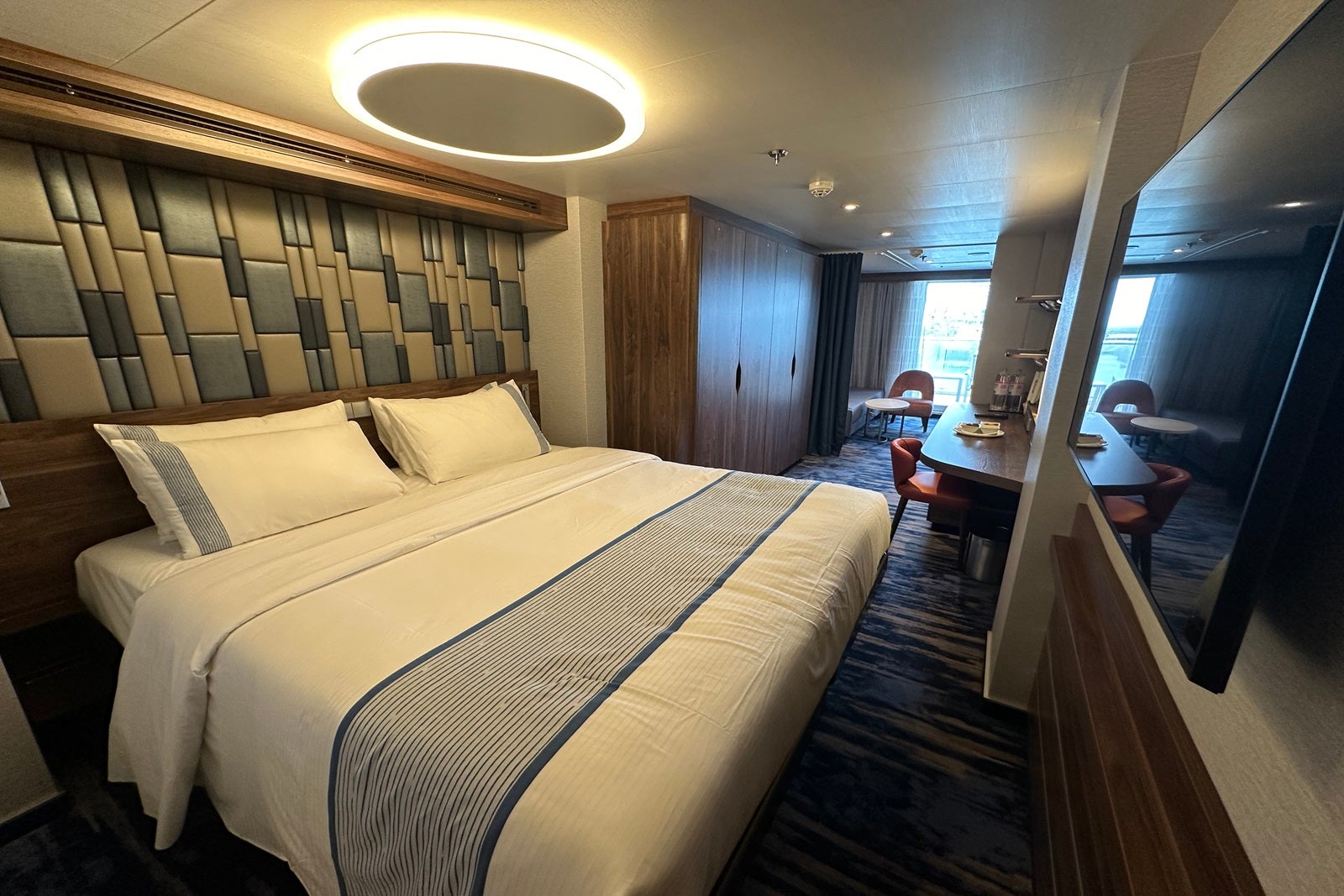
Carnival Jubilee offers cabins in the usual varieties: insides with no windows or balconies, ocean-view accommodations with windows, balcony cabins with outdoor veranda space and suites that include additional perks. These include priority check-in, boarding and disembarkation; preferred dinner times in the main dining room; pillow-top mattresses; two large bottles of water and bathrobes; and extra square footage.
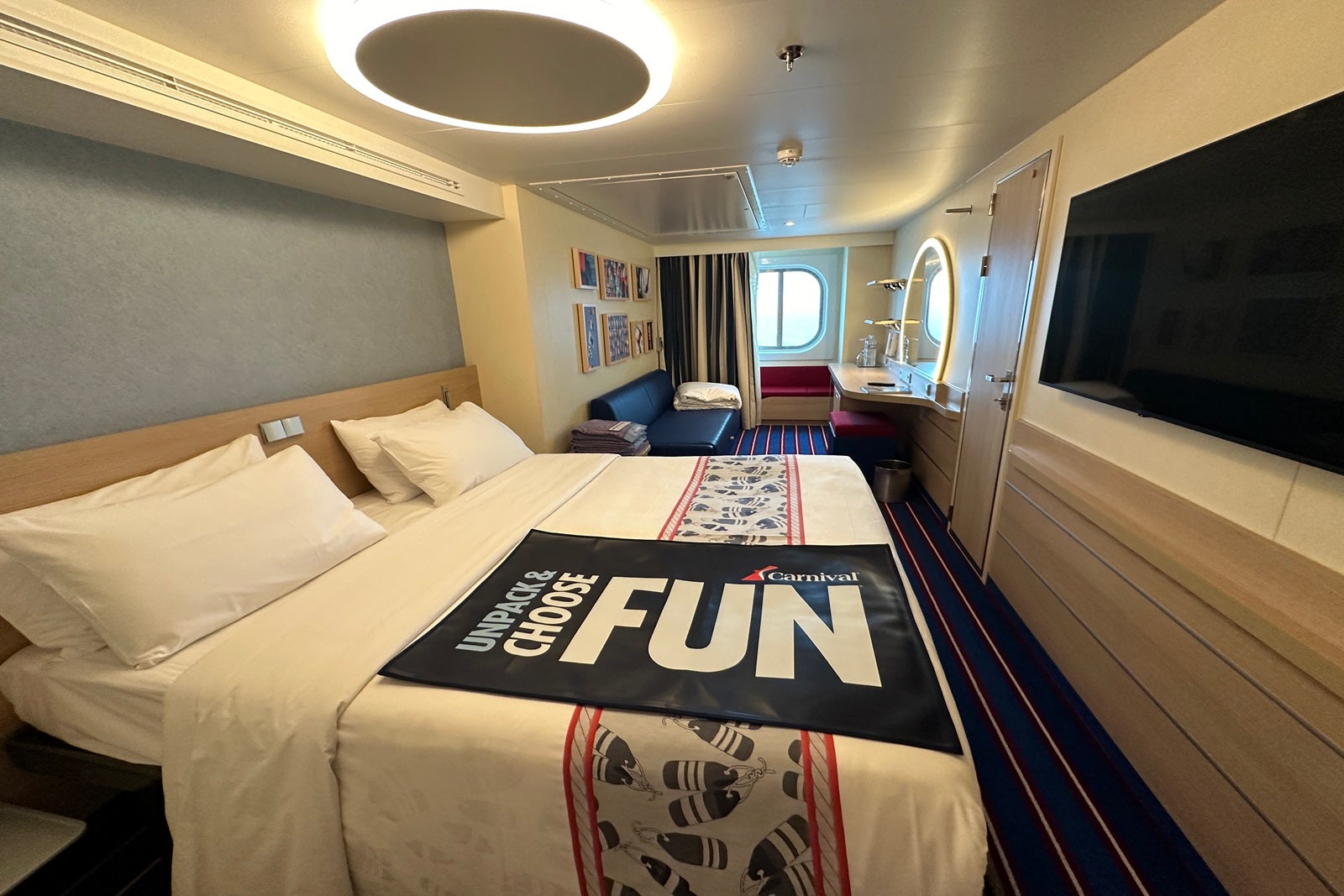
Within those categories, Carnival Jubilee offers three types of special cabins. First is Family Harbor, which offers nautically themed cabins that sleep up to five people and rooms that can be connected via an interior door. Families booked in Family Harbor cabins have access to a dedicated Family Harbor Lounge, which offers daily breakfast, snacks and drinks, as well as board games and TVs with a selection of movies and video games. They also receive a free night of babysitting in the kids club so parents can enjoy some alone time.
The second special cabin type is the Havana Cabana. Done up in bright, tropical colors, these rooms offer extended outdoor lounge space and private access to the Havana Pool and Bar area.
The third type is Cloud 9 Spa cabins. With calming seafoam green and yellow decor alongside extras like Elemis toiletries, bathrobes and slippers, these are some of the most relaxing cabins on any ship. These guests also receive priority spa appointments and free access to fitness classes and the onboard thermal suite.
Suites in all three of these special accommodation types also give passengers the suite perks mentioned above.
Excel Suites, Carnival Jubilee's highest-level accommodations, receive all standard suite perks plus additional ones. These include complimentary access to the private sun deck at Loft 19, priority cabana reservations at Loft 19, concierge services, guaranteed reservations at most extra-fee restaurants, free room service, upgraded toiletries, fruit and sparkling wine upon embarkation, a free soft drink package, free in-room movies, an in-cabin coffee machine and complimentary laundry service .
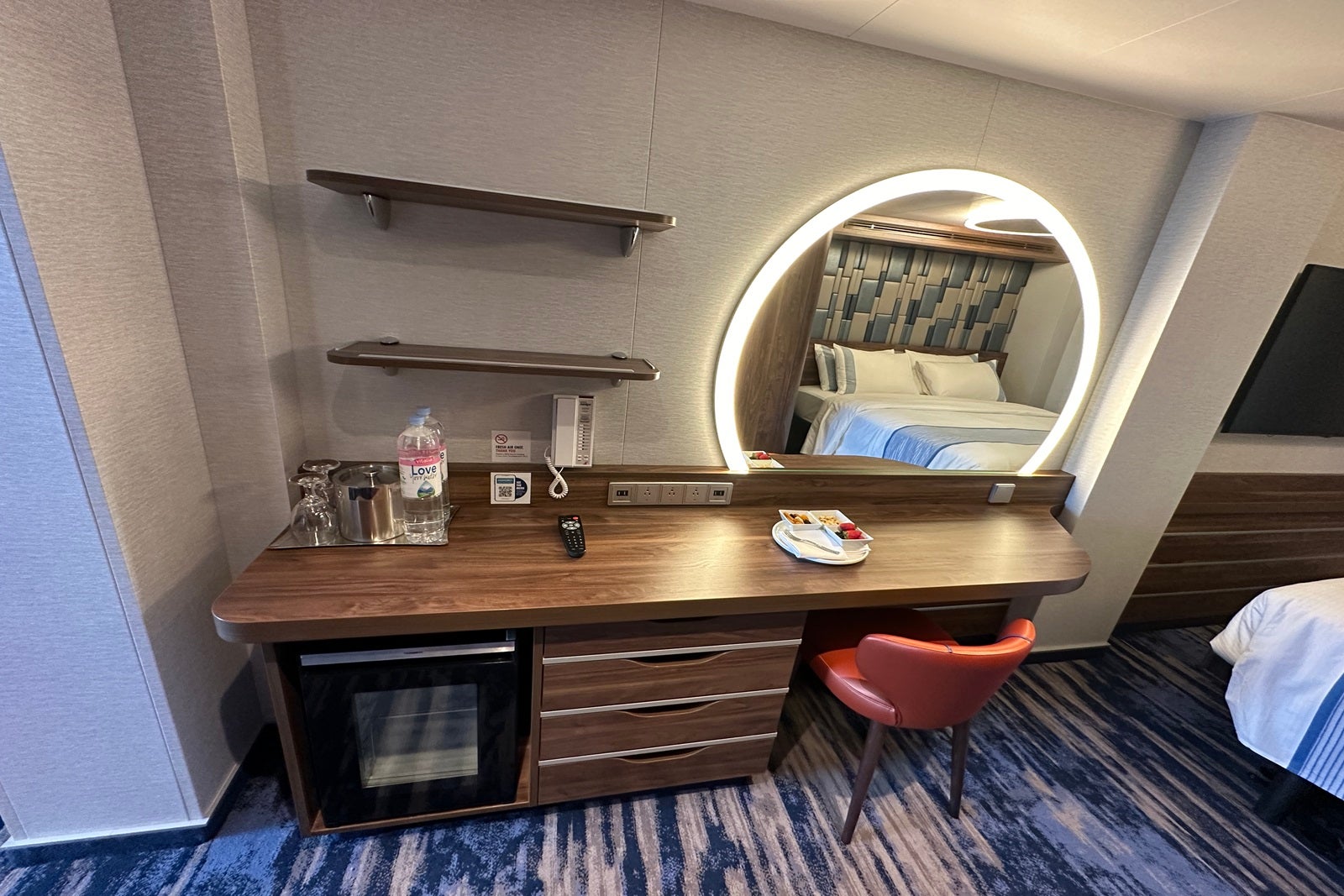
Standard amenities in all rooms include a queen bed that converts to two twins on request, bedside shelving with reading lamps and USB outlets, a desk and vanity area, a sofa or chair, a closet and drawers for storage, a safe for valuables, a house phone and a hair dryer.
Bathrooms feature a toilet, sink and shower with a door instead of a curtain. Complimentary toiletries are basic: bar soap for handwashing and dispensers of shampoo and shower gel mounted on the wall in the shower.
On my sailing, I stayed in a balcony cabin, which was elegantly decorated in neutrals with blue accents. I was pleasantly surprised by the amount of storage space. I appreciated touches like ample vanity mirror lighting, adjustable shelving in the closets and a surplus of USB outlets throughout the room, including near the vanity and beside the bed.
Speaking of the bed, it was exceptionally comfortable, and I was excited to find that the TV across from it had a sizable selection of free movies (as well as newer releases for a fee). The TV also allows you to watch select live channels and shipboard programming and to check your onboard bill.
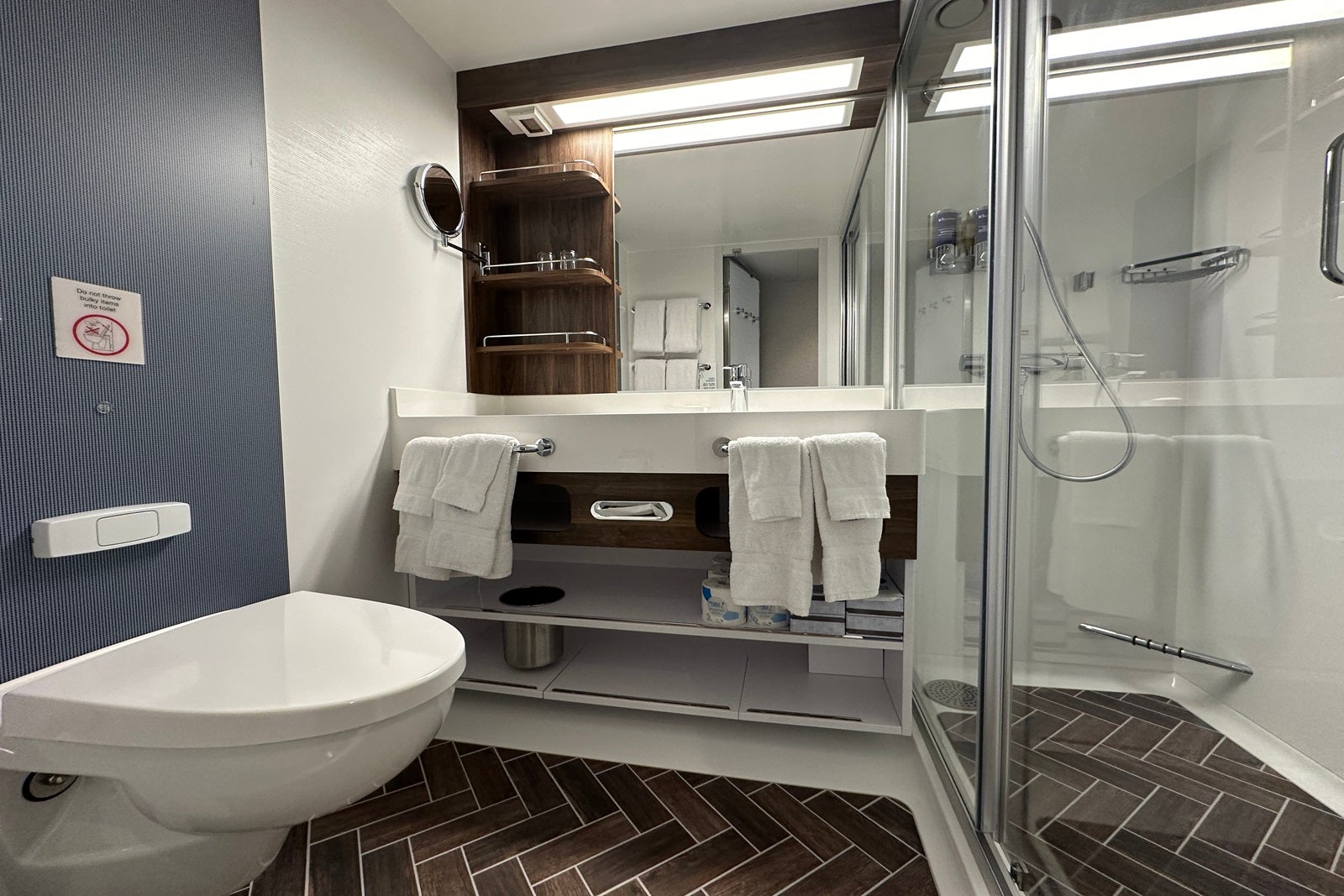
Dislikes for me include a shower door that opens toward you instead of into the shower, making the already tiny bathroom even tighter. I also didn't like the "SNOOZIN'" door hangers, which often got caught in my door when I closed it; I would've rathered a "do not disturb" button like many other new ships have.
I also would have liked a taller table on the balcony, but it only had room for two chairs (not lounger-style) and a small drinks table.
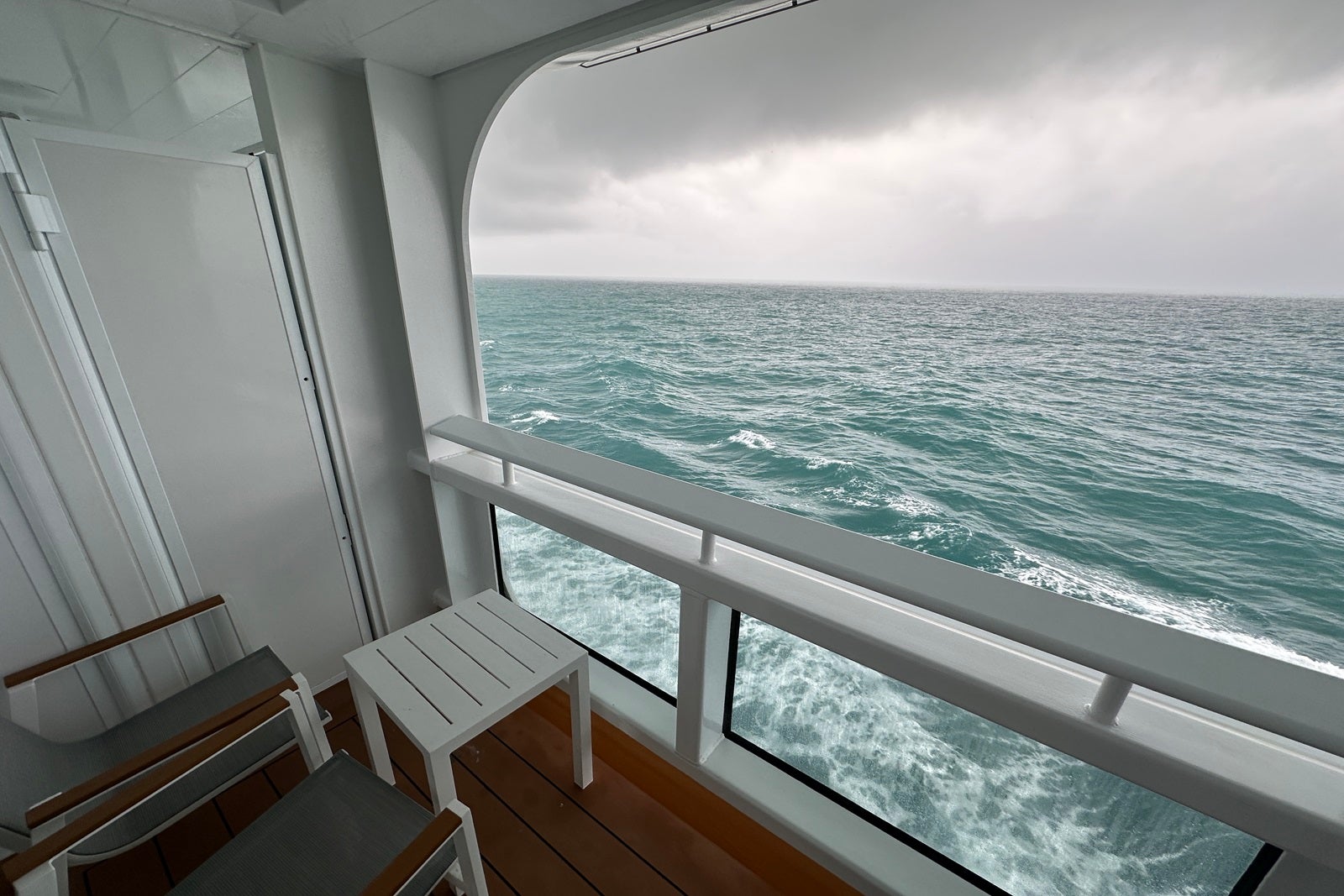
Carnival Jubilee offers 82 accessible cabins in a mix of types and categories: inside, ocean-view, balcony and suite, as well as rooms in the Family Harbor, Havana Cabana and Cloud 9 Spa categories.
Within those 82 options, there are fully accessible accommodations with access to both sides of the bed and rooms that are fully accessible with single-side access to one side of the bed, which work well for passengers who use wheelchairs and scooters. Ambulatory-accessible rooms provide accommodations for people who walk with the help of assistive devices like canes or walkers.
Fully accessible rooms are stair-free, flat-threshold cabins, which offer wider (32-inch) doorways, turning space and bathrooms equipped with grab bars and shower seats.
There are no solo cabins on Carnival Jubilee.
Cabin cleaning is limited to once per day. Unless you specifically request your cabin steward to come at night for turndown service instead of earlier in the day, your room will be made up in the morning. Hang the "SNOOZIN'" card on the outside of your door, and no one will bother you — but your room won't be cleaned that day.
Carnival Jubilee restaurants and bars
Carnival jubilee food.
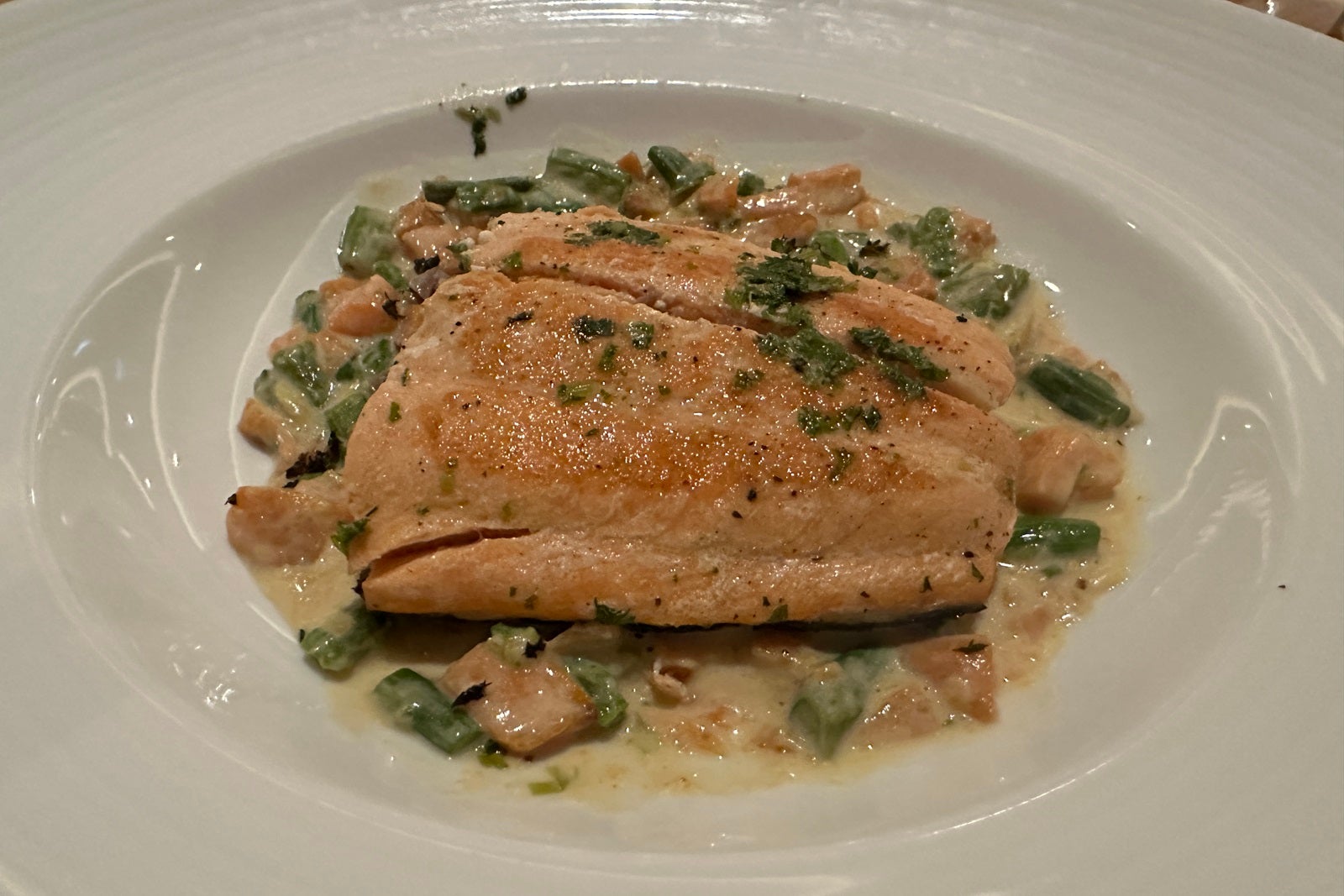
One of the best ways Carnival provides value to its customers is through its food offerings. Complimentary dining abounds on Carnival Jubilee, and the variety of cuisines is impressive. You'll find more free options on Carnival ships than on just about any other fleet's vessels, and they're actually tasty. It's entirely possible to eat only food that's included in the cruise fare and not feel like you're missing out.
Excellent added-fee options include steak, seafood and teppanyaki, which might be worth trying if you're celebrating a special occasion or feeling like a splurge.
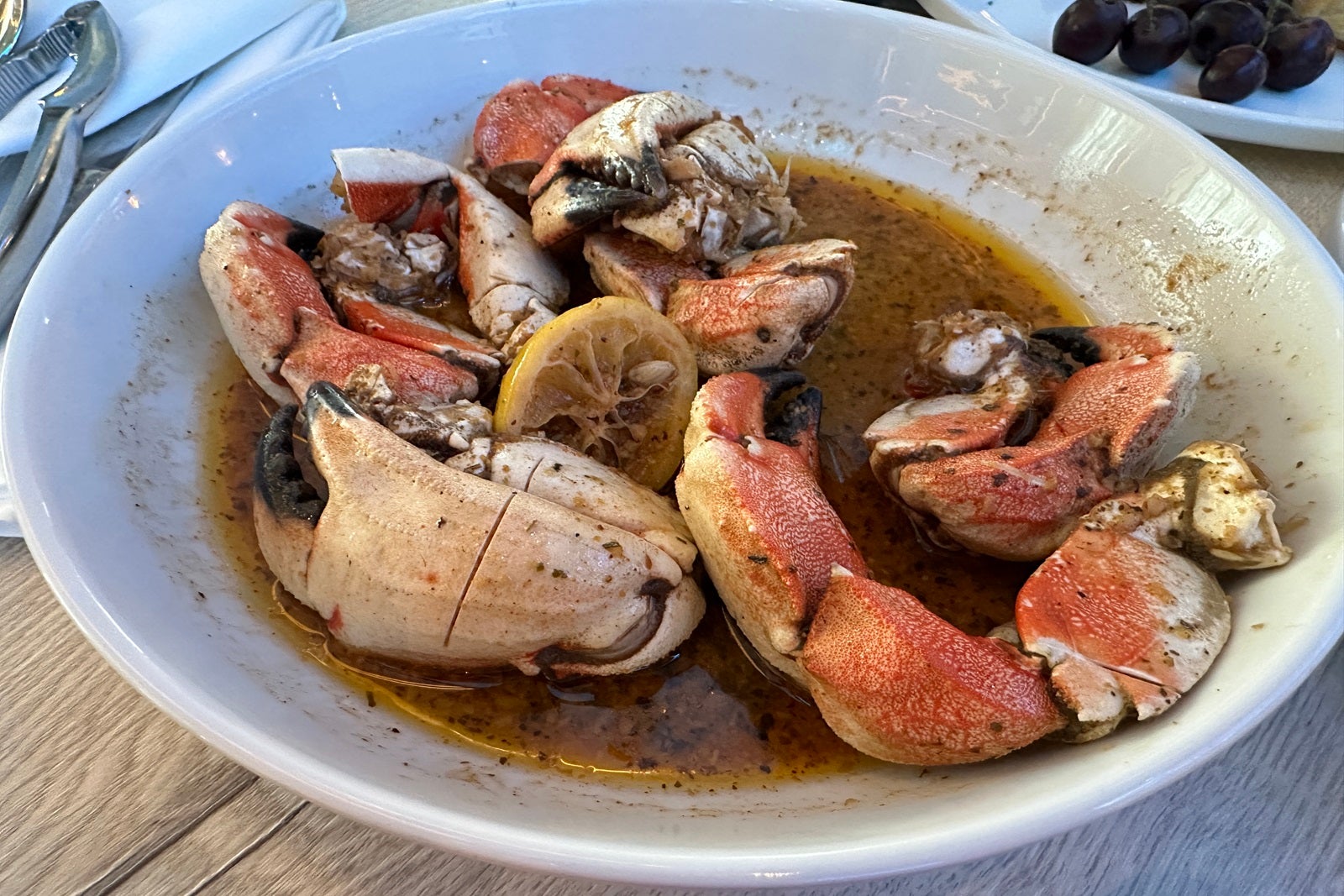
Dinner reservations are recommended for many eateries, even the main dining rooms. You can make them by visiting your restaurant of choice or by using the HUB app. If you don't make one, you might find yourself waiting 20 minutes or more for a table at peak times. If you make a reservation through the app, you'll receive a notification to report to the host stand when your table is ready.
In my experience, waiters were diligent in asking about dietary requirements and restrictions. However, it was disappointing to see that many menus weren't marked with specific options for vegetarians, vegans and people who can't eat gluten.
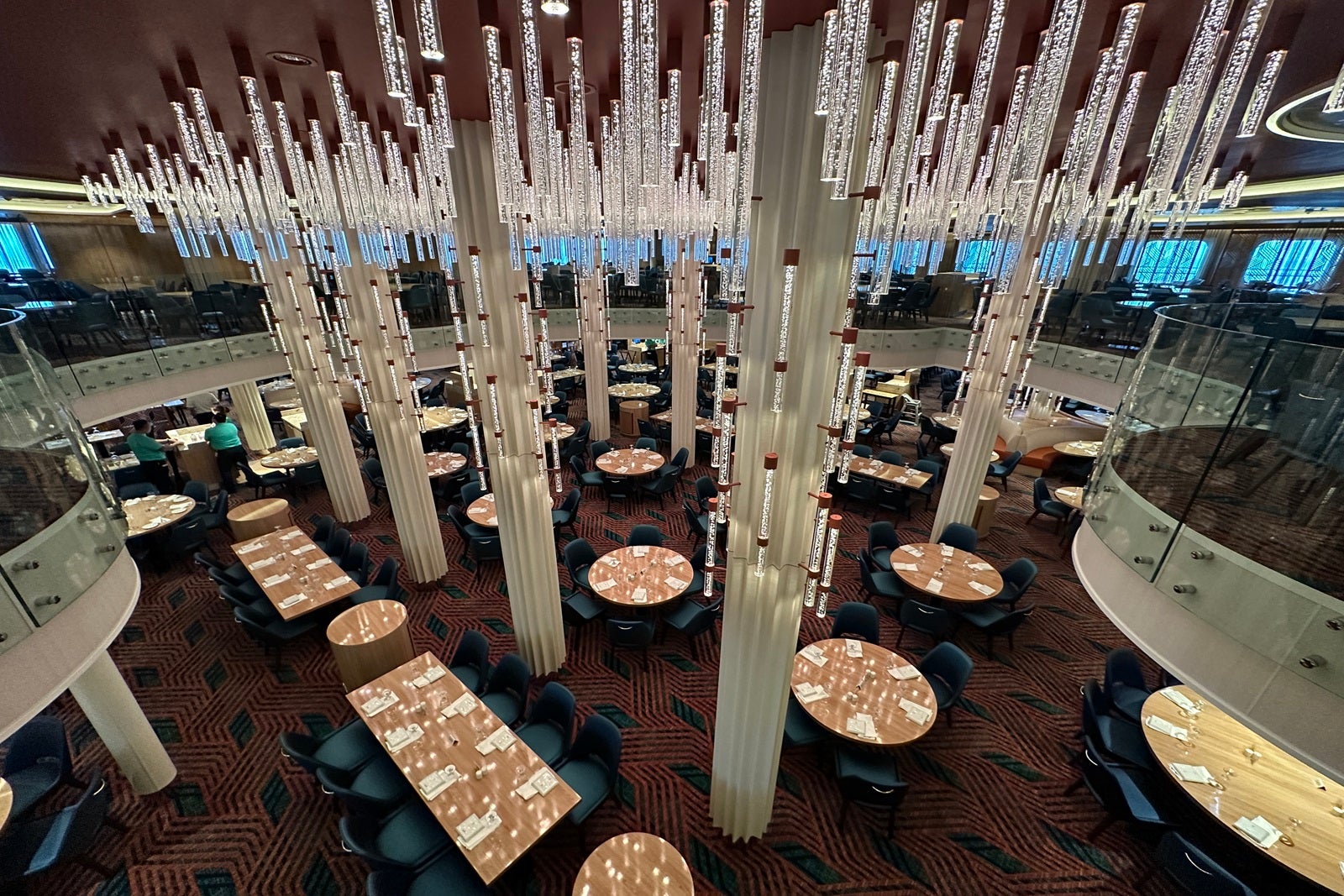
The ship has two main dining rooms: Atlantic Restaurant (Deck 6, mid) and Pacific Restaurant (decks 6 and 7, aft).
One of them is dedicated to passengers who select Your Time Dining, which lets you eat anytime between 5 and 9 p.m. (The dedicated YTD restaurant can vary by sailing, depending on how many people choose that option.)
Both serve the same menu for dinner, but only the larger Pacific Restaurant is open for Sea Day Brunch on sea days and breakfast (but not lunch) on port days.
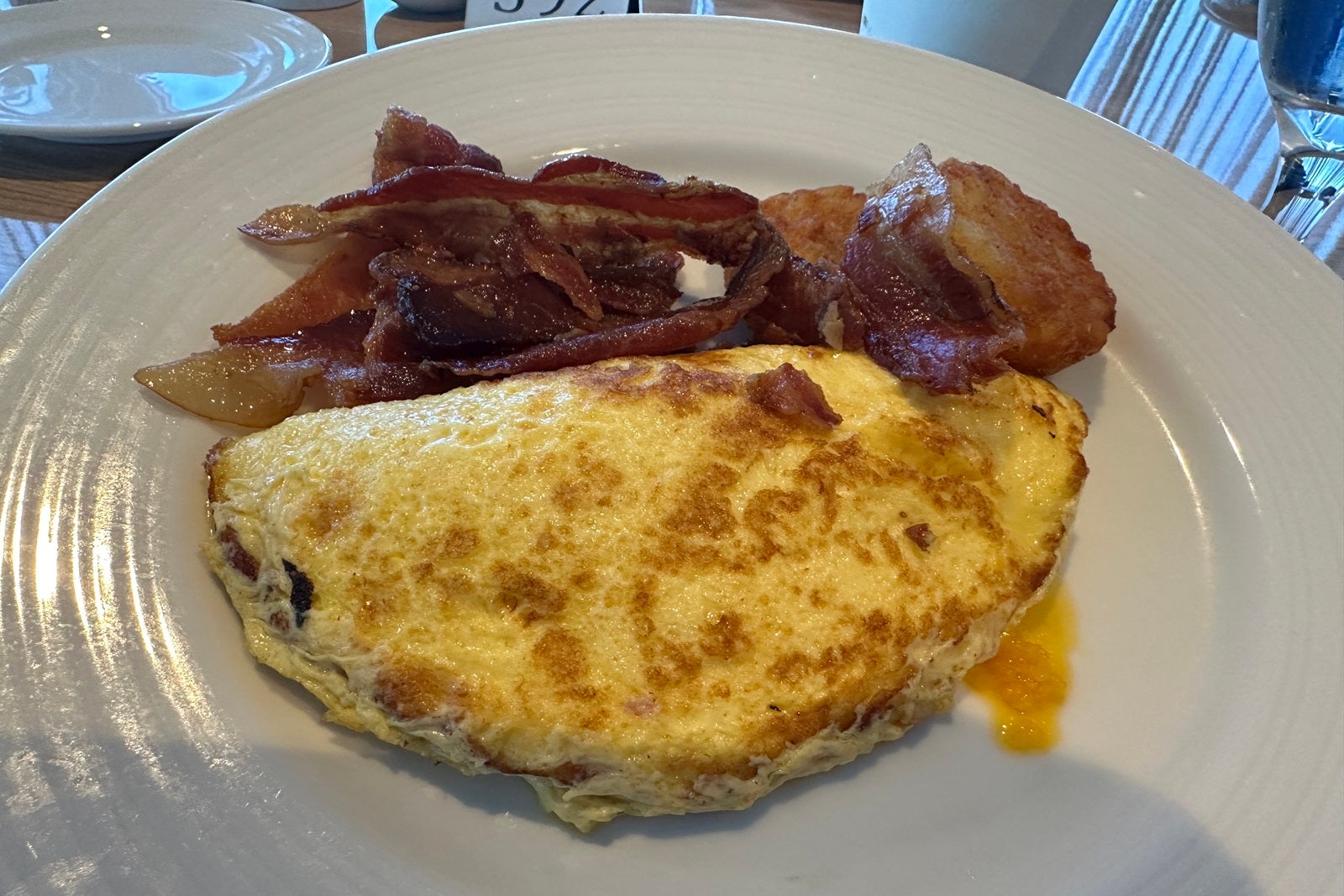
I very much enjoyed an omelet with hashbrowns at Sea Day Brunch and salmon during the formal night dinner in the Pacific Restaurant. I also had a wonderful time at two special events — complimentary afternoon tea and an extra-fee Dr. Seuss-themed Thing 1 and Thing 2 Birthday Breakfast — held in the Atlantic Restaurant.

Tip: If you're a vegetarian or a fan of Indian food, don't miss the daily Indian dish on the main dining room menu.

The buffet is the other free food option that's a staple on just about any cruise.
On Carnival Jubilee, the Lido Marketplace on Deck 16 is open for breakfast, lunch and dinner daily, but I found it largely uninspired and lacking in variety. The French toast I had for breakfast and the mahi mahi I had for dinner were tasty, but there are definitely better no-charge venues on board.
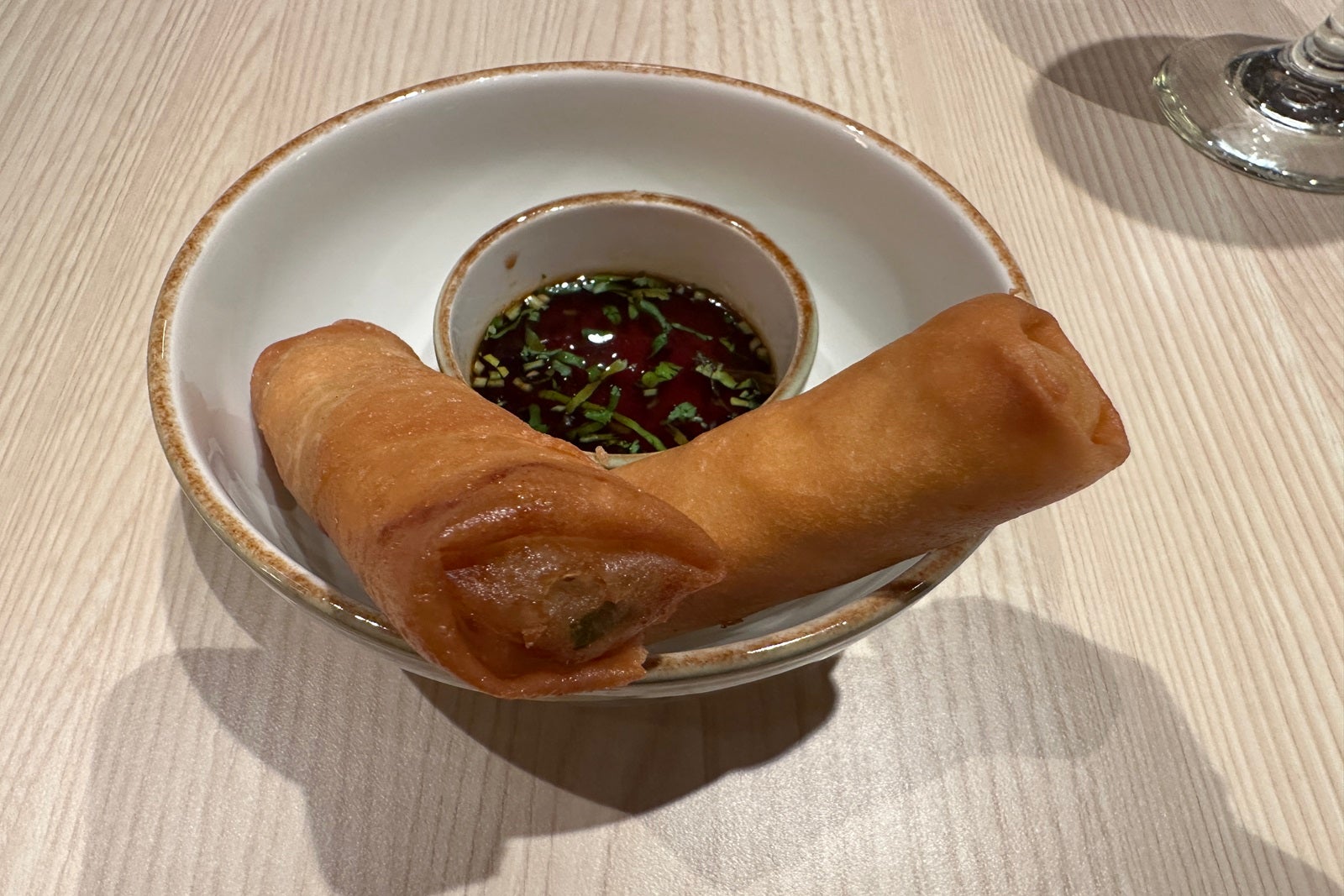
A little-known fact is that, at least for the inaugural season, passengers can dine at Mexican-Asian restaurant Chibang! and the Italian Cucina del Capitano, both on Deck 8, for free. Cruisers with YTD can eat there for dinner anytime; those with set seating can dine there after 7:45 p.m.
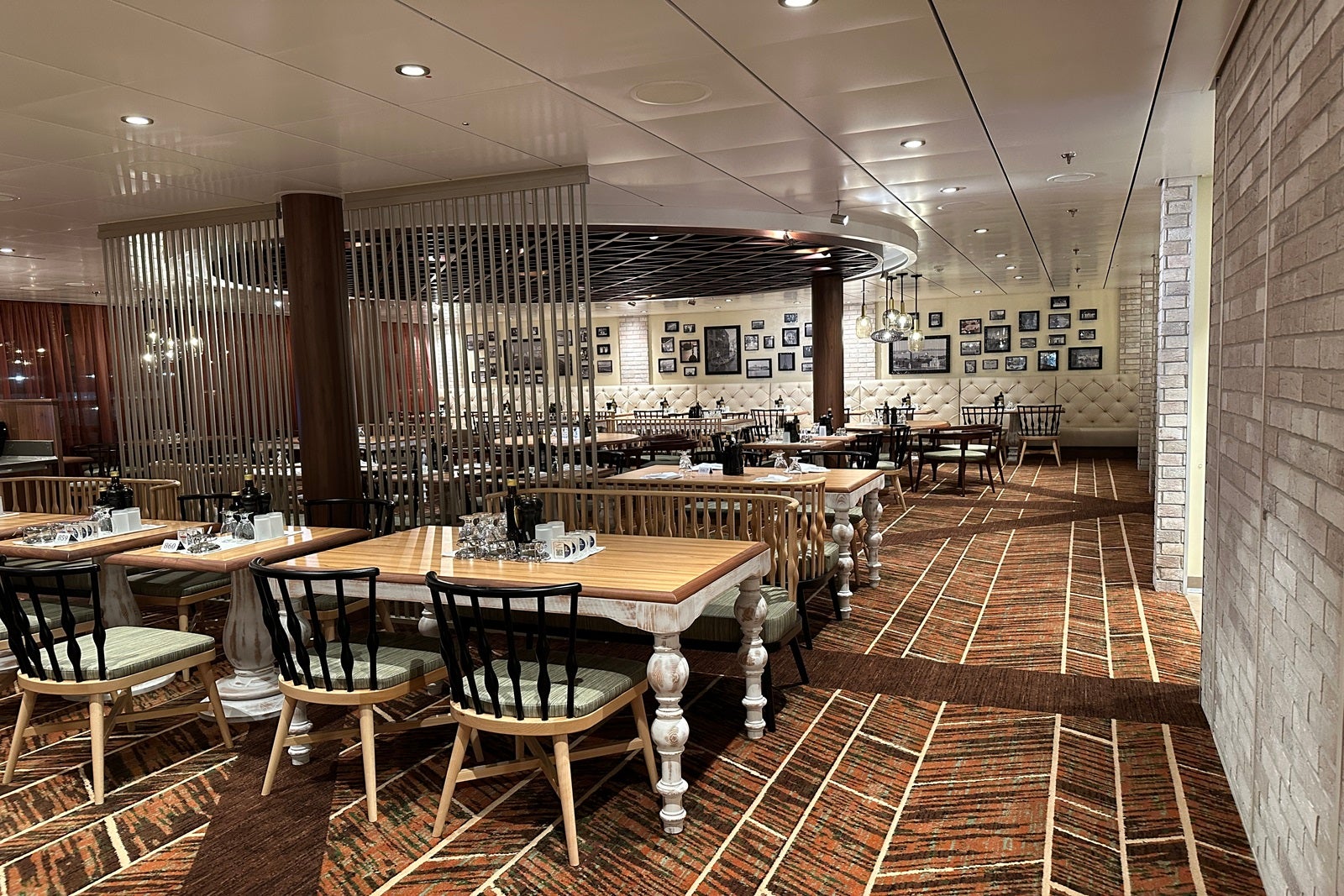
At Cucina del Capitano, I was exceptionally pleased with the spaghetti carbonara I ordered. The nachos and spring rolls are don't-miss items at Chibang!
Unfortunately, both the service and atmosphere at Chibang! are lacking. The space is simply packed with tables — so much so that there were only about two inches between my table and the one next to me, even though I was dining alone. It then took nearly 10 minutes for a waiter to bring me water and another 10 before someone came to take my order.
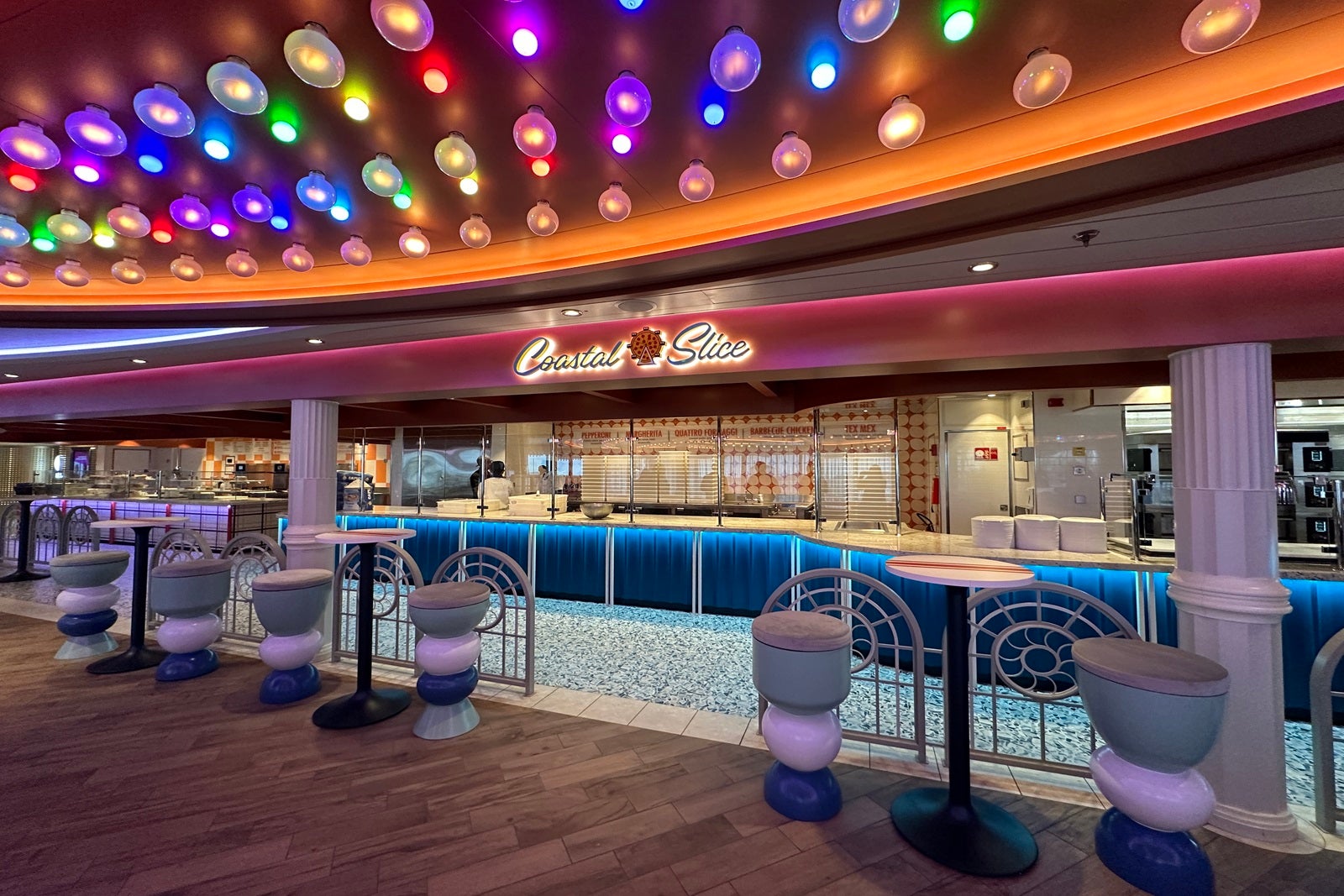
Also on Deck 8 are Coastal Slice and neighboring Beach Buns, which respectively replace the pizza and deli counters found by the pool on most other Carnival ships.
The former bakes several different types of pies nearly around the clock, and they're scrumptious. The latter whips up hotdogs, soups and a variety of sandwiches. (I was pleasantly surprised by the grilled ham and cheese.) Lines for both counters are often long, but I promise it's worth the wait.
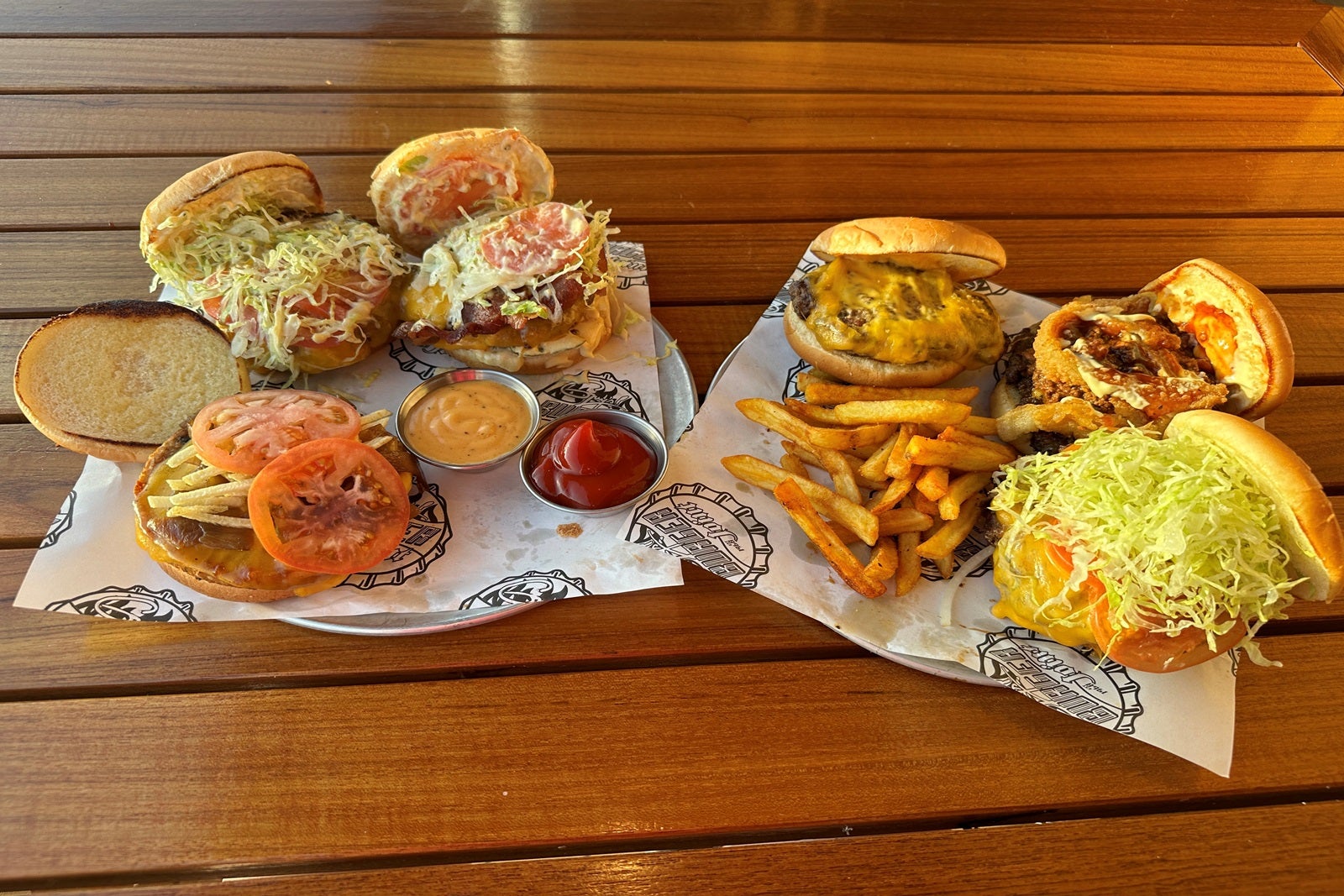
Two great staples in the ship's outdoor Lido zone are the BlueIguana Cantina (Deck 16), where you can find yummy tacos and burritos throughout the day, and Guy's Burger Joint (Deck 17), which is the place to grab some of the best burgers at sea via Carnival's partnership with chef and TV personality Guy Fieri.
The breakfast burritos at BlueIguana are fantastic. My pick from Guy's is the Chilius Maximus — an 80/20 ground chuck patty with cheese, chili, onion rings and barbecue sauce.
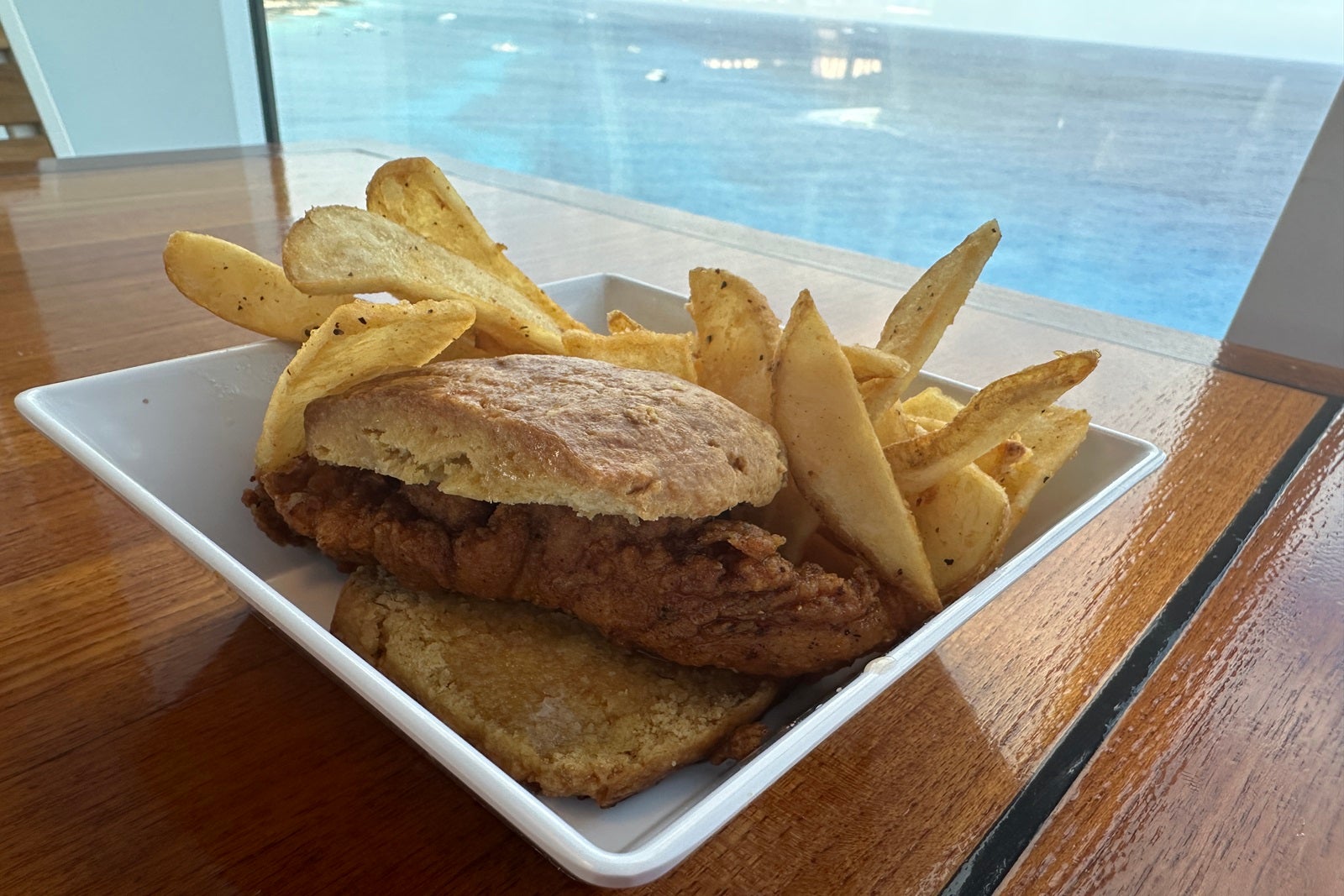
Guy Fieri isn't the only celebrity affiliated with Carnival's free food.
Shaq's Big Chicken , a restaurant backed by basketball great Shaquille O'Neal (who is also Carnival's CFO, chief fun officer), is perfect if you have a hankering for some fried chicken. In addition to chicken strips, sandwiches and fries, the counter-service venue also serves breakfast. Do yourself a favor and try the chicken and biscuit combo with fries.
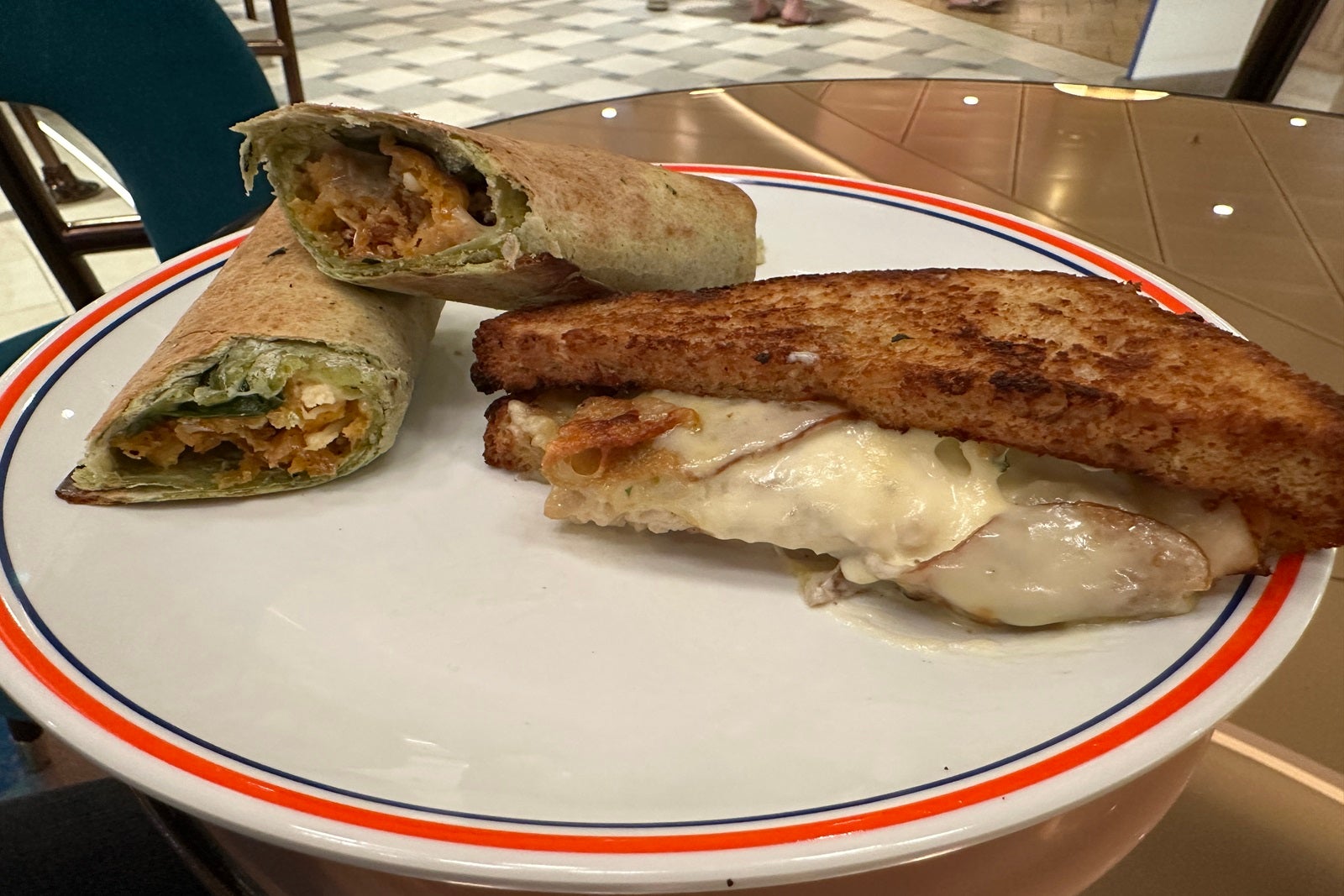
If you're seeking a between-meal snack or light bite, try the JavaBlue Cafe on Deck 6 in Grand Central. The cafe offers a sizable menu of specialty coffee beverages and tea, as well as free and for-fee snacks.
Breakfast pastries, bowls and English muffin sandwiches, as well as all-day options like salads, sandwiches, wraps, empanadas and calzones, are complimentary; cookies, doughnuts, cupcakes and cheesecake cost extra.
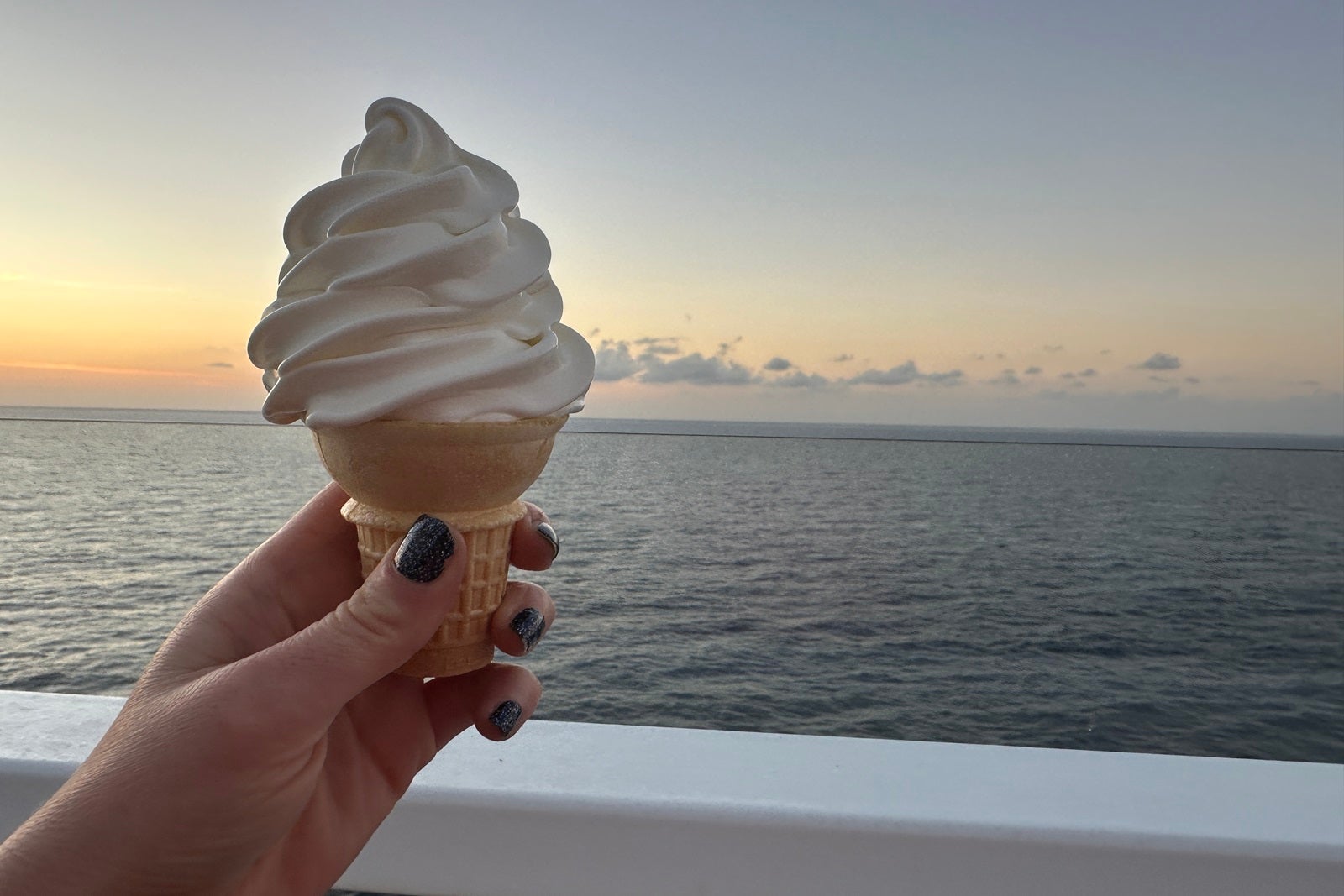
As a sucker for soft-serve ice cream, I was a frequent visitor to the three soft-serve ice cream and frozen yogurt machines on decks 8, 16 and 17. At some point, I lost count of how many cones I ate.
Since there are no toppings, I recommend you snag a bowl of dry Froot Loops from the buffet during breakfast, and stash them in your cabin to mix with your ice cream later. Or grab cookies from the buffet for a DIY ice cream sandwich.
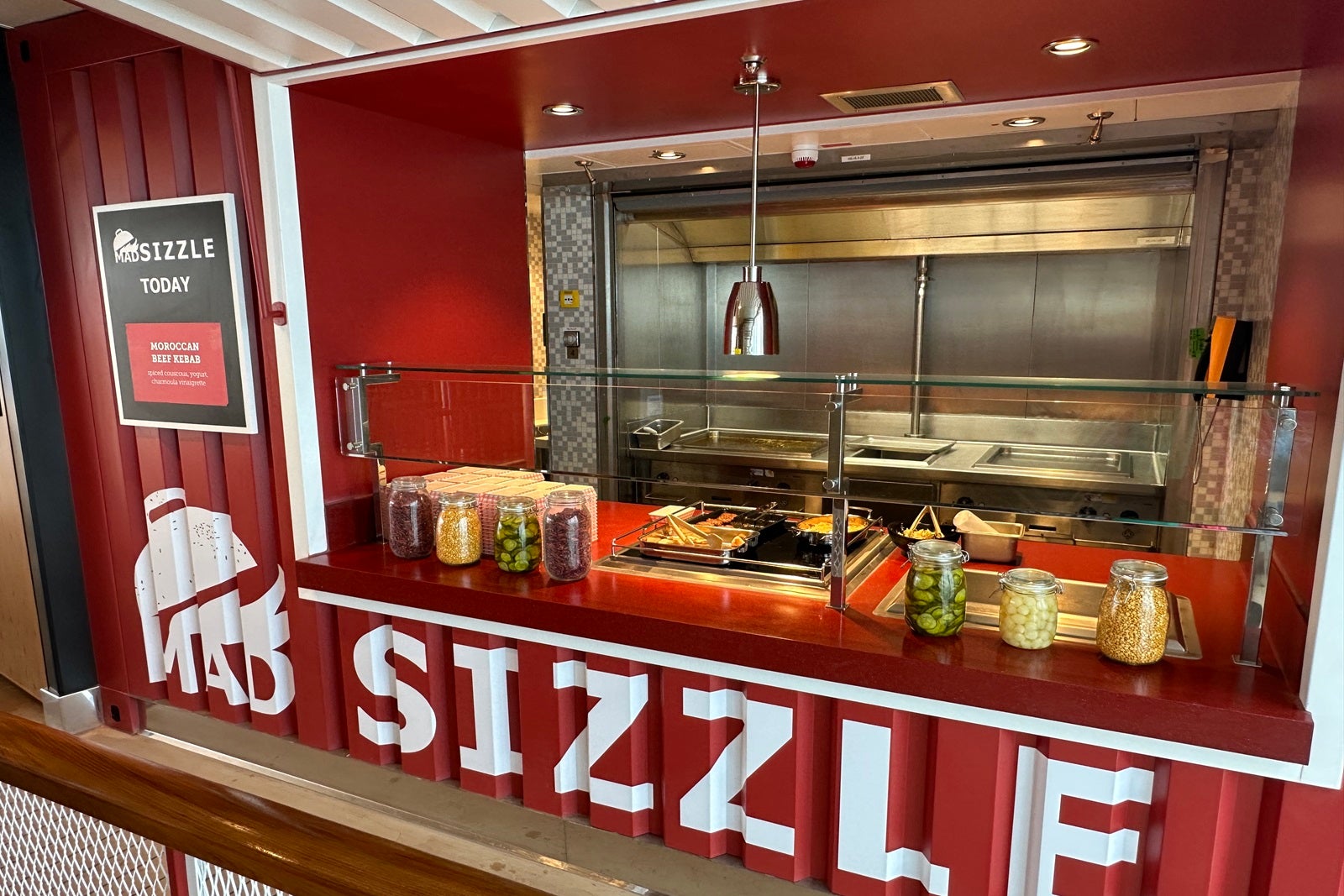
Carnival Jubilee has so many places to eat that I ran out of time to try them all on my weeklong sailing.
I missed Fresh Creations, a salad station in the adults-only sun deck area on Deck 18, and Street Eats, a set of three street food-style walk-up windows on Deck 16 near the main pool. The walk-up windows include Steam Dream, which serves dumplings; Time Fries, offering creative takes on french fries; and Sizzle, a grill that specializes in kebabs and other dishes.
Extra-cost food
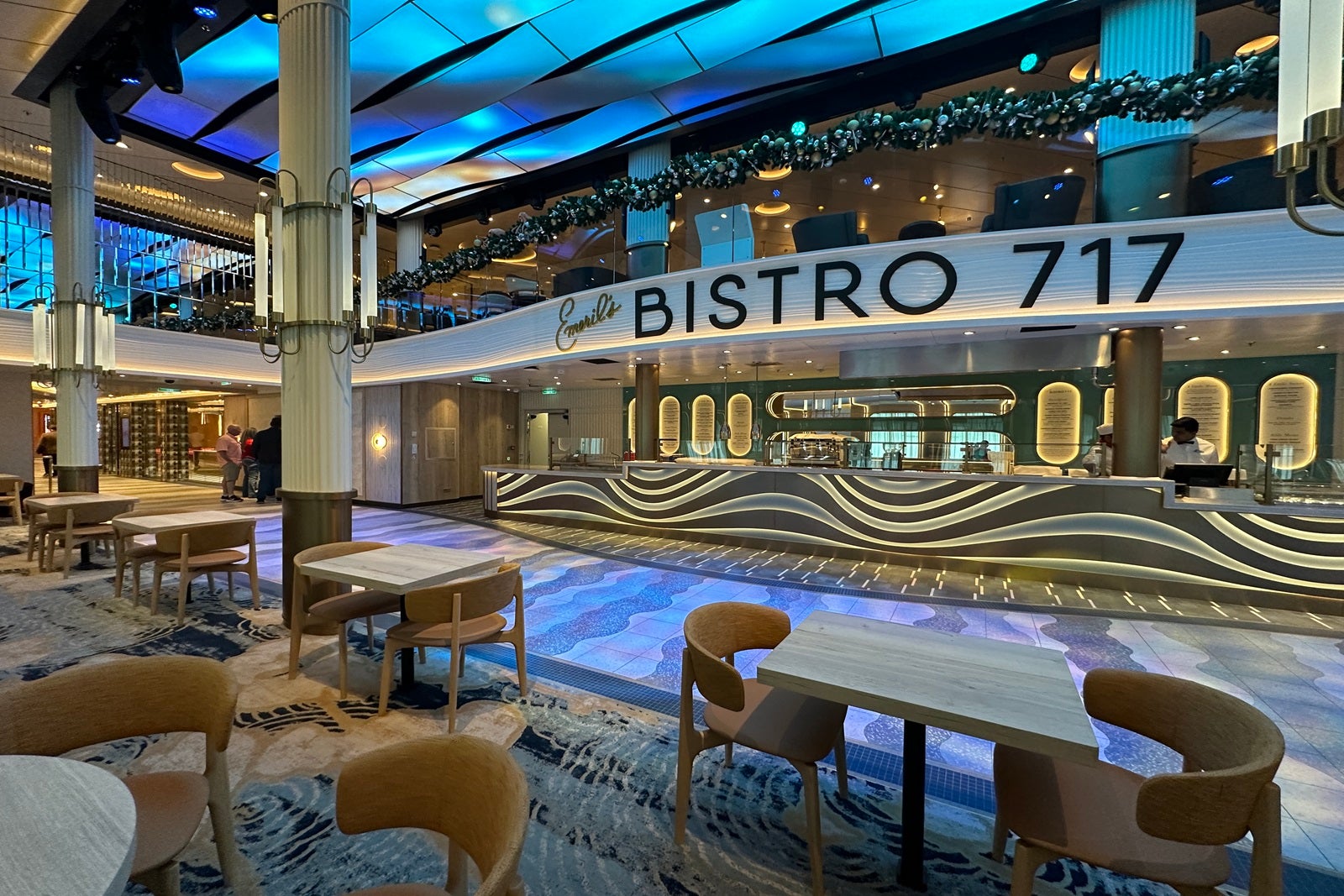
My favorite onboard dining experience of the whole sailing was at Emeril's Bistro 717 in the Currents zone on Deck 6. A version of this chef Emeril Lagasse-affiliated spot is on each of Carnival's Excel Class ships, bearing the hull number of the original vessel for which the new one is named. Simply walk up to order at the counter, have a seat and a waiter will take over from there.
During my visit, I ordered a pound of stone crab claws in garlic butter (market price) with red beans and rice ($3) and a brie bowl ($6). The food was fabulous, and the service was friendly. My only complaint is that, apart from a claw cracker, there were no other tools available to get to the crab meat. (I asked.) My waiter had no bibs or wet wipes to offer, which left me a bit messy afterward.
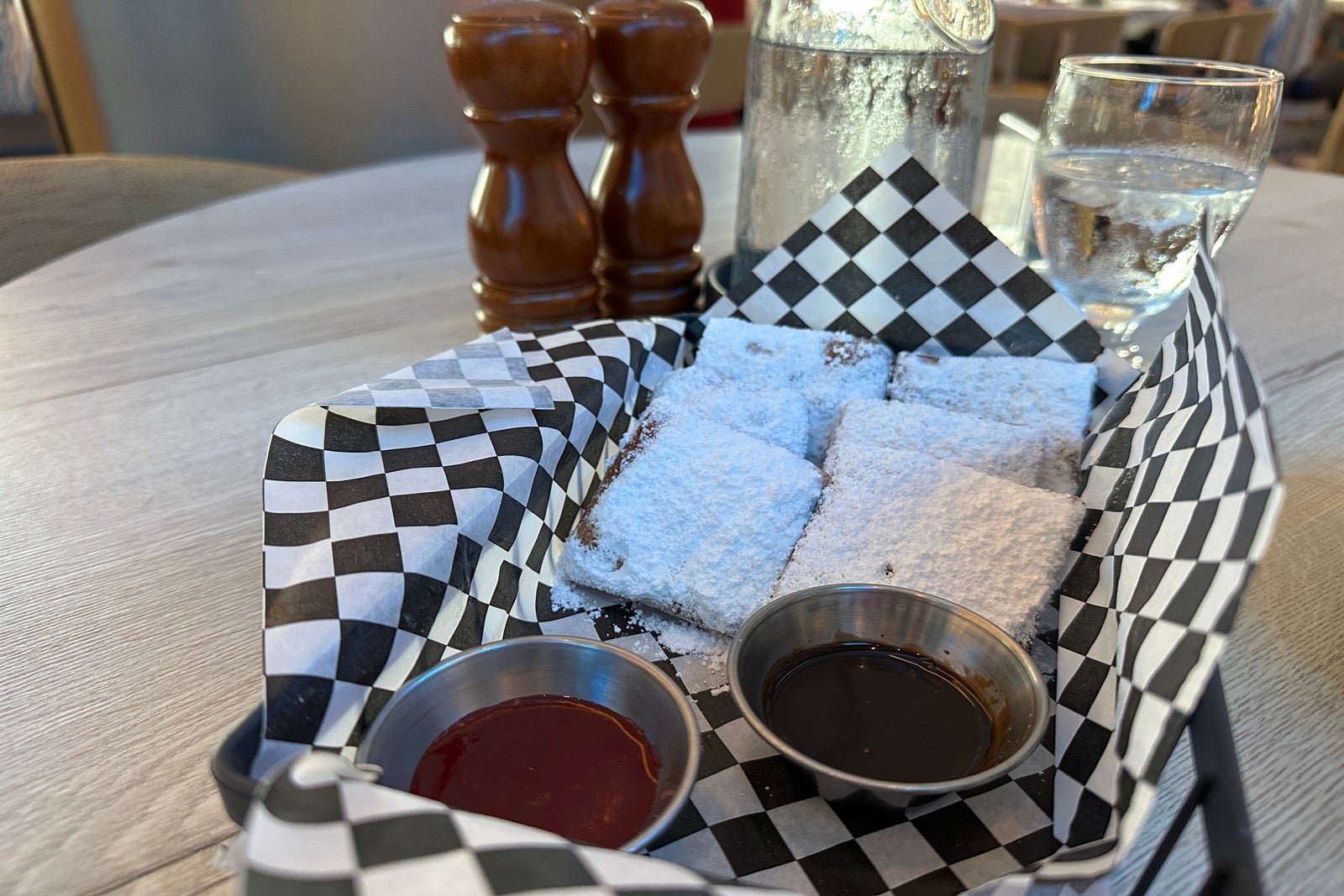
The food item I most recommend you try when sailing on Carnival Jubilee is an order of beignets at Emeril's. Pillows of soft fried dough coated in powdered sugar with chocolate and strawberry sauces for dipping are $5 for an order of six.
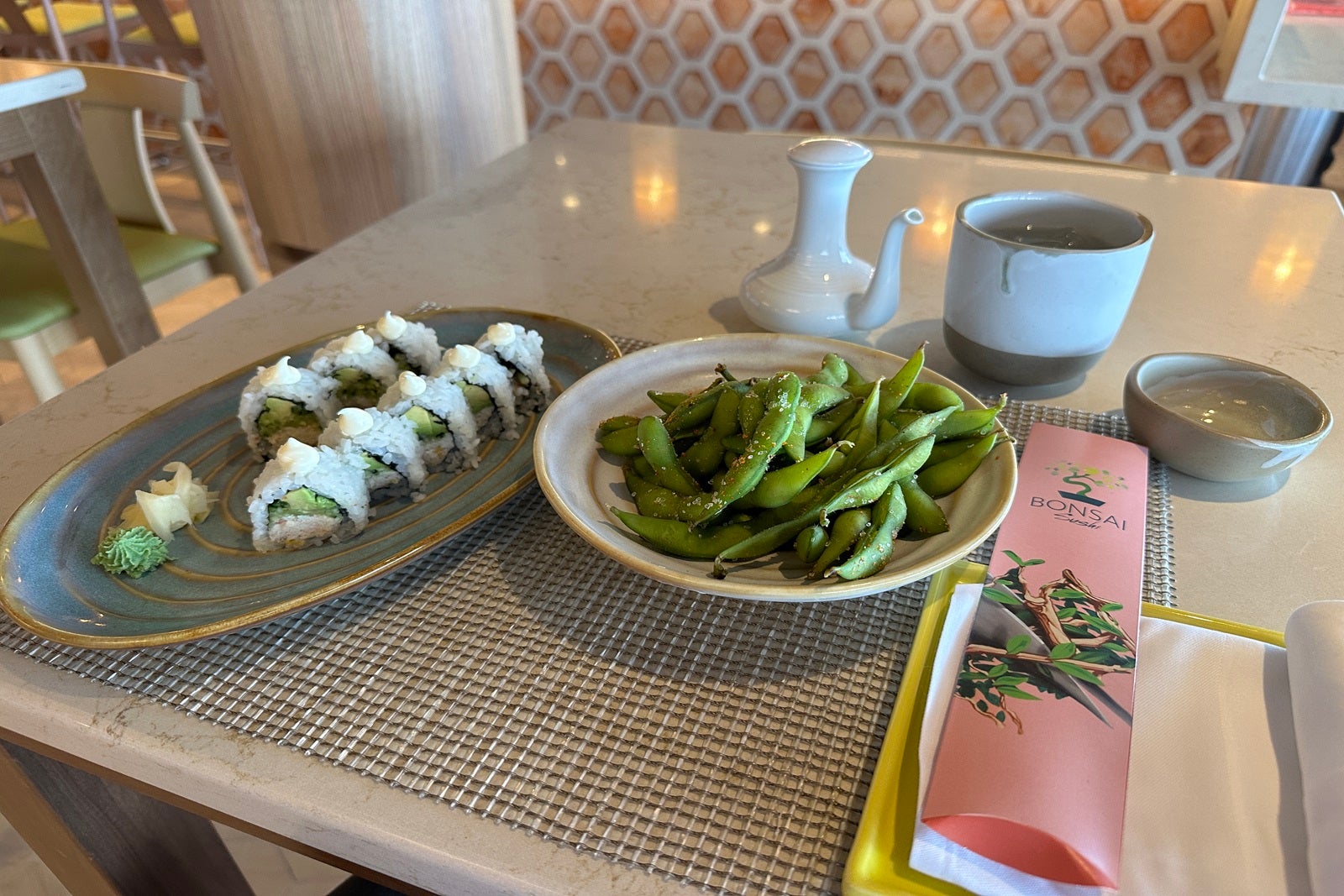
My second favorite experience was a calm, quiet and uncrowded lunch at Bonsai Sushi on Deck 8. I partook in edamame ($3) and a California roll ($8). It was fresh, tasty, filling and reasonably priced.
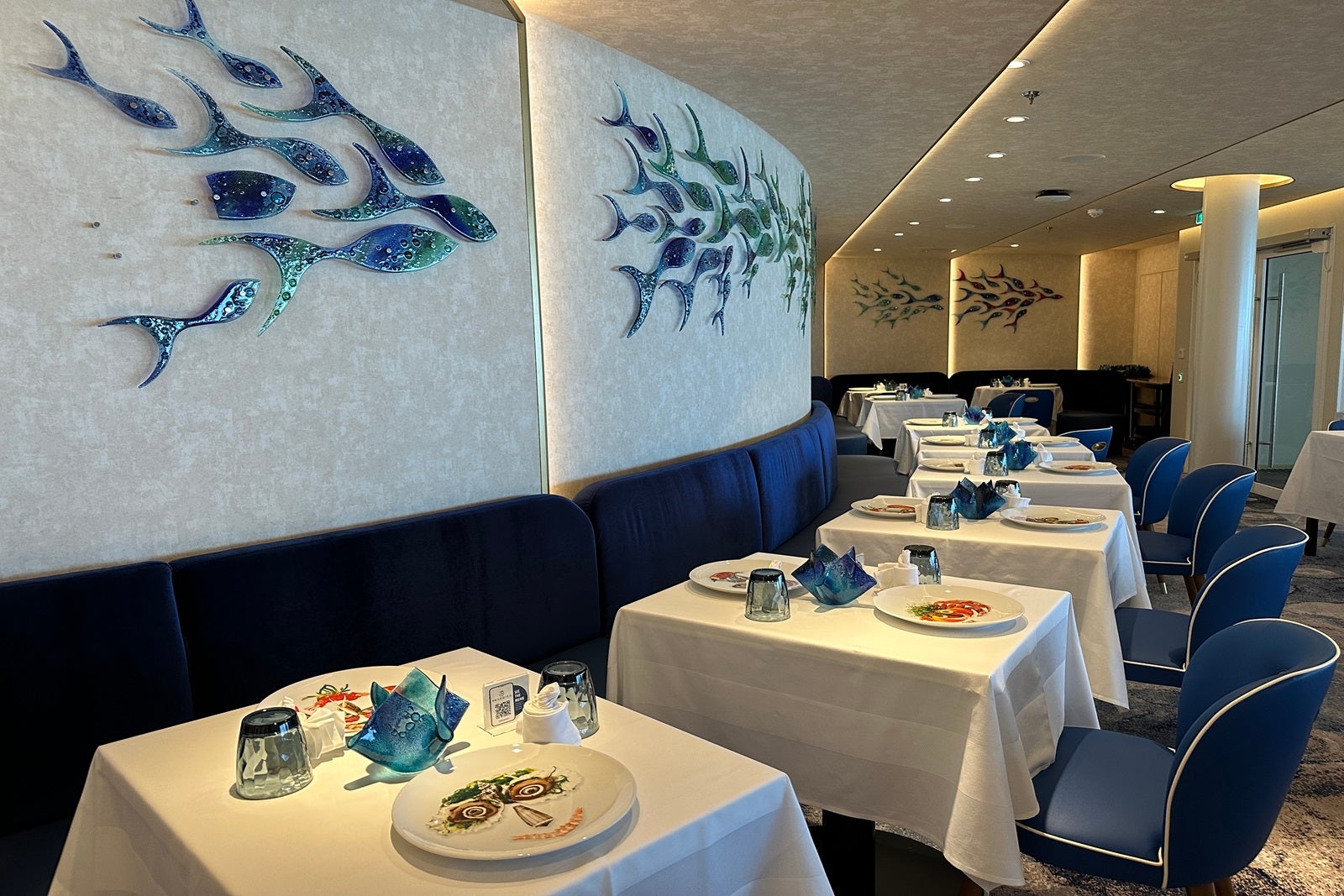
Another excellent dinner during my voyage occurred at Rudi's Seagrill (Deck 8), an upscale seafood restaurant named for chef and pop artist Rudi Sodamin. The lobster macaroni and cheese was the perfect indulgence to start my meal, and I followed it up with a delicious crab cake.
I wasn't overly hungry when I sat down, but the $49 cover charge ($15 for kids) would also have included a soup or salad and a dessert if I had wanted them.
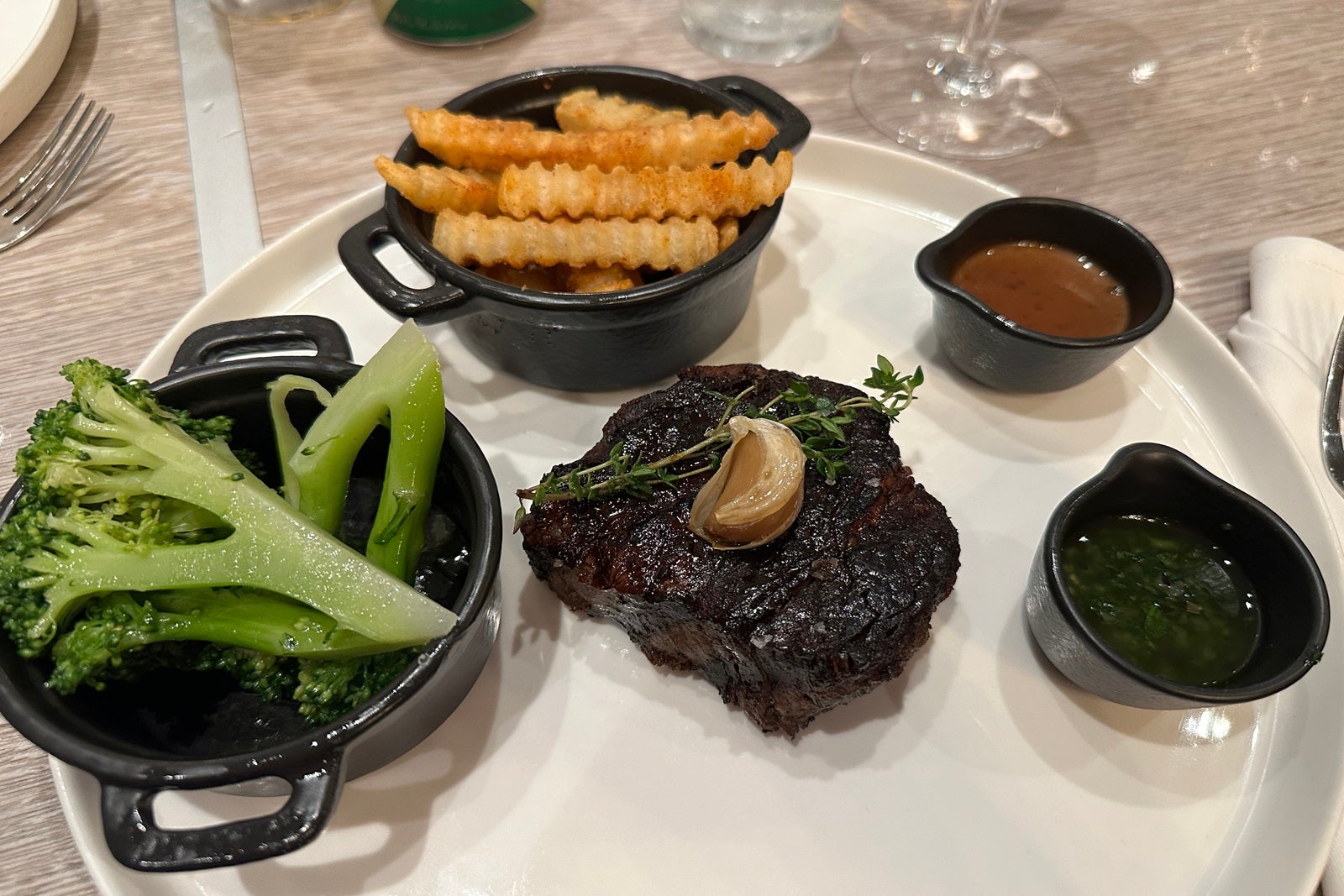
No Carnival sailing would be complete for a carnivore without a visit to Fahrenheit 555, the onboard steakhouse . On Carnival Jubilee, it's adorned in neutral tans, dark browns and red tones.
The menu has several types of meat — including steak, of course, as well as lamb chops and chicken — and seafood items like fish and lobster tail. I went with a 9-ounce filet mignon, which was cooked to perfection. It came alongside several sauces and sides of broccoli and crinkle-cut fries for $49 ($15 for kids).
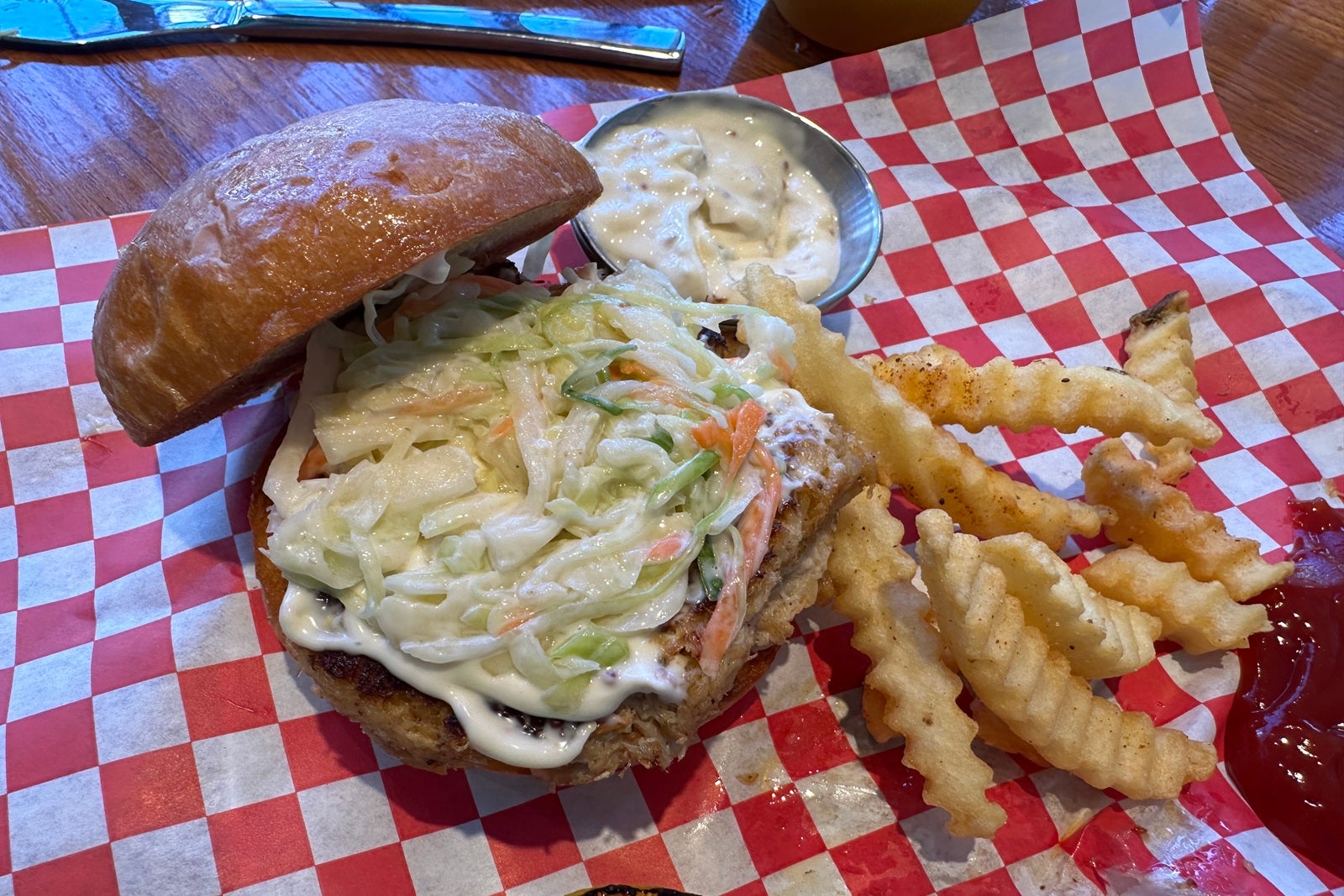
My two most disappointing extra-fee food encounters on Carnival Jubilee were Seafood Shack (Deck 16, in the Lido zone, near the pool) and room service.
The first one opened late, and despite my order being the first one of the day, it still took more than 20 minutes to be served. I chose a single crab cake for $15. When I received it, the bun was soggy, and no garnishes or sauces were offered until I went back to the counter to ask for coleslaw and tartar sauce, neither of which helped the flavor.
It didn't hold a candle to the crab cake from Rudi's, and I ended up abandoning most of it.
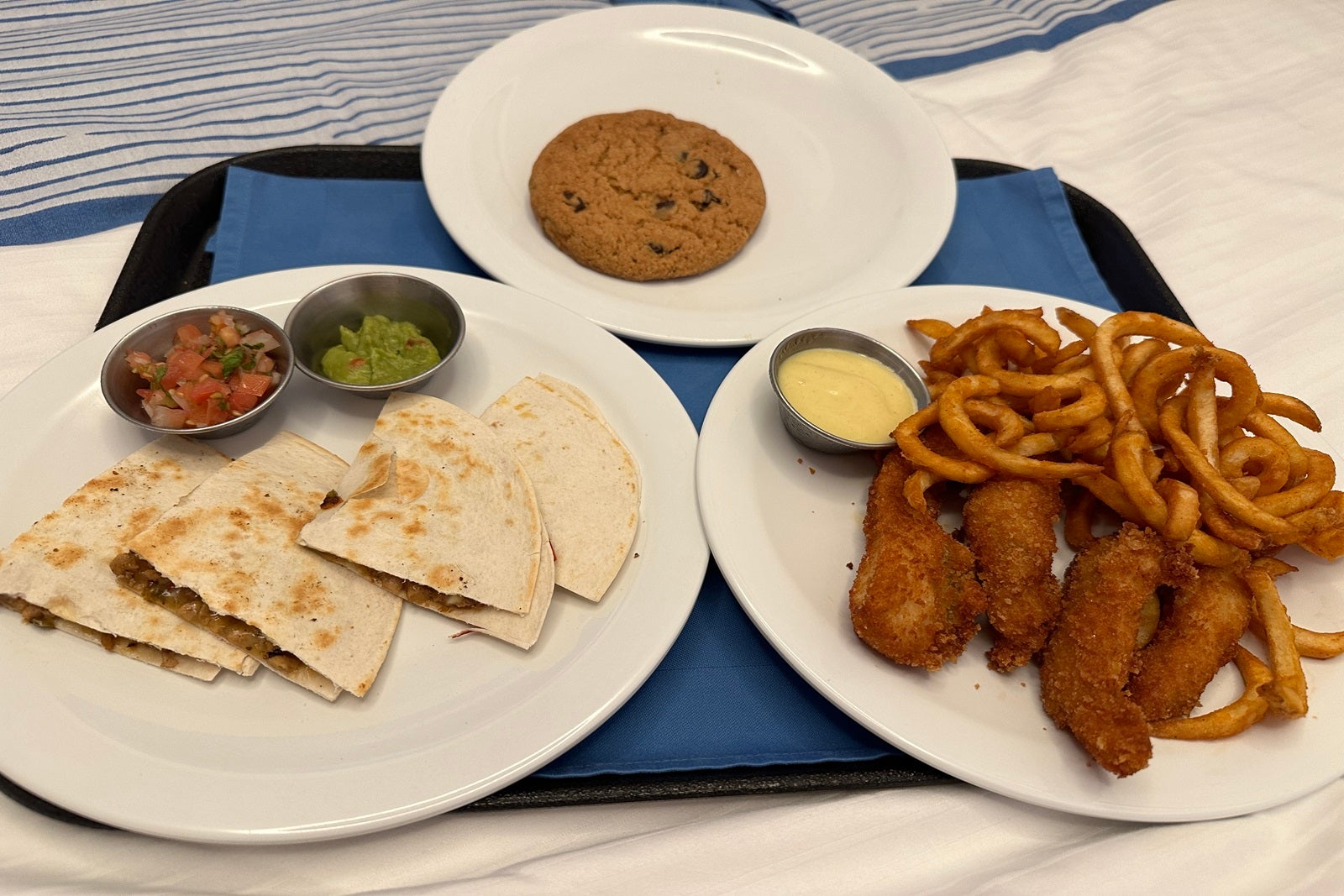
Room service, which comes with a la carte fees (except for free Continental breakfast), set me back almost $20 for a chicken quesadilla, chicken fingers with curly fries and a chocolate chip cookie, which I ordered sometime around 2 a.m.
Everything arrived quickly and at the right temperature. The fries and cookie were great, but the chicken fingers were rubbery and full of gristle. When I tried to order the quesadilla without chicken, I was told they were already made, which seems strange. Shouldn't room service be made to order?
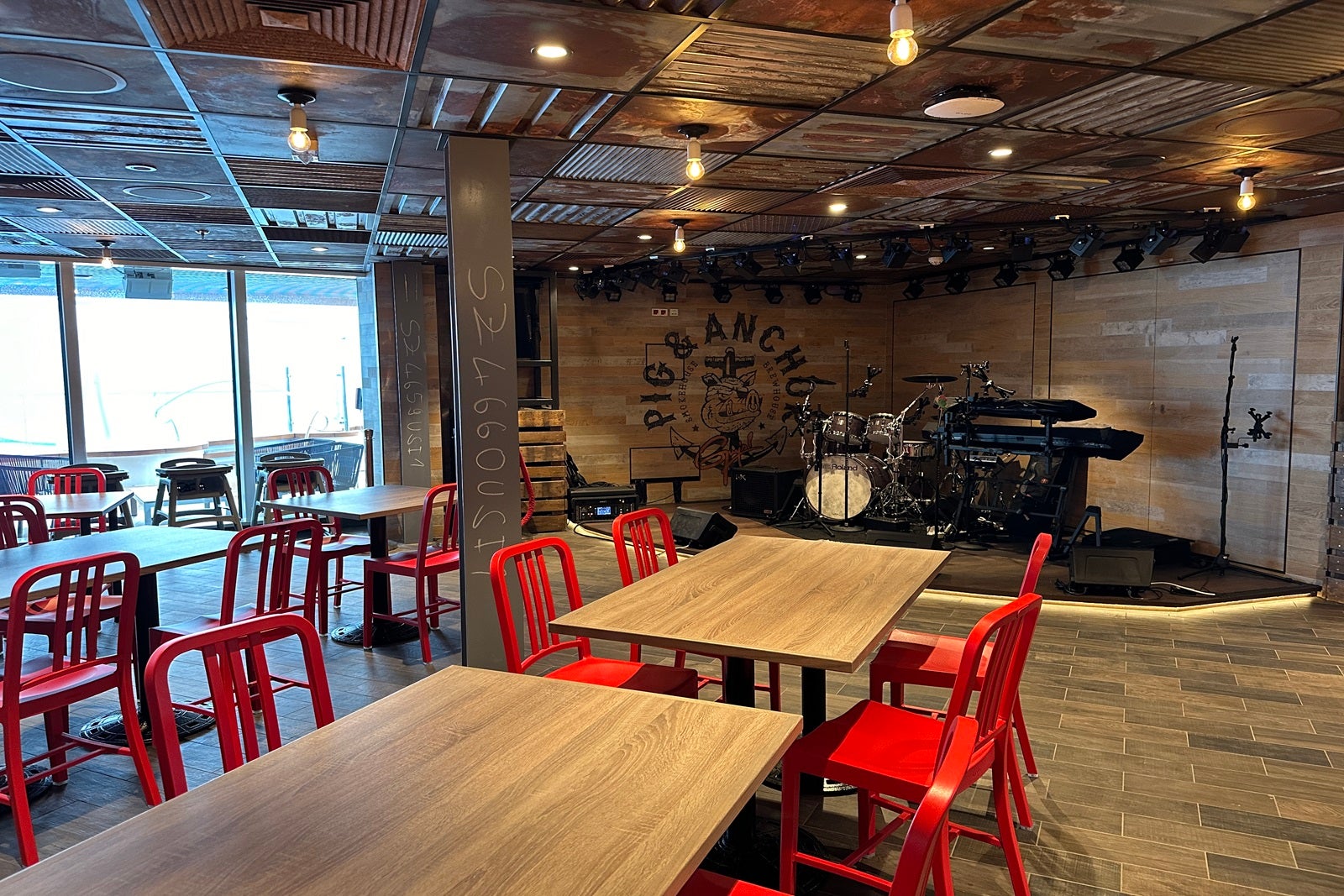
Again, I couldn't fit every single restaurant into my time on Carnival Jubilee, so I missed out on Bonsai Teppanyaki, where chefs grill your food right in front of you, complete with corny jokes. I also missed Guy's Pig & Anchor Smokehouse Brewhouse, another Guy Fieri creation that serves barbecue fare, wings and microbrewed beer made right on the ship (lunch is free). I couldn't make it to Chef's Table, an exclusive multicourse small-group dining experience that's the most pricey meal on board, either.
Carnival Jubilee bars
Drinks are priced individually unless you have a Cheers beverage package that includes alcohol.
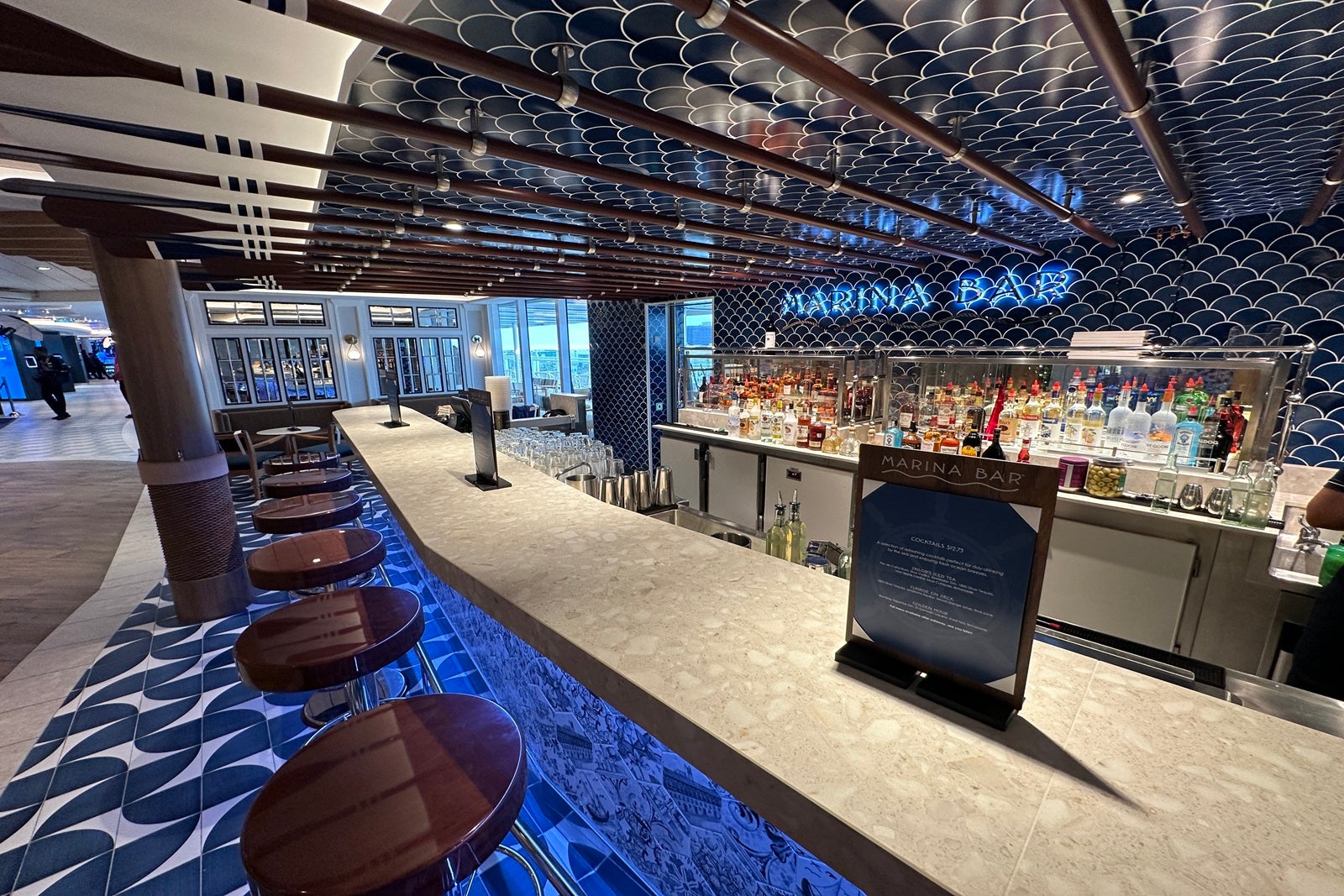
My favorite bar on Carnival Jubilee is the Marina Bar in The Shores zone on Deck 8. It offers a menu of adult beverages, but it also serves the same specialty coffees you'll find at JavaBlue, which often has a long line.
This nautically themed outpost is next to a popular access point to the outer decks, so the only downside is that you might be blasted with hot air while your drink is being made.
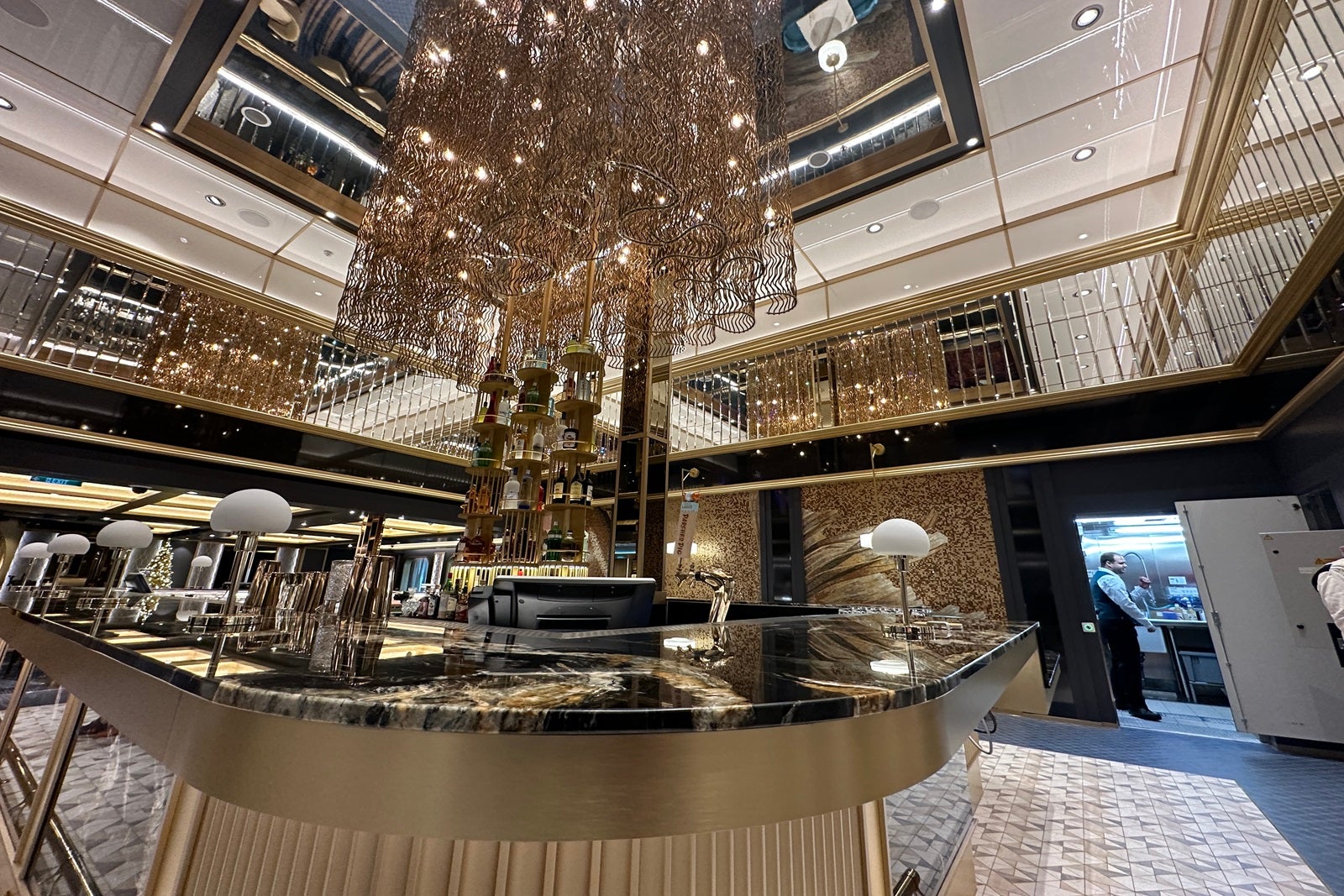
Unique to Carnival Jubilee are two new bars in the Deck 6 Currents zone.
The Golden Mermaid is a nod to treasures one might expect to find under the sea, and a mural on the opposite wall depicts underwater scenes, including mermaids. (For some "Where's Waldo"-style fun, try to spot a miniature likeness of the ship, a pair of custom sneakers and references to SpongeBob SquarePants.)
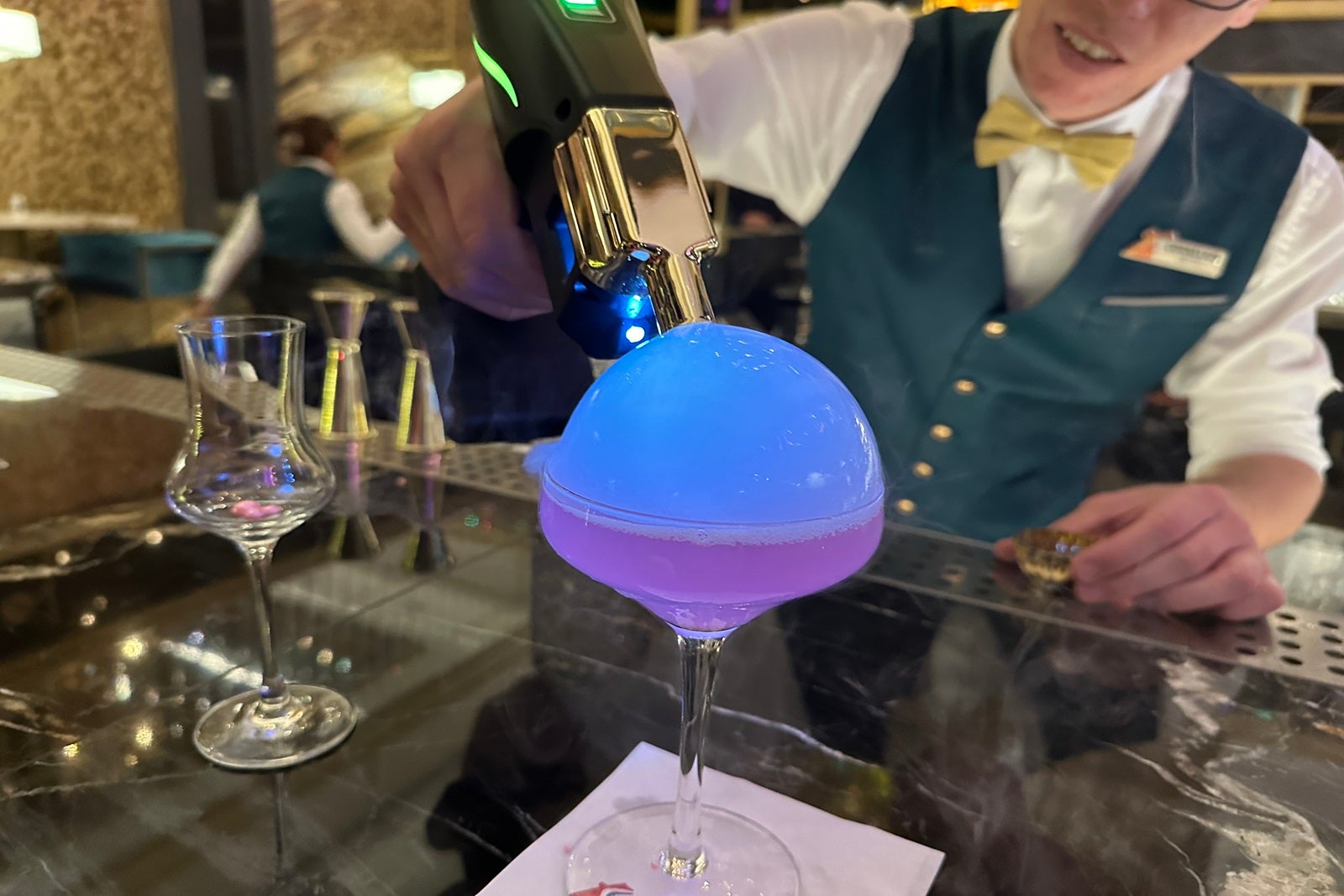
The menu of drinks is noteworthy, too, featuring names like From Far Seas and Atlantis Potion. My favorite, though, is A Pearly Bubble — a blend of gin, St. Germain liqueur, white cranberry juice, lime juice and dragon fruit that's as much for show as it is for taste.
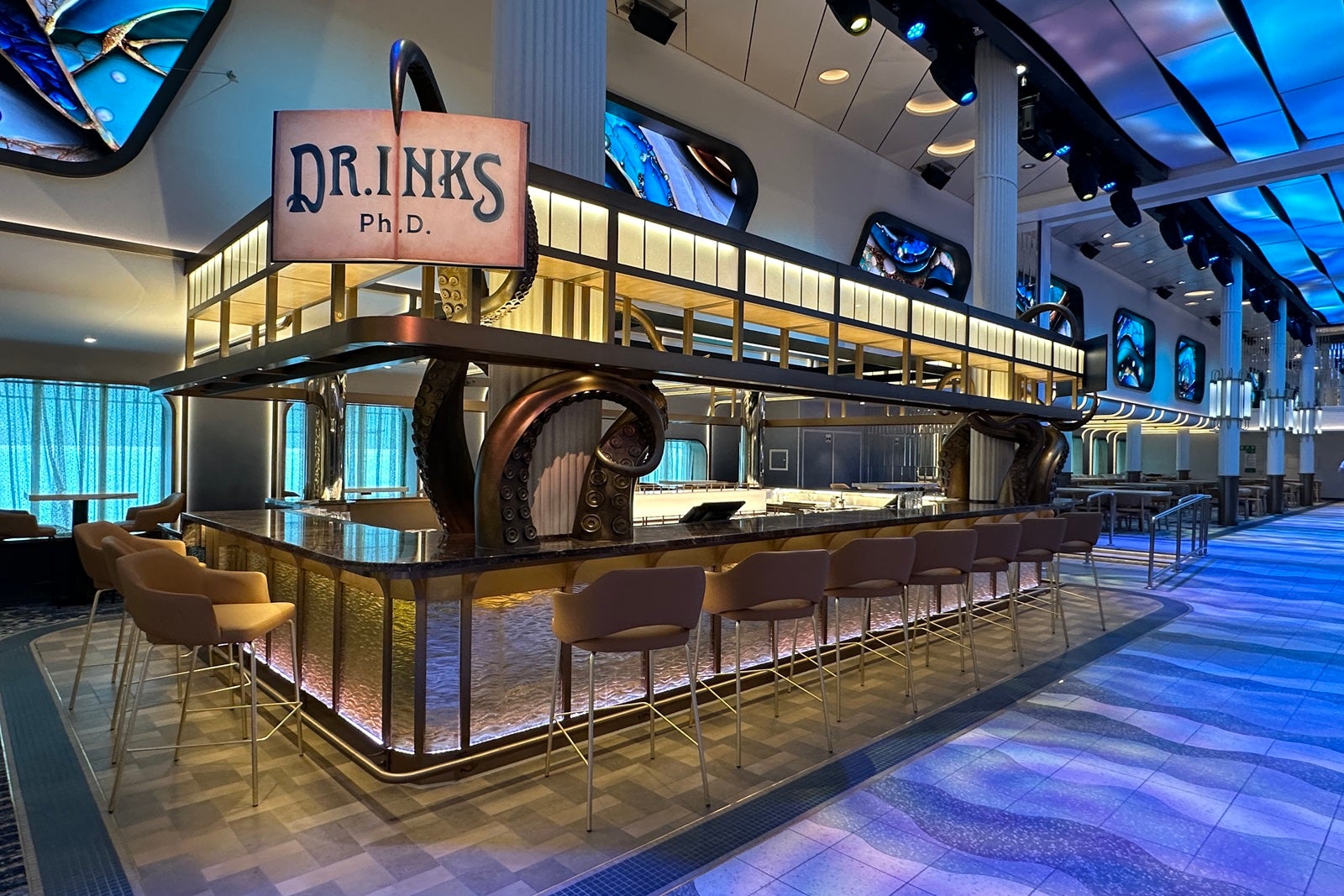
The second new bar is Dr. Inks, Ph.D. In addition to a fun selection of cocktails — some of which involve candy — the bar's theme is tied to an animated octopus named Dr. Inks. She has a Ph.D., pet butterflies and extensive collections of both books and fashionable eyewear. Every so often, she'll appear on the screens above the area to chat.
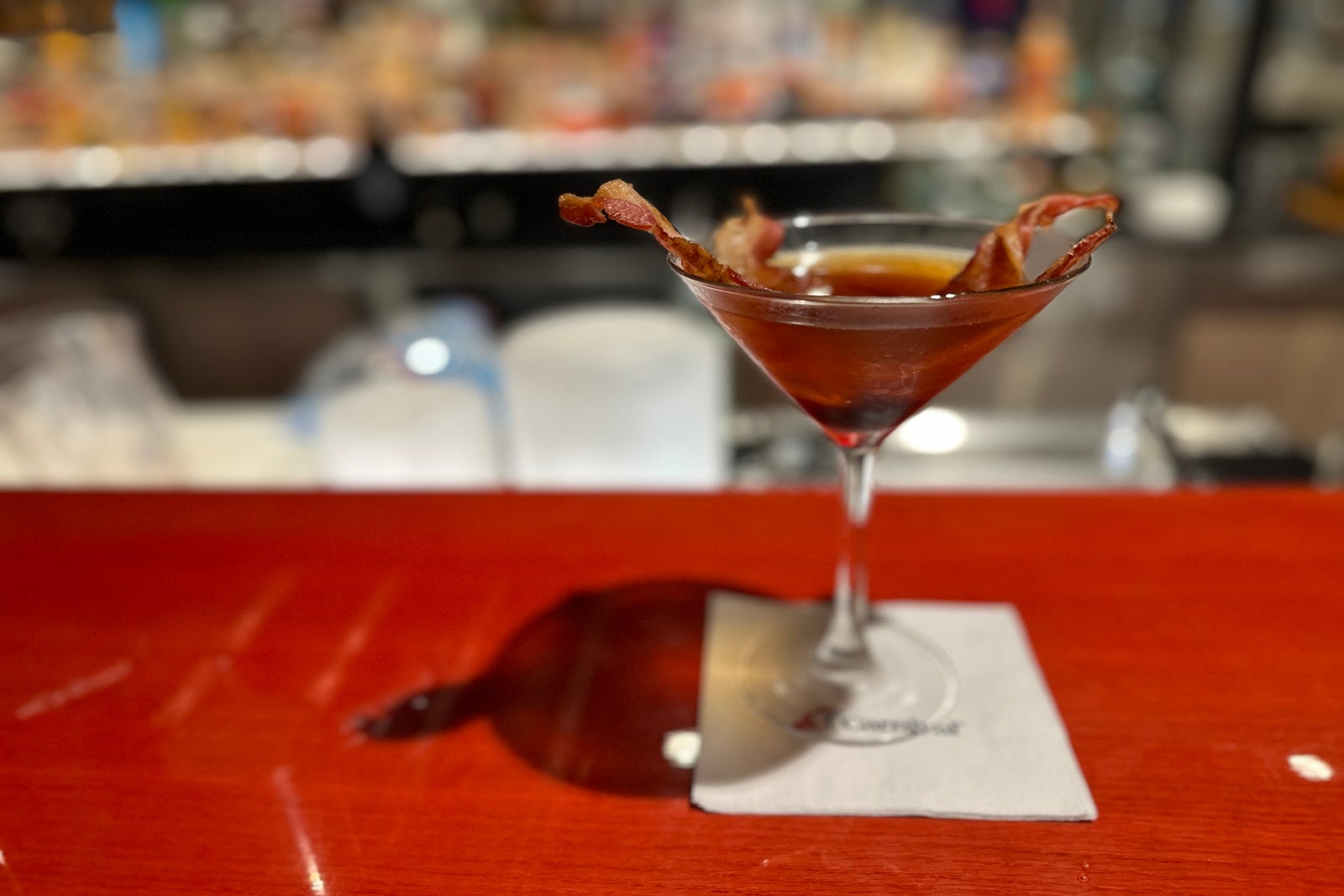
Cruiser-favorite Alchemy Bar — where white-coated apothecaries prescribe drinks to heal what ails you (try the Cucumber Sunrise) — and the bar at Guy's Pig & Anchor Smokehouse Brewhouse returned to Carnival Jubilee after finding success on other Carnival ships.
Besides beer that's brewed right on board — which you can order by the glass, flight or growler, or in cocktails — you can snag one of several whiskies or interesting cocktails like a smoky watermelon margarita and a black bourbon fizz. I tried a bacon Manhattan, but the taste wasn't my favorite. I also wasn't impressed with how long it took a bartender to ask for my order, especially since it wasn't particularly crowded.
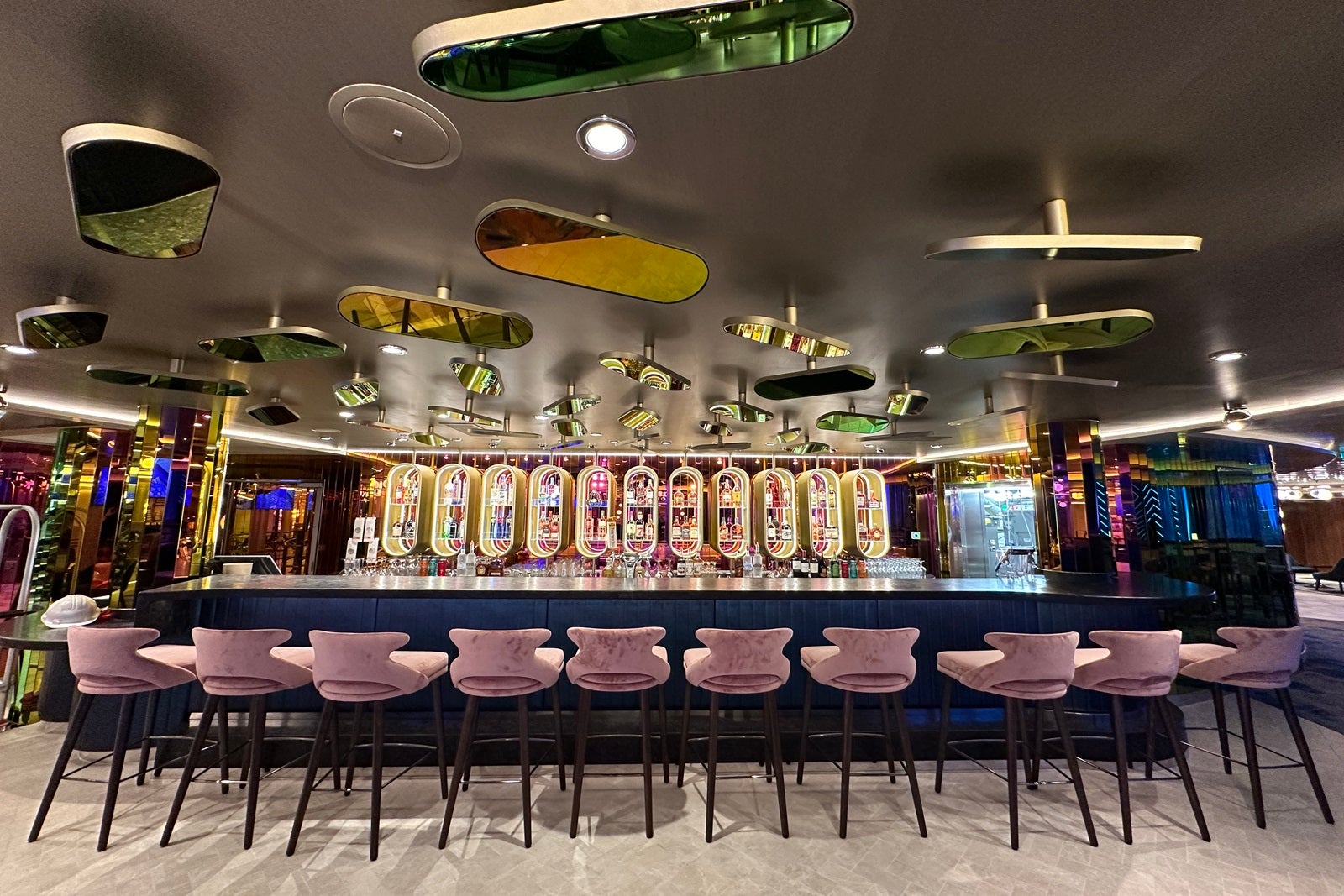
I'm not a huge drinker, so I didn't personally try cocktails from the Center Stage Bar (Deck 6) or Grand View Bar (Deck 7) in Grand Central. The former features a bit of a retro vibe, and the latter is backed by a giant light-up wall that looks like wave.
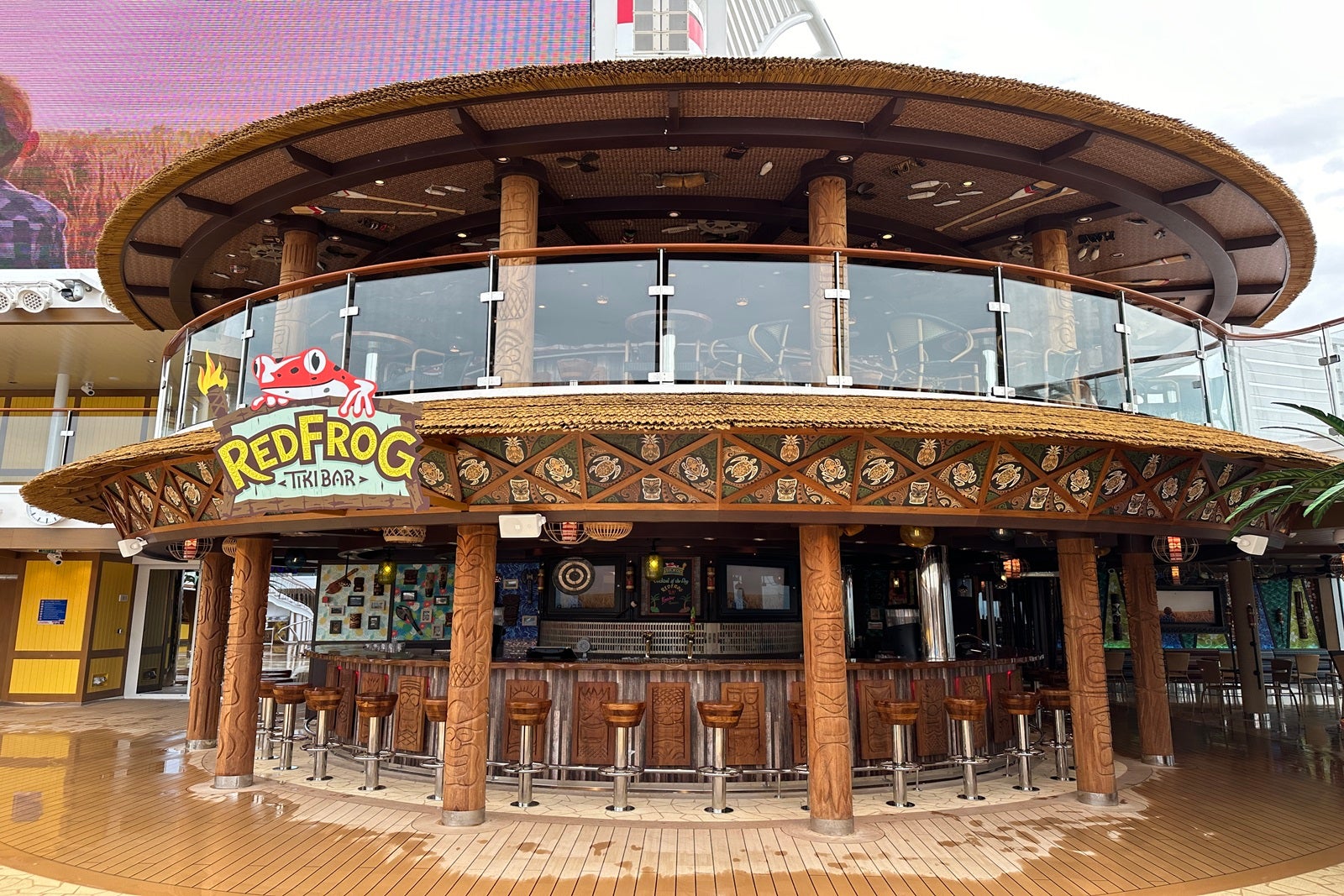
I also missed out on the RedFrog Tiki Bar, a two-deck (decks 16 and 17), hut-style setup that replaces the RedFrog Rum Bar found on many other Carnival ships' pool decks. It's where you'll find the most quintessentially tropical menu of mixed drinks on board.
Other outdoor bar options include The Watering Hole near Summer Landing on Deck 8, the Serenity Pool Bar on Deck 18 in the adults-only area and the Loft 19 Bar on the exclusive Loft 19 sun deck. (Access is free for passengers booked in suites or anyone who reserves a cabana for anywhere from $250 to $500 per day.)
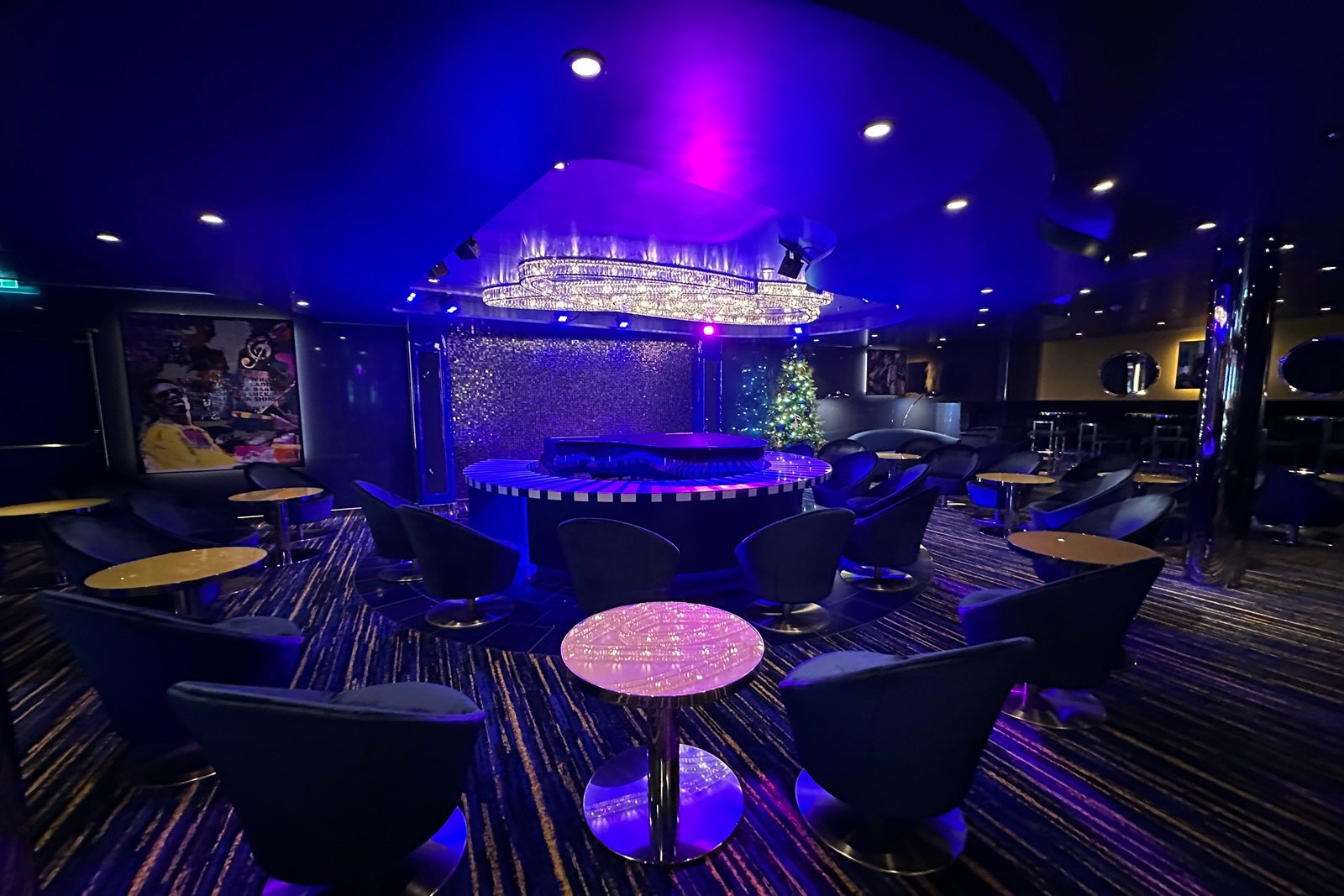
Back inside, Deck 6's Piano Bar is where passengers can order a tipple while an onboard pianist tickles the ivories. Make your way up a deck, and you'll find the Limelight Lounge, which serves as a secondary performance space and trivia outpost.
Go one deck farther, and you can choose between the Havana Bar, which serves Latin-themed cocktails, and the Heroes Tribute Lounge, which has a special menu of drinks dedicated to military members.
Carnival Jubilee entertainment
Carnival jubilee activities.
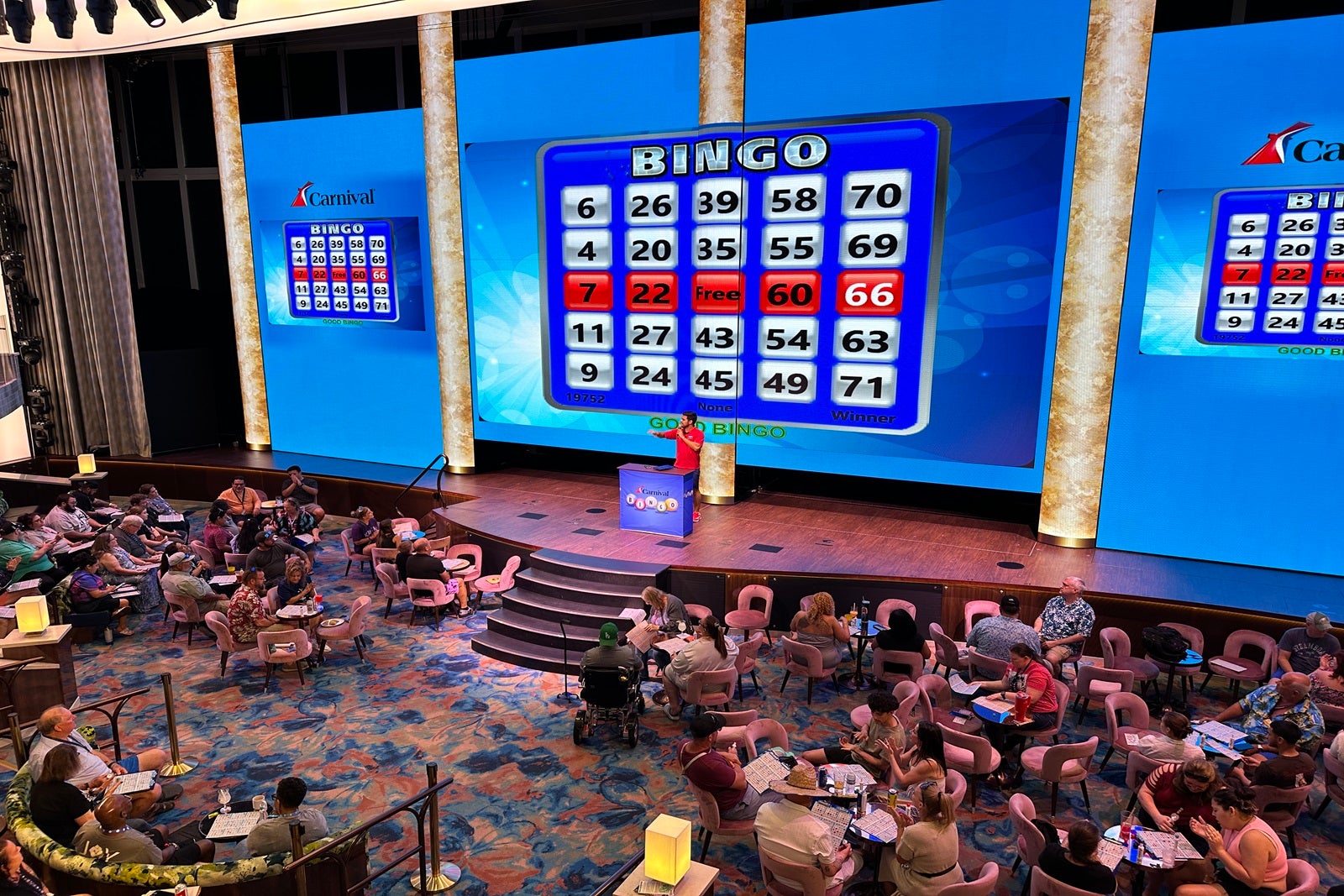
Carnival Jubilee offers a full roundup of daily activities on each voyage.
Passengers might choose to head to the casino, play bingo, enjoy an alcohol tasting, participate in a sports tournament, go on a digital scavenger hunt, mingle at a deck party, play minigolf, take a dance class, learn towel folding, or attend a spa, jewelry or shopping seminar.
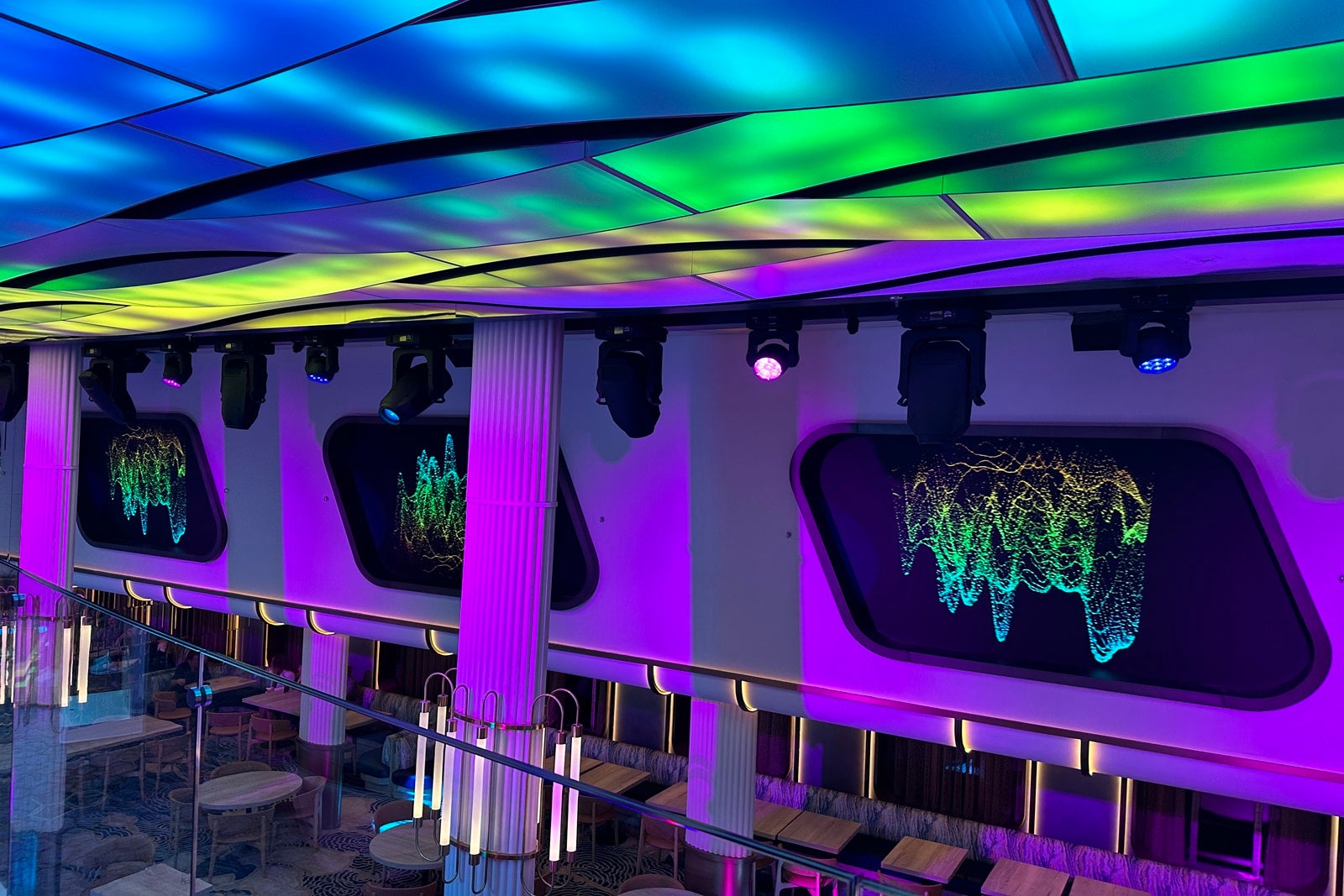
Particularly notable are the rotating animations that pop up throughout the Currents zone during each voyage.
If you show up during "Soundwaves Jukebox," you'll see synthesizer-like graphics pulsating to the music on the giant screens above the space.
"Change the Currents" will allow you to view underwater scenes from different areas of the world, including the Arctic and swampy Everglades; other experiences take you on an underwater adventure in a submarine and display ocean-themed artwork drawn by kids at St. Jude Children's Research Hospital.
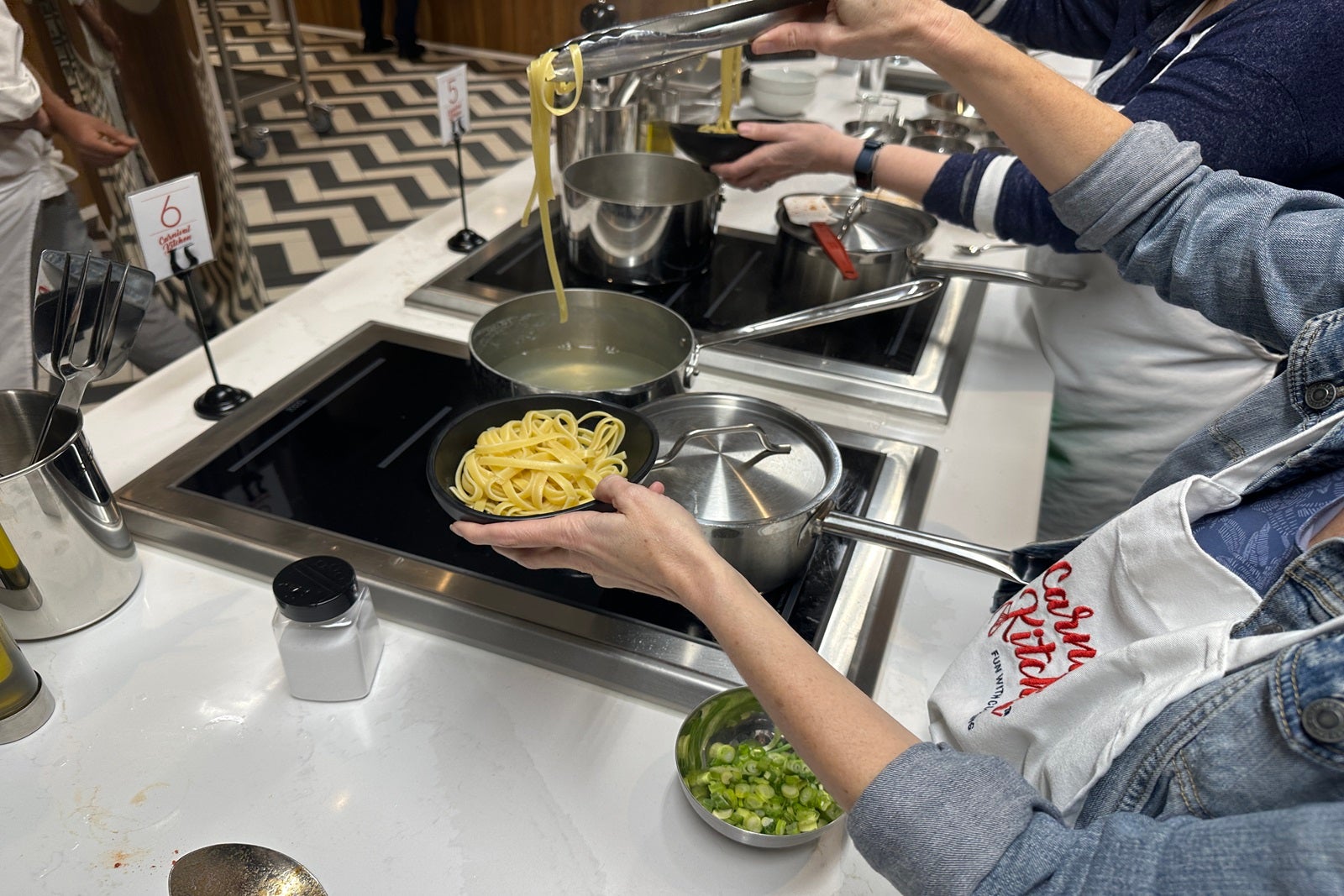
Some of my personal favorite pastimes on board included trivia, pool deck movies, for-fee culinary classes and a particularly relaxing massage. (Watch out for discounts early in your sailing or on port days.)
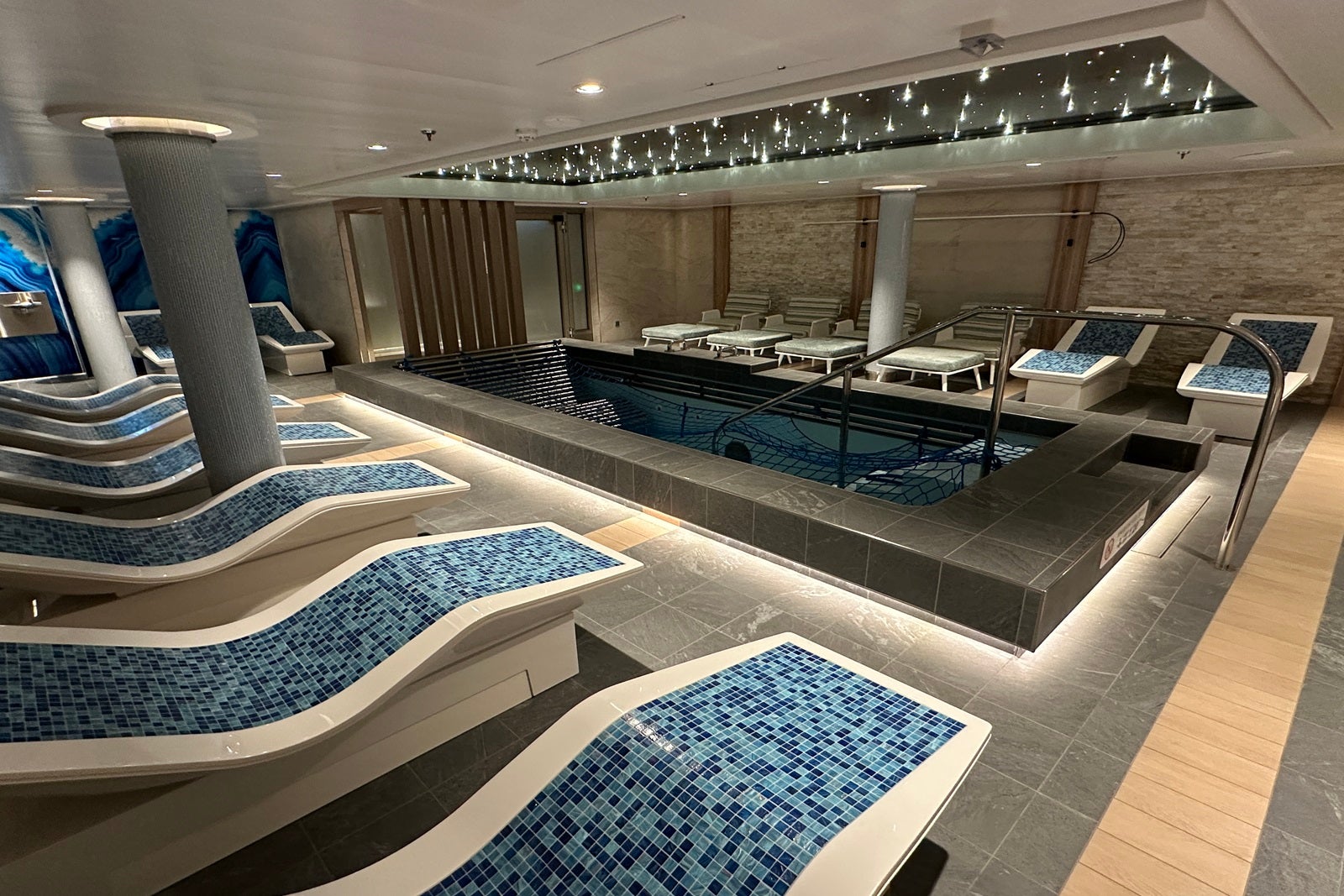
In addition to treatments, the Cloud 9 Spa offers salon services and a thermal suite — access to which is free with the purchase of a pass or a spa treatment — with a thalassotherapy pool, heated tile loungers, a sauna and two steam rooms. The adjacent fitness center is on the small side but features for-fee personal training and organized fitness classes, as well as equipment that's free for passengers to use.
Looking to find a group of like-minded travelers on your sailing? Check out meetups for solo travelers, singles, veterans and members of the LGBTQ+ community listed in the daily program.
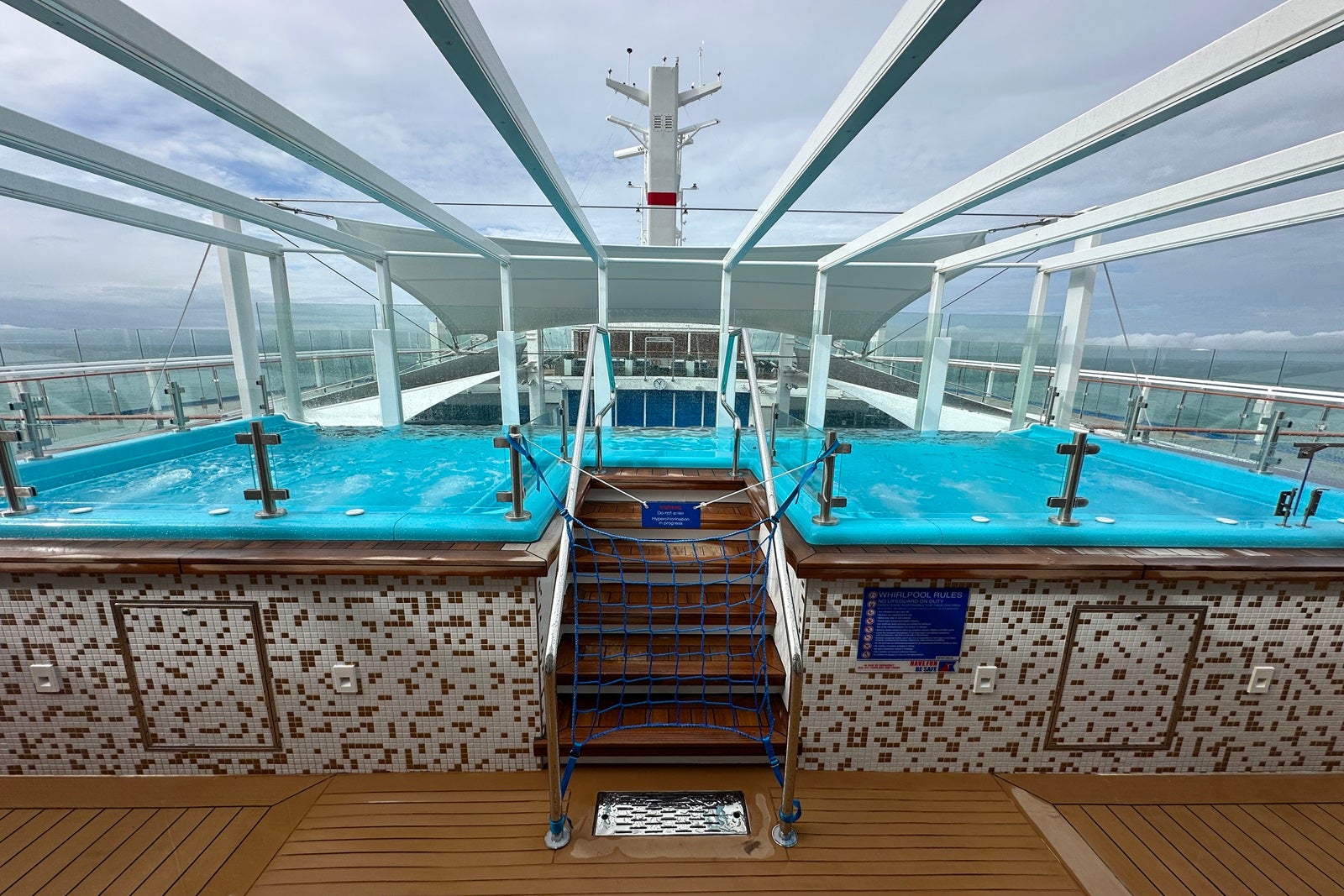
If you're interested in spending time outdoors working on your tan by the pool, you can do so at one of five onboard pools.
There's the Havana Pool (private access for cruisers staying in Havana Cabanas) and the Patio Pool, both on Deck 8 (the latter with hot tubs); the Beach Pool and Tides Pool on Deck 16 (also with hot tubs); and the Deck 18 adults-only Serenity Pool (with hot tubs). There's also a hot tub at Loft 19 on Deck 19, which charges a fee for access.
Cabanas are available for rent on a first-come, first-served basis. Prices vary by sailing, but on my voyage, they were $500 per day from 8 a.m. to 8 p.m. Pool lifts accommodating up to 300 pounds are available for passengers with limited mobility.
On Deck 18, you'll find Waterworks, which offers waterslides and a splash area for kids.
Kids and adults who aren't afraid of heights will enjoy the top-deck ropes course, which offers two options for different levels of skill and bravery. The Bolt roller coaster, a minigolf course and a basketball court are also found in the SportSquare area within the Ultimate Playground zone.
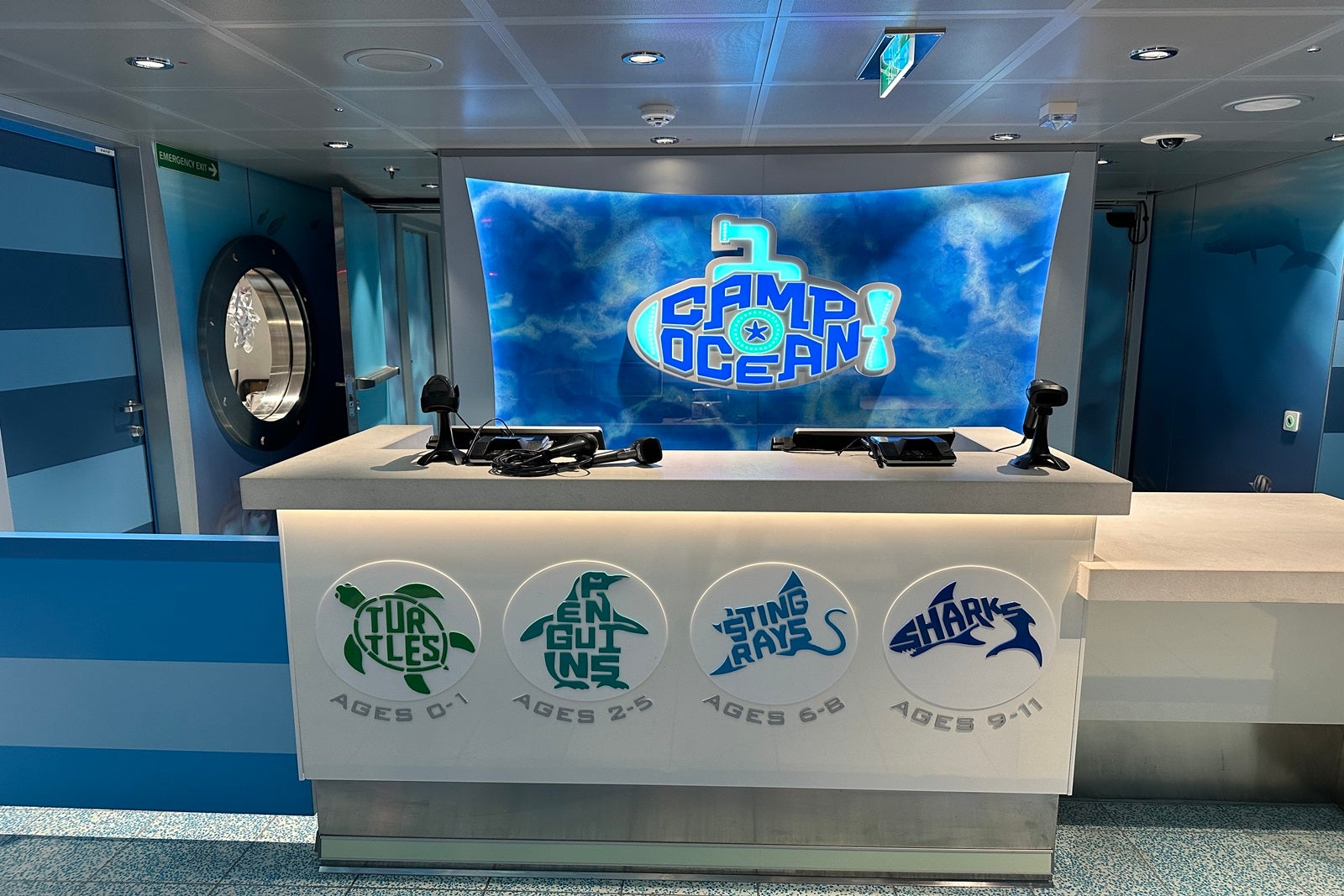
Additional activities for youngsters take place in Camp Ocean, Carnival's kids club , which splits children into four groups: Turtles (up to 2 years old), Penguins (2-5), Stingrays (6-8) and Sharks (9-11).
Fun pursuits on the daily schedule might include arts and crafts, themed parties, science experiments, games and story time, depending on the age group.
Camp Ocean also has an interactive space wall, where astronauts lead kids on virtual expeditions, complete with a ceiling that lights up like the night sky to show the constellations.
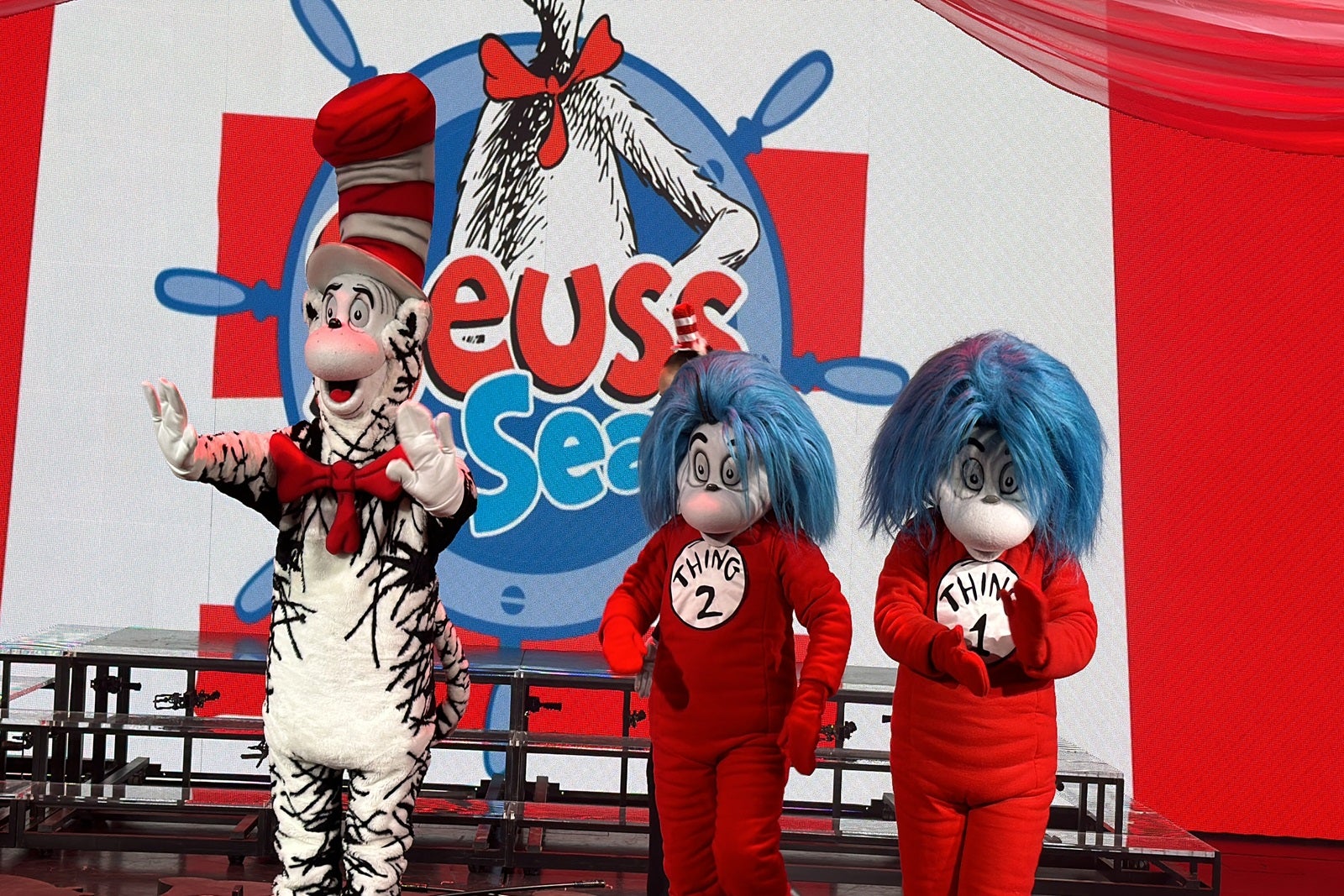
Kids can also attend Build-A-Bear workshops, march along in a Dr. Seuss-themed parade led by the Fox in Socks and Thing 1 and Thing 2, and listen to the Cat in the Hat read stories.
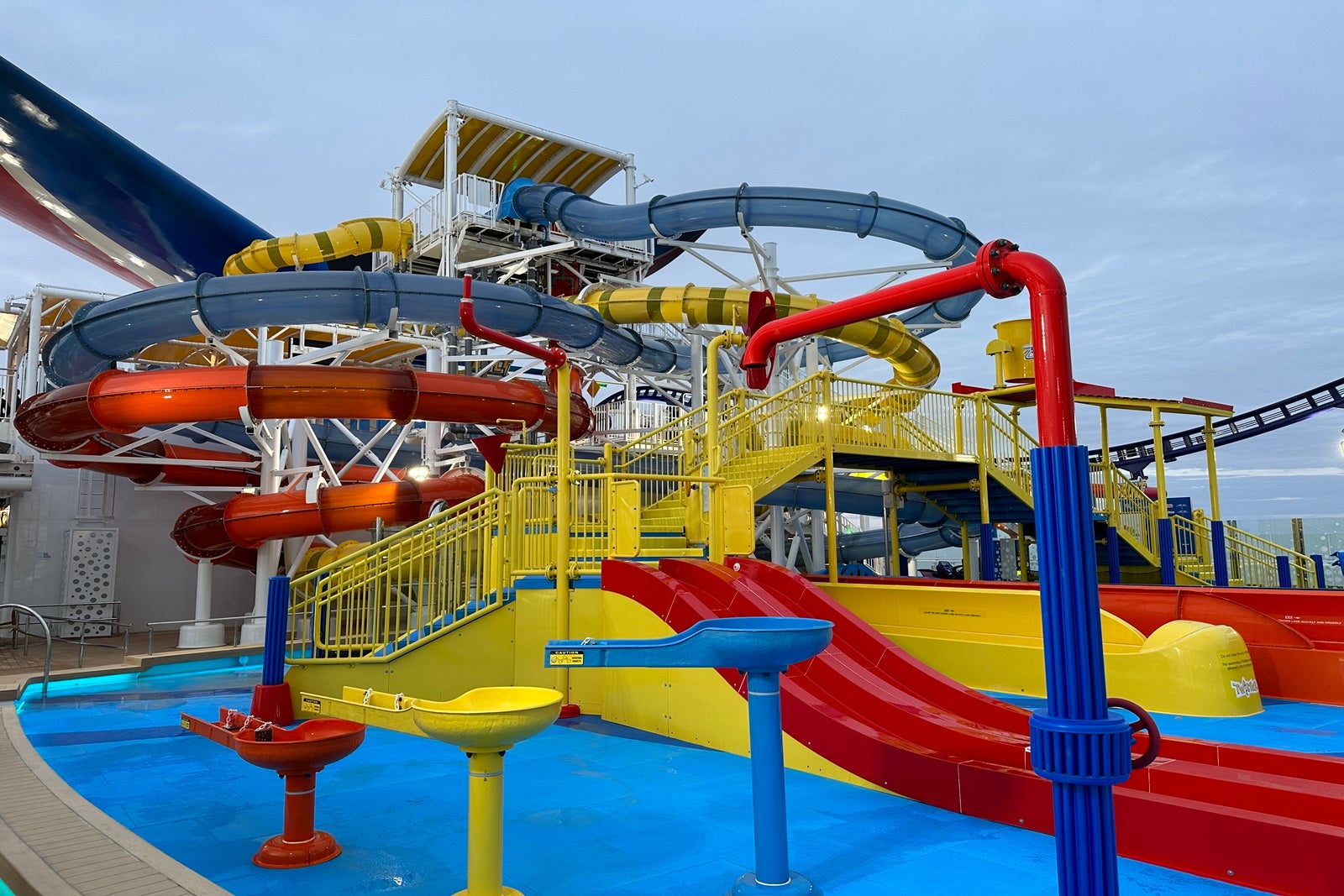
Tweens and teens have their own dedicated hangout spaces. Activities here are less structured, and participants can come and go as they please. Plus, an onboard arcade offers video games for a fee.
Carnival Jubilee shows
Entertainment on Carnival Jubilee is a combination of passenger favorites from other ships and new shows that you'll only find on this vessel.

Of the performances, I most enjoyed two main-theater shows that are also found on some other ships in the fleet. "Celestial Strings" is a mix of classical and modern pop instrumentals partnered with ethereal costumes and sets; "Soulbound" is a song-and-dance performance with a Victorian steampunk vibe, set in what feels like New Orleans, during which a soul-stealer tries to mess with a twisted love story.

Another excellent show is "Rio Carnival," which occurs at Center Stage in the Grand Central zone instead of the main theater. Although the first half felt a bit shaky and slightly boring to me, the second half redeemed it all, featuring a parade of dancers and aerialists dressed in flamboyant costumes synonymous with Rio de Janeiro's Carnival.

The ship's two new shows are just OK. The first, "Dear Future Husband," is a song-and-dance theater show with a plot that involves a couple taking their closest friends on a cruise for a combination bachelor/bachelorette party and wedding. Musical numbers befit the wedding theme and include Bruno Mars' "Marry You" and, of course, Meghan Trainor's "Dear Future Husband."
After the performance, a "reception" (read: dance party with a DJ and visits from the cast) is held in one of the ship's public areas. When I saw this show several months ago, the reception was in the Limelight Lounge. On this more recent voyage, Dr. Inks, Ph.D., served as the reception location.
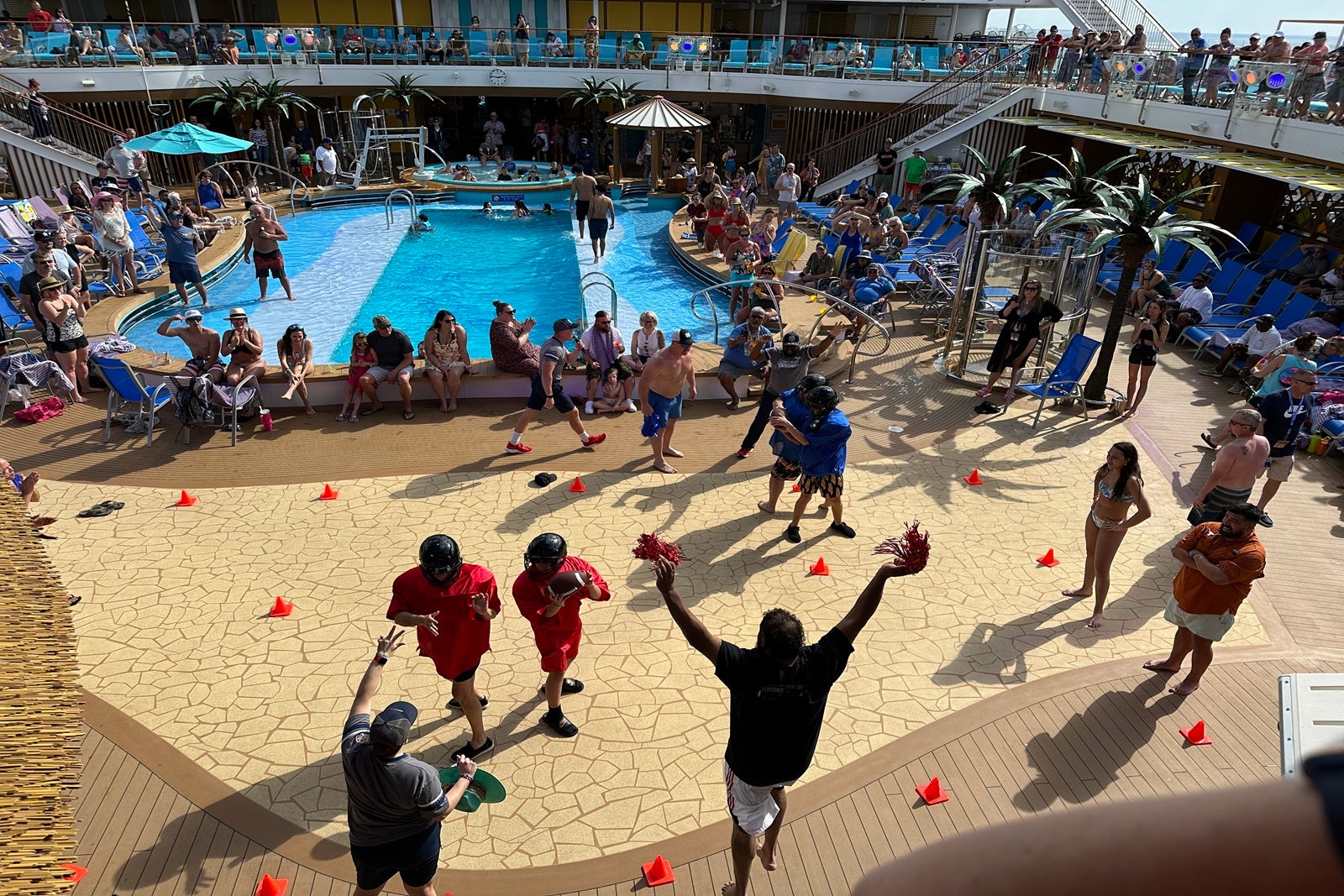
The second new show is the "Lone Star Tailgate." Drawing on Texas' love for all things football, Carnival has created four indoor/outdoor "quarters" of fun to mimic the four quarters of a football game. When I sailed, the first quarter, which is all about pool deck games for kids, was held on one sea day, and the other three were held on another sea day.
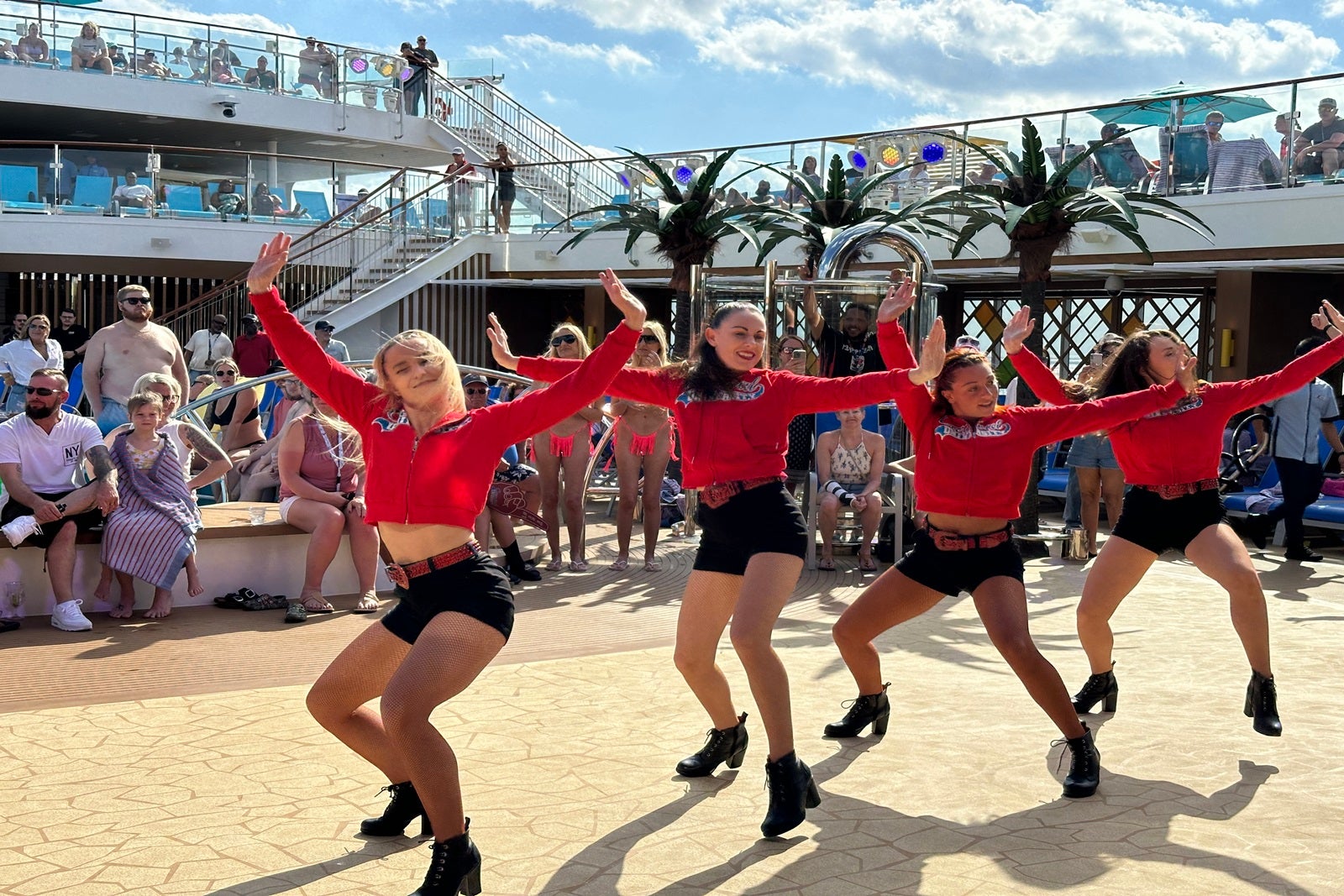
The second quarter involves pool deck games where passengers have to dress up in football gear to complete team races.
During "halftime," the ship's theater singers and dancers put on a show on the pool deck, dressed in team colors to support the fictional Carnival University — the team cruisers are supposedly cheering on during the festivities.
The third and fourth quarters occur in the Summer Landing zone; passengers can rope hay bales, participate in a hot wing-eating contest at Guy's Pig & Anchor Smokehouse Brewhouse and follow it up with music from a live band.
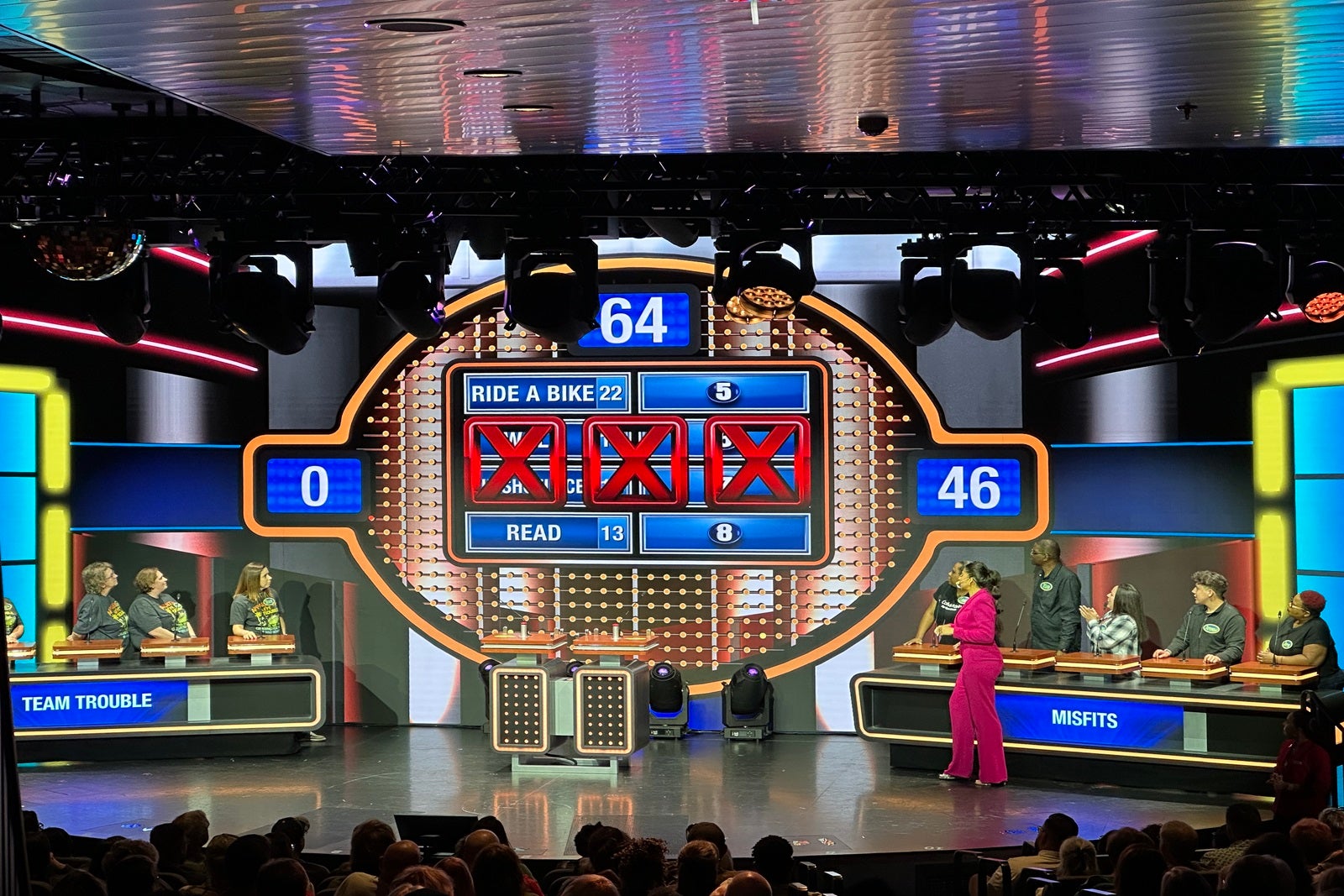
Don't miss the audience participation-style game shows like "Family Feud Live," "Deal or No Deal" and the "Love & Marriage Show." The first pits two family teams against one another to guess popular answers to survey questions; the latter tests couples to see how well they know one another, often resulting in hilarious answers.

Other entertainment during my sailing included several day and nighttime comedy acts, an absolutely phenomenal magic show (be sure to arrive at the Punchliner Comedy Club at least 30 minutes early or you won't find a seat) and "We Are One," a farewell show that focuses on togetherness.
Carnival Jubilee itineraries and pricing
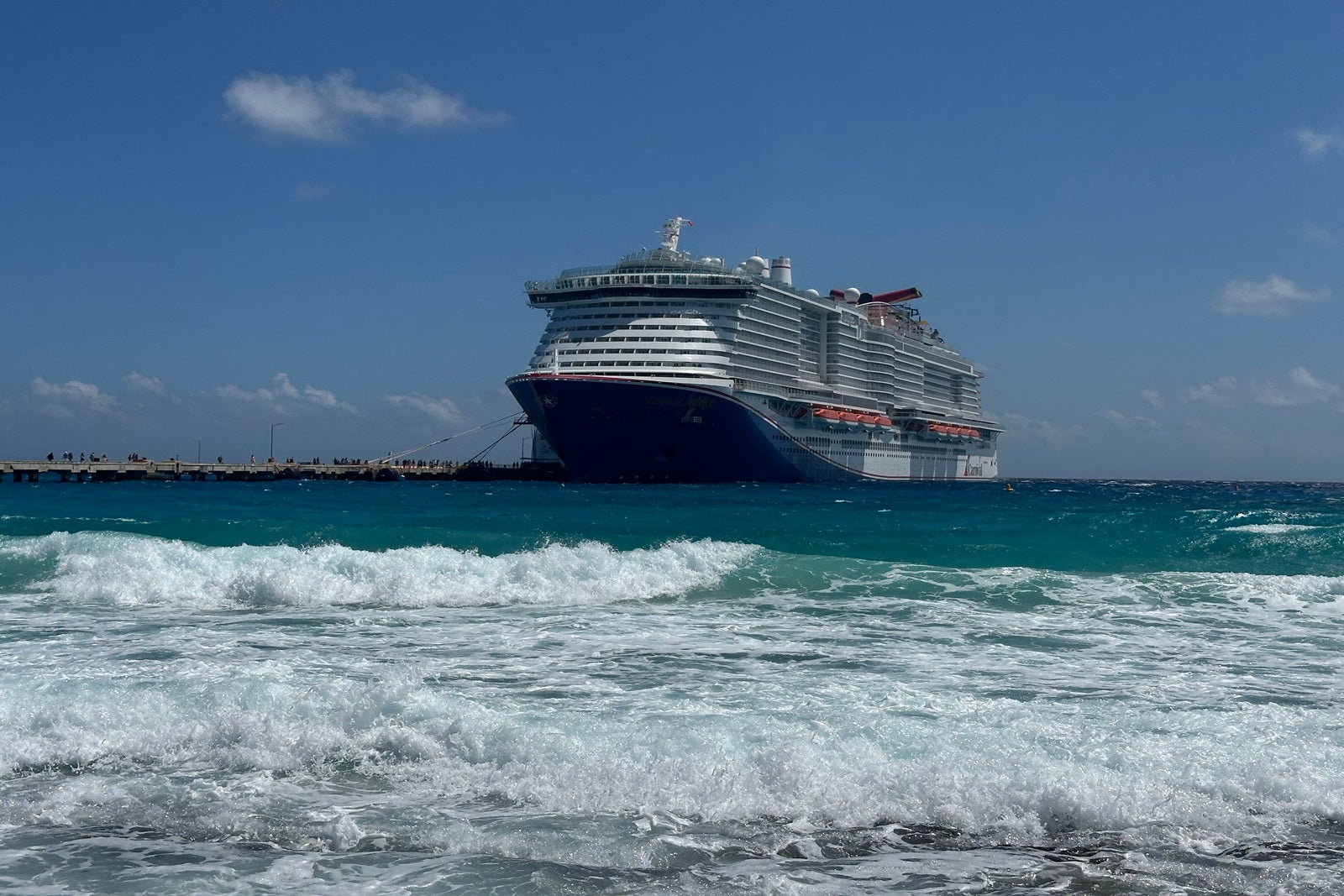
Through at least April 2026, Carnival Jubilee offers two seven-night Western Caribbean itineraries out of its Galveston home port on a regular rotation. Both types of sailings begin and end in Galveston and visit Mahogany Bay in Roatan and Costa Maya and Cozumel in Mexico with three sea days mixed in. The only difference between the two itineraries is the order in which the port calls and sea days occur.
At the time of publication, prices started from $709 per person ($101 per person per night) for an inside cabin or $919 per person ($131 per person per night) for balcony accommodations.
What to know before you sail on Carnival Jubilee
Required documents.
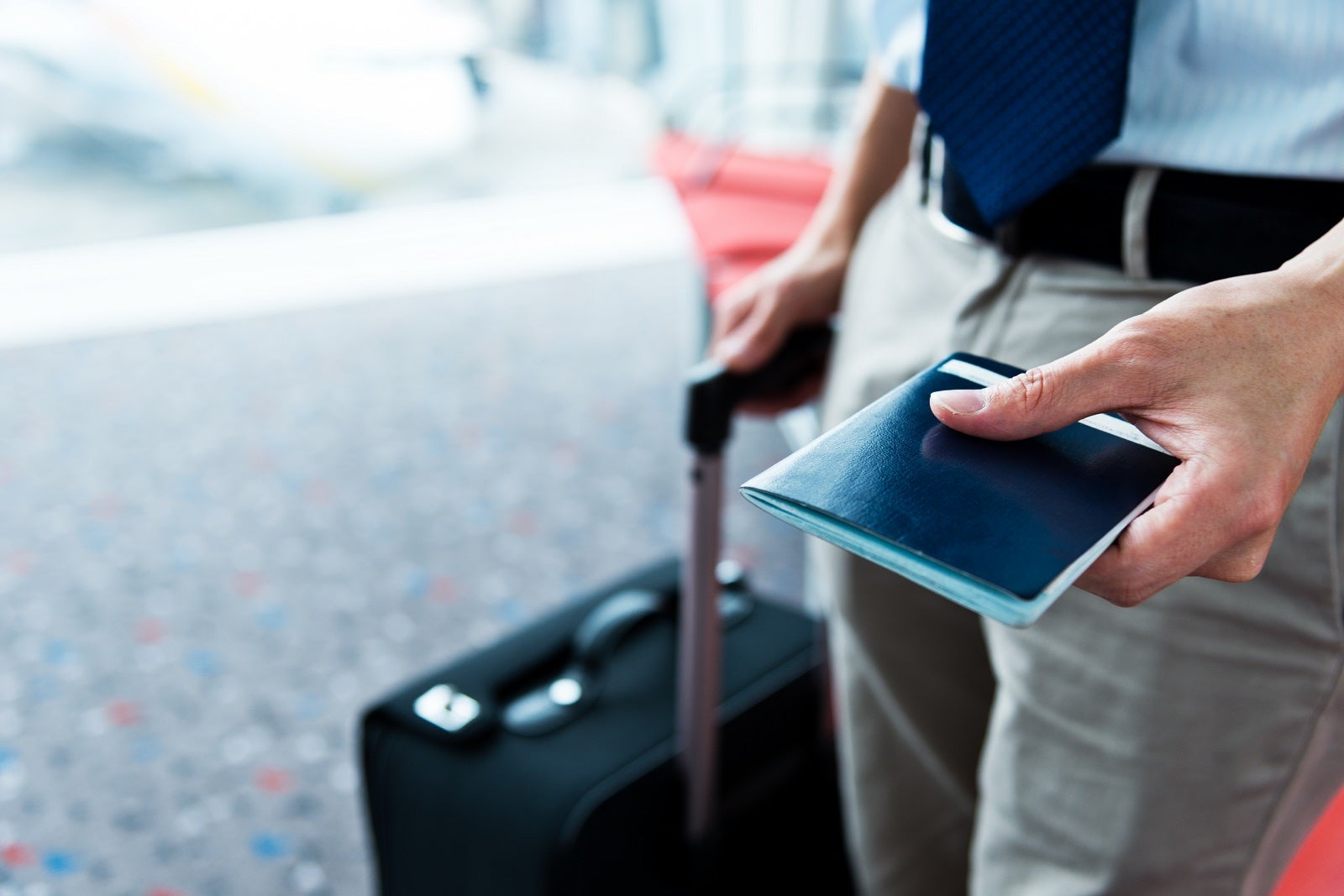
If you're a U.S. citizen on a cruise that starts and ends in a U.S. port, you'll need a current passport or an official copy of your birth certificate and a driver's license or other government-issued photo identification to sail. A few other forms of identification, such as a passport card, also are acceptable.
Passports must be valid for at least six more months. For cruises from international ports, you'll need a passport. Note that it is important that the name on your reservation be exactly as it is stated on your passport or other official proof of nationality. All this said, we recommend checking Carnival's website before sailing for up-to-date requirements.
Related: Which documents do you need for a cruise?
Carnival Jubilee passengers will automatically have $16 per person per day added to their onboard bills. Cruisers staying in suites will pay $18 per person per day. (Children younger than 2 are exempt from gratuities.) An 18% gratuity is also added to bar and cafe bills, spa treatments and the cover charge of the Chef's Table.
Related: Everything you need to know about tipping on cruise ships

Carnival Wi-Fi is generally fast and reliable, and Jubilee features StarLink connectivity. However, don't be surprised if you find yourself repeatedly and automatically disconnected, which is annoying.
Packages have increased significantly in price in recent years, and each plan is only for one device. (You can log out of one and into another with the same account, but you can't connect more than one simultaneously unless you buy additional plans.)
Three package tiers are available: Social (access to most social media and airline websites and apps for $18 per day or $126 for a weeklong cruise), Value (same as Social, plus access to financial and news websites and apps for $23 per day or $161 for a week) and Premium (everything from the Social and Value packages plus Skype access and video calling for $25 per day or $175 for a week). Passengers can also choose 24 hours of Premium access for $35.
Carnival claims that its packages don't allow FaceTime, iMessage or streaming from popular apps like Netflix and Hulu. However, TPG writers have had success using all of those services with the Premium package.
Carnival Jubilee is also the first ship in the fleet to offer 5G cellphone connectivity, which means faster speeds when you connect using your cellphone's plan. But be warned: If you don't have a special plan that allows you to connect at sea without roaming, you could be looking at hefty fees when you return. Generally, it's best to keep your phone in airplane mode when you sail.
Related: 5 things to know about cruise ship Wi-Fi
Carry-on drinks policy
Passengers can carry on one bottle of wine or Champagne per person (21 years and older); this will incur a $15 corkage fee for consumption in public areas. Each person can also bring up to 12 standard cans or cartons of nonalcoholic beverages like juice or soda. Alcohol-free drinks in plastic and glass bottles aren't allowed.
Related: Can I bring my own alcohol on a cruise ship?
Smoking policy

Smoking (including electronic cigarettes) is allowed but only in designated outdoor areas on Deck 8 mid-ship on the starboard side. Smoking is also allowed on the starboard side of the casino, but it's for cigarettes only. All types of smoking are forbidden in cabins and on cabin balconies.
Related: Cruise line smoking policies
Carnival Jubilee has self-service pressing rooms on decks 4, 5, 9, 14 and 15 with ironing boards and irons that are free to use. There are no self-service laundry facilities, though. Instead, passengers can send out their clothing for washing, pressing and dry-cleaning for a per-item fee.
Related: Everything you need to know about cruise ship laundry
Electrical outlets
Carnival Jubilee has standard North American 110-volt outlets in its cabins, as well as plenty of USB ports. In my balcony room, I had three standard outlets and four USB lightning ports by the vanity. There was also a USB port (non-lightning) on either side of the bed, just below the reading lamp.

The currency on Carnival Jubilee is the U.S. dollar. The ship also operates without cash. Passengers link credit cards to their onboard accounts or put up a set amount of cash to charge against, using their keycards as a means of making purchases. The only time you might want to have some bills handy is for tipping your room steward, bartenders, room service delivery people, luggage porters or shore excursion guides.
Drinking age
You must be at least 21 years old to drink alcohol on Carnival Jubilee.
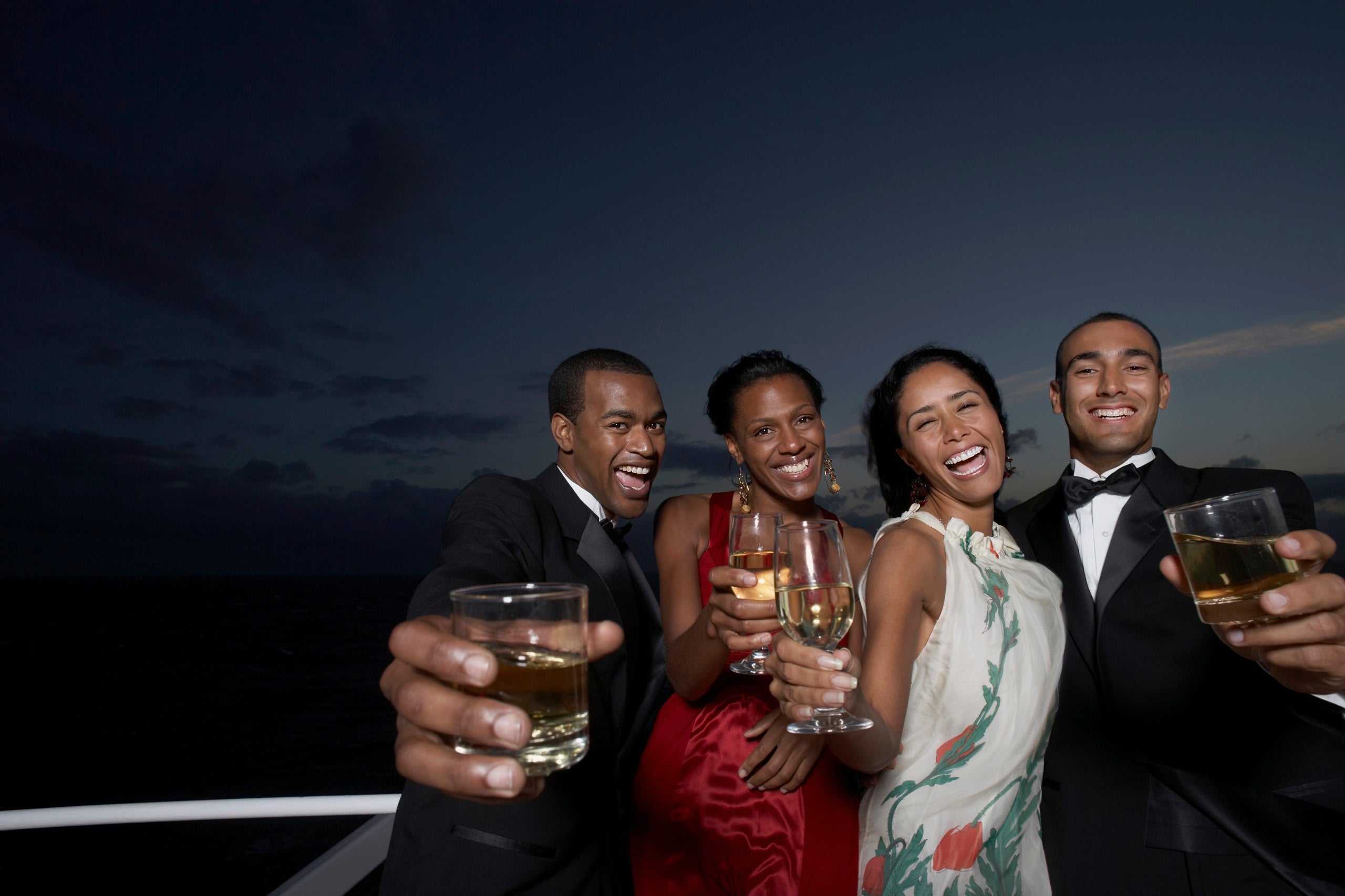
Carnival Jubilee does not have a specific daytime dress code, and people dress casually. If it's a sea day in a warm-weather destination, and you're bound for the top deck, T-shirts, shorts and bathing suits (with a cover-up to go inside) are just fine.
During the evenings, the official dress code is pretty laid-back. Most nights are designated "cruise casual," which means just that — khakis or jeans, polo shirts, sundresses and the like. Super casual items such as cutoff jeans, men's sleeveless shirts, T-shirts and gym shorts are supposedly not permitted, but I saw plenty of them in the dining rooms during dinnertime on Carnival Jubilee.
Each weeklong cruise will schedule two formal nights — known as "elegant nights." If you're bound for the dining rooms, men are expected to turn up in dress slacks and a dress shirt, preferably with a sports coat or even a suit. The suggested attire for women on such nights is cocktail dresses, pantsuits, elegant skirts and blouses. Passengers who wish to avoid dressing up can enjoy dinner in any of the casual eateries aboard.
Related: What to wear on a cruise – all about cruise line dress codes
Bottom line
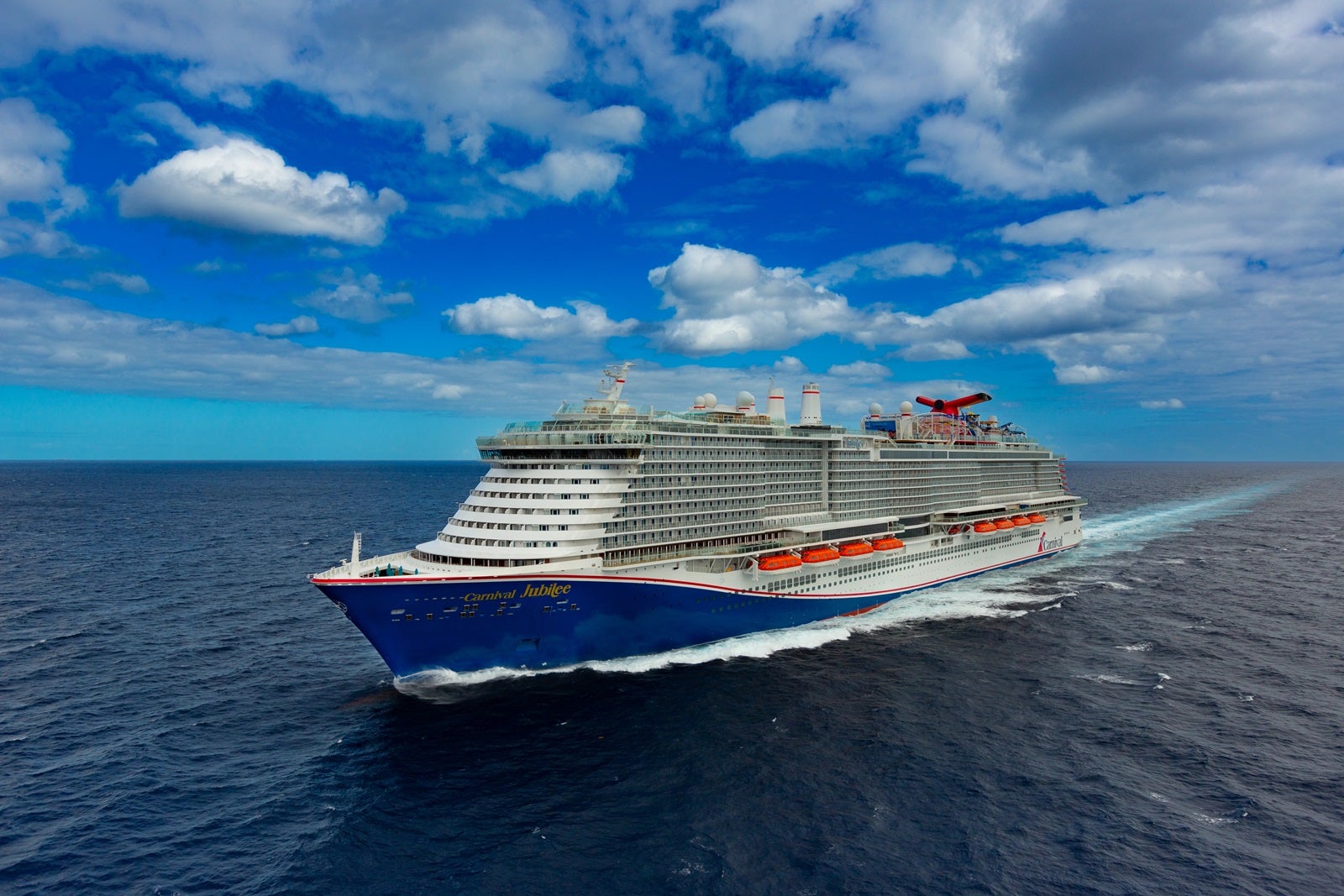
Sure, Carnival Jubilee carries a lot of people, and it can feel crowded and cumbersome to learn your way around at first.
However, it offers new ocean- and beach-themed zones, delicious food, creative cocktails, friendly crew members, comfy cabins, outdoor thrills, Texas charm and a marquee packed with fun daily diversions and nighttime shows. You'll find it's an affordable Caribbean vacation that speaks to just about any traveler who enjoys a large-cruise-ship experience.
Planning a cruise? Start with these stories:
- 5 ways cruise lines are nickel-and-diming worse than ever
- The 5 most desirable cabin locations on any cruise ship
- A beginners guide to picking a cruise line
- The 8 worst cabin locations on any cruise ship
- The ultimate guide to what to pack for a cruise
- A quick guide to the most popular cruise lines
- 21 tips and tricks that will make your cruise go smoothly
- Top ways cruisers waste money
- The ultimate guide to choosing a cruise ship cabin

The Best Cruise Cabin for Every Type of Need
C ruise accommodations—also known as staterooms or cabins—are a vacationers' home away from home while at sea. Far from a one-size-fits-all decision, there are numerous factors to consider when determining the best rooms on a cruise ship to fit your and your companions' needs.
From size to location to view and beyond, there are many things to keep in mind when selecting your stateroom, says Gianluca Corneli, hotel director at Royal Caribbean International. "How many will stay in the room? Is your room a place to hang out or just where you sleep?" Also, think about what you'd like to be near on the ship. "For example, consider if you would like to be near the elevator for convenience or prefer a location down the hallway with fewer guests passing by," she says. Also factor in any ways you'd like to elevate your stay, like maybe a balcony or a suite for your next Caribbean cruise .
It's no wonder that some of the best cruise lines offer up to 28 different types of rooms on a single ship—they want to ensure there's an ideal solution for every guest. Savvy cruisers already know all the best cruise tips , hidden cruise features and things you can't do on cruises . Now, let's focus on upgrading your room choice to the perfect fit for your specific needs.
Get Reader's Digest ’s Read Up newsletter for more travel, cleaning, humor, tech and fun facts all week long.
Best for avoiding seasickness
Choose: the middle of the ship, on a low deck.
Picture a ship like a seesaw—the most movement will be felt on either end, while the middle stays fairly even-keel. "Middle and low, that's where you want to be," says cruise expert Dori Saltzman, senior editor with trade publication Travel Market Report . "While you don't need to be on the absolute lowest passenger deck, you don't want to go above the middle of the ship (vertical wise). You also want to try to be as middle (horizontal wise) as possible."
If cabins in the middle of the ship aren't available, she says to choose aft over forward, because the more forward a cabin is, the more you'll feel the motion of the ocean. And while this may seem counter-intuitive, be sure to book a cabin with a window or balcony, so you can keep your eyes on the horizon if you start feeling queasy. Here's a list of what to pack for a cruise —which includes meds for seasickness.
Best for great views
Choose: a cabin with a balcony, preferably at the back of the ship.
While you can always go to the upper decks of any ship for 360-degree views of your surroundings, there's no greater cruise ship luxury than enjoying the scenery from your own private balcony. They may also be called veranda cabins. Balconies are the perfect place to enjoy a cup of coffee in the morning or glass of champagne during a spectacular sunset and pretend you're all alone at sea.
And some of the absolute best rooms on a cruise ship are located at the rear, where you'll also be treated to the photo-worthy wake left behind, which is a fun way to mark your ship's progress. Balconies are also nice for having access to fresh air when you want it, it can be very soothing to listen to the sounds of the ocean from your stateroom, and you'll have a better chance of spotting wildlife along your cruise too.
Best for light sleepers
Choose: a deck filled with other guest cabins and away from elevators.
Finding the best rooms on a cruise ship for light sleepers usually takes a little research, but that due diligence will pay off come bedtime. "You need your cabin to be located away from any bank of elevators, but also away from crew entrances," says Saltzman. So being surrounded by other cabins of people who want to sleep too is a safe bet. "You also don't want your cabin to be located above the ship's main theater, underneath any restaurants where you can hear the chairs scraping on the floor or under/over any of the lounges that have music late into the night."
Finally, you don't want to be on a low deck that's too aft or too forward, as you may end up above the engines or the anchor, which makes a lot of noise when it's lowered and raised. You may feel a bit like Goldilocks trying to choose that perfect cabin on your next romantic cruise , but the reward of peace and quiet will be priceless.
Best for a little more space
Choose: a forward-facing cabin.
While you aren't likely to find a balcony on a forward-facing cabin, you may find more interior space than similarly priced mid-ship cabins. Why? There are some odd angles in forward-facing cabins that the designers had to work around, thanks to the slanted style of the front of a ship. Those odd angles may work in your favor when it comes to square footage.
It's important to note that while these are some of the best rooms on a cruise ship for extra space, you will experience the most movement in a front-facing cabin, so this choice is not an ideal position for anyone prone to motion sickness.
Best for cruising with little kids
Choose: family-friendly suites.
Most cruise lines offer family-friendly cruises and specific cabins suited for kids, which can be a mix of in-room amenities and proximity to other areas of the ship children will love. "On Disney's ships, all cabins have two bathrooms, one with a sink and toilet and the other with a shower/tub combo (a small minority of rooms do not have the tub) for families that need the little one to be able to take a bath, while everyone else is still able to wash up," says Saltzman. "Another good option is the Family Harbor cabins on Carnival's Vista-class ships (Vista, Horizon, Panorama) and Excel-class ships (Mardi Gras, Celebration). Similar to the Disney cabins, these have two bathrooms, one a full one with a shower, sink and toilet, and the other with a sink and shower/tub combo."
Best for staying on budget
Choose: an interior cabin.
Unless you're worried about feeling claustrophobic—since there will be no porthole or window to the outside world—an interior cabin is a nice option for saving money (we're talking $300 for 7-day cruises). Not only is it the lowest-priced cabin type, which means you'll have more funds to put toward excursions, a drink package or souvenirs, but you'll also be able to take midday naps or sleep in later because there won't be any light sneaking in.
Another positive is that an interior cabin might encourage you to spend more of your free time roaming around the ship, meeting other people and getting more involved in activities, since you may not find it desirable to spend your time beyond sleeping and showering in a windowless box. These are the most affordable cruise lines for staying on budget in general.
Best for mobility disabilities
Choose: an accessible stateroom.
For passengers with limited mobility or no mobility, most major cruise lines offer accessible staterooms in a variety of room types (inside cabin, ocean view and balcony). These options do vary based on the cruise line and the age of the ship, so it's best to research this in advance and factor the accessible options available into your cruise planning process.
Accessible rooms tend to be larger than standard cabins to accommodate wheelchair or scooter users, and they also feature larger bathrooms. Additionally, some rooms will have emergency-call buttons or specific amenities for hearing or vision-impaired guests. For instance, the fully accessible rooms on Holland America Line provide adequate turning space, accessibility routes throughout the room, roll-in showers, wheelchair access on both sides of the bed, handlebars in the shower and hand-held shower heads, says Sissel Bergersen, director of rooms division, Holland America Line. Before you lock in a booking, it may be best to call the cruise line and explain your needs so they can help steer you toward the perfect cabin.
Best for being spoiled rotten
Choose: a cabin with butler service or a spa cabin.
For travelers who like adult-only cruises or who are yearning for a little extra pampering, the best rooms on a cruise ship fall into one of two categories. The first is a suite that comes with butler service, where you'll have someone helping with all the details you don't want to spend your precious vacation time tending to—like reserving prime-time dinner slots at specialty restaurants, booking shore excursions, packing and unpacking and even drawing rose petal bubble baths. Rooms at this level may also come with exclusive access to private pools, clubs and lounges with more luxurious touches and solitude than you'll find elsewhere on the ship.
The other category that's becoming increasingly popular is spa suites. On Norwegian Cruise Line, the Haven Spa Suite, Spa Club Balcony Suites and Spa Balcony (available on the Norwegian Escape, Norwegian Bliss and Norwegian Epic) have varying amenities that range from more tranquil room décor with an oversized shower and body spray jets to priority access to Mandara Spa. And on Celebrity Cruises, the AquaClass staterooms are focused on wellness, with a pillow menu, complimentary fitness pass, preferential rates on spa packages, healthy room-service menu options, an exclusive restaurant, a spa concierge, access to the SEA Thermal Suite and a yoga mat for use onboard.
Best for solo cruisers
Choose: a cruise line that offers single rooms or waives single supplements.
Solo cruises are a wonderful experience, yet so many cruise lines penalize single cruisers by forcing them to pay a "single supplement." This surcharge is added to the fare of a solo passenger, since cruise room pricing is generally based on double occupancy. This fee can be an additional 10% all the way up to a full 100% of the rate, making solo cruising unaffordable for many travelers.
Instead, look for cruise lines that offer single staterooms, like Celebrity, which has the Edge Single Stateroom with Infinite Veranda (available on Celebrity Edge, Celebrity Apex, Celebrity Beyond and Celebrity Ascent) and the Single Inside Stateroom on Celebrity Silhouette. Other cruise lines, including Holland America Line, Royal Caribbean and Norwegian Cruise Line, also offer single cabins—these special solo and studio cabins aren't subject to single supplements. Occasionally, you may even find cruise lines running special promotions and waiving their single supplement for a regular-size room.
- Gianluca Corneli, hotel director at Royal Caribbean International
- Dori Saltzman, senior editor at Travel Market Report
- Sissel Bergersen, director of rooms division for Holland America Line
The post The Best Cruise Cabin for Every Type of Need appeared first on Reader's Digest .
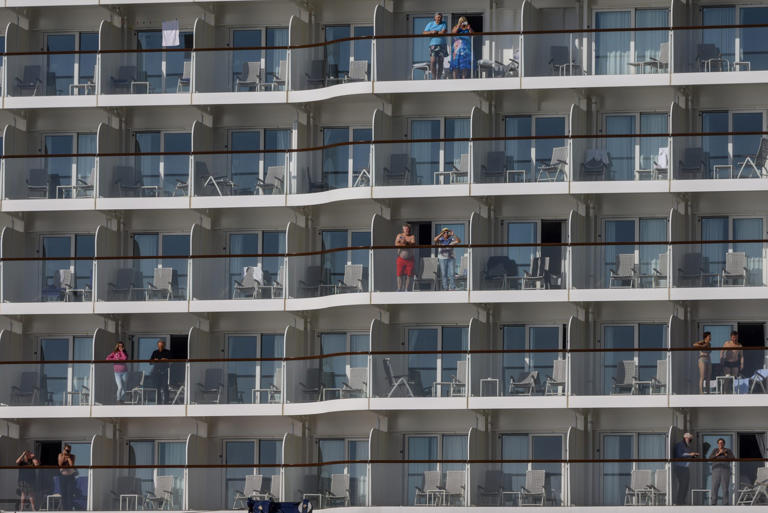

The Anatomy of a Cruise Ship Anchor Chain
While it may seem like a relatively simple piece of equipment, a cruise ship’s anchor is a marvel of modern engineering. When you consider the incredible size and weight of a modern-day cruise ship, you begin to realize what an incredibly difficult task is to ensure they are secured in place while they are in the harbor.
Today, we will take an in-depth look at cruise ship anchor chains. Not only will we break down how they work, but we also explore what they are made from, the various components of the chain, and the incredible engineering that goes into ensuring that they can hold a cruise ship in place.
So, if you are ready to learn everything you need to know about a cruise ship anchor chain, let’s get started!
In This Article:
What is a cruise ship anchor chain.
While it may seem pretty self-explanatory, a cruise ship anchor chain plays a complex and incredibly important role in ensuring the overall safety of a cruise ship voyage. These massive chains need to withstand the incredible forces exerted on the cruise ship’s anchor when the cruise ship is in the harbor.
To withstand the immense pressure generated by holding a heavy cruise ship in place against tides, waves, and ocean currents, the anchor chain and cables need to be immensely strong, and incredibly flexible. The individual chain links look just like any other type of chain, but they are on a massive scale.

Each link in the chain is made from high-grade steel with incredible tensile strength. While the chain size will vary depending on the size and weight of the cruise ship, they are all incredibly large and heavy.
Read Also: What is the Draft of a Ship?
In some cases, the waters the cruise ship traverses can also be a factor when determining how large the anchor chain needs to be. For example, large ships that traverse deep waters with strong currents need a much larger anchor and anchor chain than small boats on shallow water that stay close to the coastline.
What Is the Anatomy of a Cruise Ship Anchor?
The traditional anchor chains of a cruise ship may seem like they have a relatively simple design, but they are made up of many different parts, which all have to be made to an extremely high standard.
Here are the main components of a cruise ship anchor chain:
The Chain Links
The most prominent component of a cruise ship anchor chain is the series of interconnected links that make up the bulk of the chain. These links are massive in scale, and they need to be constructed of high-tensile, high-strength steel.
The chain design allows for the perfect combination of strength and flexibility, which is necessary when holding a heavy anchor in place against the tremendous forces of a large body of water and heavy vessels.

Each link in the chain will look like an elongated oval, or it can be designed to have more of a “D” shape. These two shapes allow the chains to be connected in a way that maintains their strength but can still move smoothly.
All links within the chain are also designed to be the exact same size. They also need to be precisely spaced so that each link has the same freedom to move as the next. If this was not the case, dropping and retrieving the anchor would be much rougher. The chain could also become damaged over time.
The Joining Mechanism
The individual links within the chain are joined together using a detachable mechanism. Basically, this mechanism consists of a connector and an anchor shackle.
Not only does this make it possible to put the chain together, it also makes it possible to remove damaged or corroded links within the chain without completely replacing the entire anchor chain.
Depth Markings
Most cruise ship anchor chains also feature depth markings at evenly spaced-out intervals. These allow crew members to easily determine how much of the chain has been released by the anchor windlass. Typically, these markings are made with bright, scratch-resistant paint; however, they can be made by stamping impressions into the metal.

To learn more about the anchor of a cruise ship, rather than just the chain that connects it to the ship, we recommend reading about how big a cruise ship anchor is . This straightforward guide explains how big these enormous anchors need to be and provides other helpful information on how modern anchors work.
How Much Do Cruise Ship Anchor Chains Weigh?
As mentioned, the anchor weight, chain length, and size of a cruise ship’s chain can vary depending on the weight and dimensions of the cruise ship itself.
That said, the general range for a single link of the anchor’s chain tends to be between 11 lbs (5 kg) to about 290 lbs (130 kg). The longer the chain length, the more it weighs.
Worth Reading: How Much Does a Cruise Ship Weigh?
With individual links weighing so much, the anchor chain’s overall weight can easily be measured in tons. When you think about the weight of a cruise ship and the immense forces sea and ocean water can exert, it only makes sense that the chains need to be incredibly heavy.
What Is a Cruise Ship Anchor Chain Made Of?
Cruise ship anchor chains need to be made from high-strength steel. Steel is the only suitable choice, as it offers the durability and strength required to withstand such immense forces. The high-strength steel alloys used to make these enormous anchor chains are also resistant to corrosion caused by lengthy exposure to saltwater.

To enhance the corrosion resistance of the anchor chain, most are given additional coatings and surface treatments to enhance the anchor chain’s corrosion resistance. Galvanization and various types of specialized coatings are used for the individual links of the anchor chain.
These surface treatments can not only delay corrosion, they can also help prevent scratching as the chain links rub against each other and even the hull.
Why Do Cruise Ship Anchor Chains Need to Be Flexible?
Not only do cruise ship anchor chains need to be heavy, strong, and incredibly durable, they need to be flexible. Flexibility is essential for the following reasons:
The Ability to Move with Currents, Tidal Changes, and Swell
Even when a cruise ship is anchored in a harbor, the anchor chain must be capable of adjusting to fluctuations in water conditions. The tide can change the depth of the water rapidly, so if the chain is not flexible, it would be under much more tension.

This could damage the anchor and the ship itself. By remaining flexible, the anchor chain can also absorb sudden forces caused by large waves and storms.
Noise and Vibration Reduction
A flexible anchor chain creates far less noise when the ship moves. For passengers to have a more comfortable experience while they are on board the ship, flexible anchor chains reduce creaks and other noises that could be disturbing.
Flexibility Makes it Easier to Drop and Retrieve the Anchor
The chain’s flexibility is essential when it comes to dropping and retrieving the anchor. When the anchor is dropped or lifted, the chain flows through a chute on the side of the ship’s bow.

Flexibility Allows the Anchor to Adjust to Differing Seabed Depths and Compositions
As you may know, a seabed in one area can differ in composition from one area to the next. While some are sandy and easy for an anchor to dig into, others are uneven and rocky. By having a strong but flexible anchor chain, the anchor can have a much more stable hold.
Frequently Asked Questions (FAQs)
What is the biggest cruise ship anchor chain in the world.
Currently, the world’s largest anchor chain belongs to the Oasis Class cruise ships owned and operated by Royal Caribbean International. These anchor chains weigh between 130 and 160 tons!
Do cruise ship anchor chains ever break?
Although extremely rare, cruise ship anchor chains have been known to break. Typically, this is due to corrosion and long-standing exposure to salty seawater. Overloading the anchor chain by dropping anchor in rough seas can also cause wear and tear. Eventually, this damage could result in the chain breaking.
Read about an anchor lost after getting stuck near San Juan for an example of how and why large vessels could be forced to cut its anchor loose.
How often are cruise ship anchor chains inspected?
While the exact frequency of inspections will depend on the particular policies of each cruise line, most anchor chains are inspected as part of the cruise ship’s regular inspection and maintenance procedures. This means a visual inspection usually occurs before each voyage.
More in-depth inspections are typically conducted at least once a year. During these inspections, each chain link is checked for signs of damage and corrosion. As you would expect, the frequency and closeness of inspections can increase if the crew suspects that the anchor chain could be damaged.
Final Words
While casual cruise-goers often overlook them, there is an incredible amount of engineering that goes into making and maintaining a cruise ship anchor chain. Not only is the scale of the individual links impressive, but the ability of the chain to withstand immense forces is also truly a marvel of maritime engineering.
Related Posts
Leave a reply cancel reply.
Your email address will not be published. Required fields are marked *
Woodfibre LNG 'floatel' permit rejected by Squamish council
Floating temporary worker accommodation proposed as part of lng facility construction near squamish.

Social Sharing
The District of Squamish council voted to reject a one-year temporary use permit (TUP) that would clear the way for Woodfibre LNG to use a renovated cruise ship to house over 600 workers in Howe Sound.
The motion to permit the so-called "floatel" failed by a 4-3 vote. Councillors who voted against the plan cited safety concerns, environmental and community impacts, as well as a lack of information from the company.
"I am very concerned about the amount of risk we are opening ourselves up to," Coun. Lauren Greenlaw said.
"At the very least we need a deferral of the TUP to discuss outstanding issues — we need a bigger bond, hazard assessments. We need a waste management plan."
The floating temporary accommodation has been proposed as part of the natural gas liquefaction and export terminal construction project that is already underway on the former site of the Woodfibre pulp mill.
When complete, the facility will produce 2.1 million tonnes of LNG per year for overseas markets, according to the company's website.
- 'Floatel' ship arrives in B.C. to house LNG workers, but local permit still needed
In a statement to CBC News, Woodfibre LNG president Christine Kennedy said she was disappointed with council's decision.
"The District has asked repeatedly since 2019 — to the company and to regulators — that the Woodfibre LNG project workforce be housed outside Squamish, which is exactly what the floatel delivers," Kennedy said.
- Work camp for new B.C. energy project raises safety concerns for Indigenous women and girls
"In a community that welcomes tens of thousands of visitors each year, the rhetoric of some council members directed toward the skilled craft workers that will make up the project's workforce seems out of place ... If these people visited as tourists, they would be welcomed."
The Woodfibre facility has approvals from the B.C. and federal governments, as well as the Squamish Nation.
Tracey Saxby, executive director of the advocacy group My Sea to Sky, was pleased with council's decision.
WATCH | Squamish residents divided over new 'floatel' plan

Squamish residents divided over new “floatel” plan
"Last night was the first time that a government regulatory body actually listened to the community," Saxby told CBC's The Early Edition .
"The provincial and federal regulatory processes have failed us and it was left to local government to stand up and listen to the community. I'm really grateful for the local leadership that was shown."
About 200 people attended a public meeting last week and hundreds more submitted comments online, with the majority voicing opposition to the floatel.
Squamish Mayor Armand Hurford proposed a motion to approve a one-year temporary use permit with the possibility of one three-year renewal, rather than an initial term of three years.
He said the floatel's performance over the first year would provide clarity for the renewal discussion, but the motion was rejected.
In an email to CBC News, Hurford described the Woodfibre LNG project as a "major challenge" for the community.
"Our continued request has been for joint planning and we hope that everyone involved understands the importance of this request," he said in the email.
"We hope anything that comes to us going forward has an increased level of co-operation and alignment so that we can understand the entirety of what's proposed and that these issues can be considered in a more holistic approach."
- With files from Chad Pawson and The Canadian Press
Related Stories
- Top stories from British Columbia
- Tourism groups worry as B.C.'s short-term rental rules change
- Reena Virk killer claims TV series based on crime 'disrespectful'
- London Drugs stores remain closed after 'cybersecurity incident'

IMAGES
VIDEO
COMMENTS
Cruise ship anchors can be up 15ft to 20ft in height and 10ft to 15ft wide. Anchors are generally proportional to the size of the cruise ship. The larger and heavier the cruise ship, the larger the anchor can be expected to be. The largest oasis-class Royal Caribbean cruise ships are some of the largest in-service ships sailing today and can be ...
As you can see, the size is similar, although the shape of cruise ship anchors has changed quite a lot over the past 170 years. How Long Is The Anchor Chain On A Cruise Ship? Anchor chains are measured in lengths called shackles. One shackle of the chain is 15 fathoms long, this equates to 90 feet or approximately 27 metres.
The majority of boats and ships do but with the vast size of cruise ships are anchors needed in the same way? ... Cruise Ship Anchor Impact in 2020 and 2021. Due to the 2020 cruise industry shut down a number of cruise ships had to anchor out to sea for long periods of time. The long lengths of time that the ships would be at sea meant that ...
Cruise ship anchors range between 10-20 feet long and average 8-15 feet wide. An anchor's size is directly proportional to the size of the vessel. Larger and heavier ships require larger and heavier anchors. The Titanic had an 18 foot 6 inches long main anchor, and it was the largest anchor made at the time.
The normal size of a cruise ship anchor is 8 to 15 feet wide, with a length of 10 to 20 feet. The size of an anchor is closely correlated with the size of the vessel. Larger and heavier ships need anchors that are also larger and heavier. The main anchor aboard the Titanic was the longest anchor ever manufactured at the time, measuring eighteen ...
Cruise ship anchors are much larger than you think, especially considering what an important part they play in the vessel's stability. They are typically 10 to 20 feet long, 15 to 20 feet wide ...
While it may seem like a relatively simple piece of equipment, a cruise ship's anchor is a marvel of modern engineering. When you consider the incredible size and weight of a modern-day cruise ...
The size of an anchor on a cruise ship can vary depending on the size of the vessel. A standard-size cruise ship will typically have an anchor that weighs between 10 and 15 tons. These anchors are made from cast iron, steel, or aluminum and can measure up to 85 feet in length. The larger anchors are often equipped with flukes, which are sharp ...
Much to our surprise, the weight recommendations for the new designs, Rocna, Excel, Supreme, etc. are very similar to the weight recommendation for the older, traditional models, CQR, Delta, Bruce etc. In both cases, the recommendation for a 35-foot yacht is approximately a 30-pound anchor. The exceptions are aluminum anchors from Fortress and ...
Cruise Ship Anchors - Function, Size, Weight, and Uses. Hey hey hey, I'm Emma and I LOVE cruising! I took my first cruise when I was 11 and I've been hooked ever since. I create cruise content across YouTube, this website and my social accounts, all with the aim of helping you to find, and take your perfect cruise.
At one time, though not the strongest option for a given link size, BBB was the most popular anchor chain because it's specifically calibrated for windlasses. But its primary attribute is its weight. A 100-foot length of 3/8-inch BBB weighs approximately 165 pounds, while identical lengths of HT and PC weigh 153 and 140 pounds, respectively.
SS Stevens anchor windlass on the former cruise ship's main deck. Photo: Wjwalrus, CC BY-SA 3.0 via Wikimedia Commons. ... There is no "standard" size anchorage because ships are assigned based on the space that they need in order to avoid colliding with adjacent anchored vessels. At the Ports of Los Angeles and Long Beach, the nautical ...
An anchor is an important component of a cruise ship's design. It is used to hold the ship in place while it waits for passengers to disembark or embark, or when the ship is docked at a port. The size of an anchor on a cruise ship can vary depending on the size of the vessel.
Anchor Weight. Anchors are typically sized by weight, ranging from a few pounds for small vessels to several hundred pounds for large yachts. The rule of thumb is that the heavier the boat, the heavier the anchor should be. However, it's important to consider the type of anchor you're using, as the holding power varies across anchor designs.
The anchor chain on a cruise ship can be quite long, depending on the size of the ship. On smaller ships, the anchor chain may be as short as around 60 feet, while larger ships may have an anchor chain that is over 200 feet long. The length of the anchor chain is determined by several factors, such as the size of the vessel, and how deeply it ...
The weight of a cruise ship anchor is typically measured in tons and can range from several tons to over ten tons, depending on the size and type of the vessel. The weight is primarily influenced by the size and design of the ship, as well as the expected water depth and seabed conditions encountered during the voyage.
Cruise ship size comparison. In our huge table below there's a list of all most famous, ever best passenger cruise ships sorted by name. This survey also offers smaller cruise ships size comparison of top luxury all-inclusive vessels with gross tonnage even lesser than 5,000 GT. Now the list of all ship sizes related and integrated articles:
As mentioned, the anchor weight, chain length, and size of a cruise ship's chain can vary depending on the weight and dimensions of the cruise ship itself. That said, the general range for a single link of the anchor's chain tends to be between 11 lbs (5 kg) to about 290 lbs (130 kg).
The size and shape of a ship's anchor can also vary depending on the vessel's intended use. For example, a ship that is designed for fishing or research purposes may use a grapnel anchor, which features multiple hooks that can better hold the vessel in place in shallow waters. Alternatively, a larger cargo vessel may require a more ...
#Anchor #shipanchor #windlassAnchoring is one of the very frequent operations onboard ships. A number of variables and external factors influence the duratio...
Anchors and chains for ships and moorings. Anchors for marine, construction, fishing, and oil industry. ... SIZES NORMALLY IN STOCK RANGE FROM 3000 TO 10,000 LBS. KEDGE ANCHORS "FISHERMAN'S ANCHOR" OR "OLD STYLE ANCHOR" ... 1000 LB Baldt type stockless anchor with 10 feet of 1-3/4″ stud link anchor chain! WORKBOAT (8-30,000 LBS ...
Divers recently captured this troubling clip of a luxury cruise ship anchoring off the Caribbean's Grand Cayman - and damaging an ancient coral reef in the process.
Erickson is also the owner of Homer Tours, Inc. and has worked with the cruise ship industry since 1995. "Back in the mid-2000s … (Homer) marketed for smaller cruise ships that could land at our dock," Erickson told Homer News on Saturday. "We knew we had the infrastructure to handle those sizes of ships and do a good job.
Carnival Jubilee offers the same ride — the third of its kind on a cruise ship — in the deck 18, 19 and 20 Ultimate Playground area. ... The sizes of the performance venues are generally way too small for the number of passengers wishing to watch the shows. ... I also missed Guy's Pig & Anchor Smokehouse Brewhouse, another Guy Fieri ...
While you can always go to the upper decks of any ship for 360-degree views of your surroundings, there's no greater cruise ship luxury than enjoying the scenery from your own private balcony ...
First, Diamond passengers get access to the Crown Lounge, a room on the ship that serves a continental breakfast, snacks and appetizers at 5 p.m. It also has a fancy coffee maker that operates 24/7.
As mentioned, the anchor weight, chain length, and size of a cruise ship's chain can vary depending on the weight and dimensions of the cruise ship itself. That said, the general range for a single link of the anchor's chain tends to be between 11 lbs (5 kg) to about 290 lbs (130 kg).
Squamish District council votes 4-3 against allowing a cruise ship renovated to house more than 600 Woodfibre LNG workers to anchor in Howe Sound.
Normal text size Larger text size Very large text size. ... Submersibles on cruise ships, while glamorous and providing guests with unbeatable boasting rights, do have their downsides, not least ...